AN INTERNATIONAL QUARTERLY FOR THE MODERN ANGLER


Autumn : OctDec 2023 Vol 03 No.01 £8.99/€10.26 Vol 03 : AprilJune 2024 Flyfishing Journal INSIDE: Silver Linings
Fishing the Falklands • Cook Your Catch
•

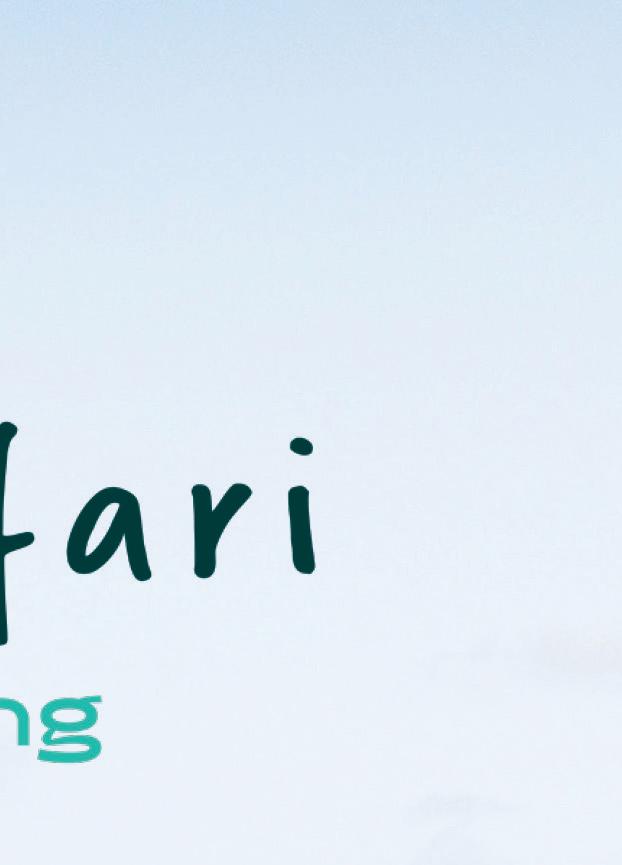





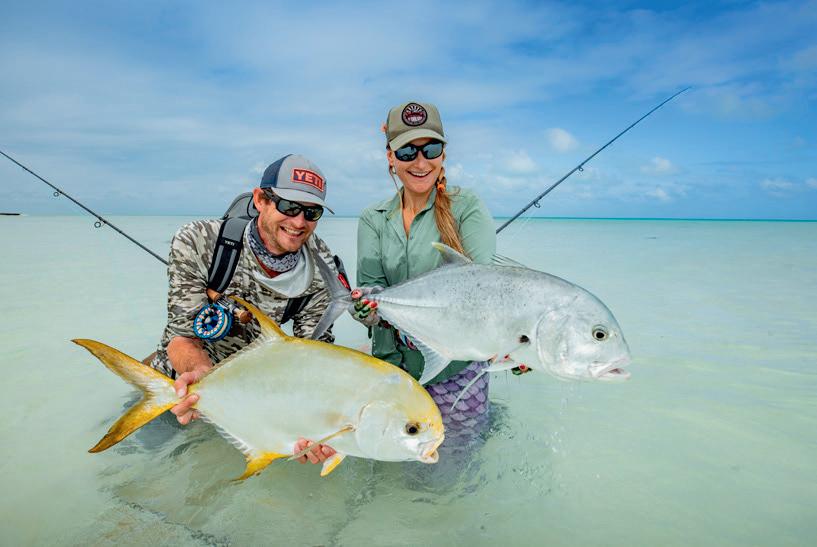


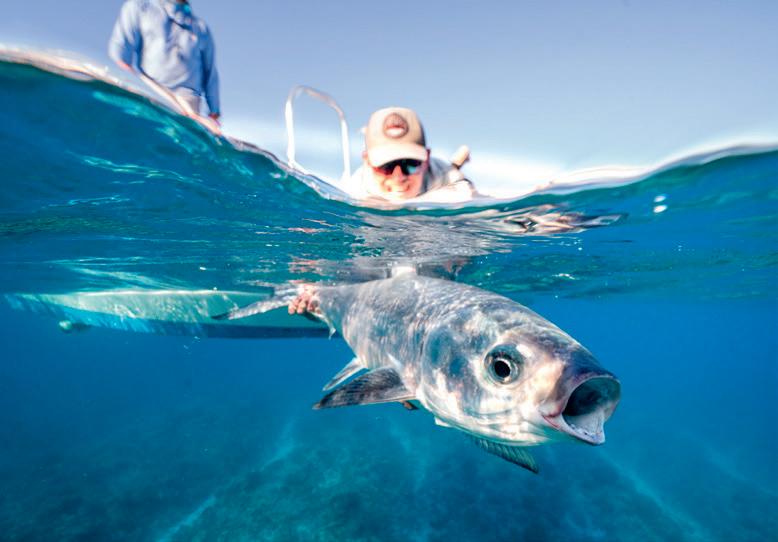




Alphonse Island | Cosmoledo Atoll | Astove Atoll | Farquhar Atoll Providence Atoll | Amirante Islands | Platte Island +248 422 9700 [GMT+4] | reservations@alphonsefishingco.com | www.alphonsefishingco.com Home of the world’s best saltwater fly fishing

Flyfishing Journal is published quarterly, you will receive a free set of flies with each new subscription. Visit www.Flyfishingmedia.co.uk or scan the QR code to start your subscription. Enjoy! Cover: Refl

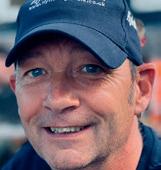




You can receive your personal copy of Flyfishing Journal directly to your home.
Rob McGinlay - Director/Publisher J 07917 777721
M Rob@nousmedia.co.uk
Saara Rootes Director/Publisher M Saara@nousmedia.co.uk
Ceri Jones Editor
M Ceri@flyfishingmedia.co.uk
David Guest Deputy editor
M editorial@nousmedia.co.uk
Nicola Howe Designer | For full list of contributers see pages 88-89 FlyFishing Journal @flyfishing_nousmedia Nous Media Limited 84 Colchester Road Manningtree, Essex, CO11 2BH D www.nousmedia.co.uk No parts of this magazine may be produced or transmitted in any forms without prior permission from the copyright owner.


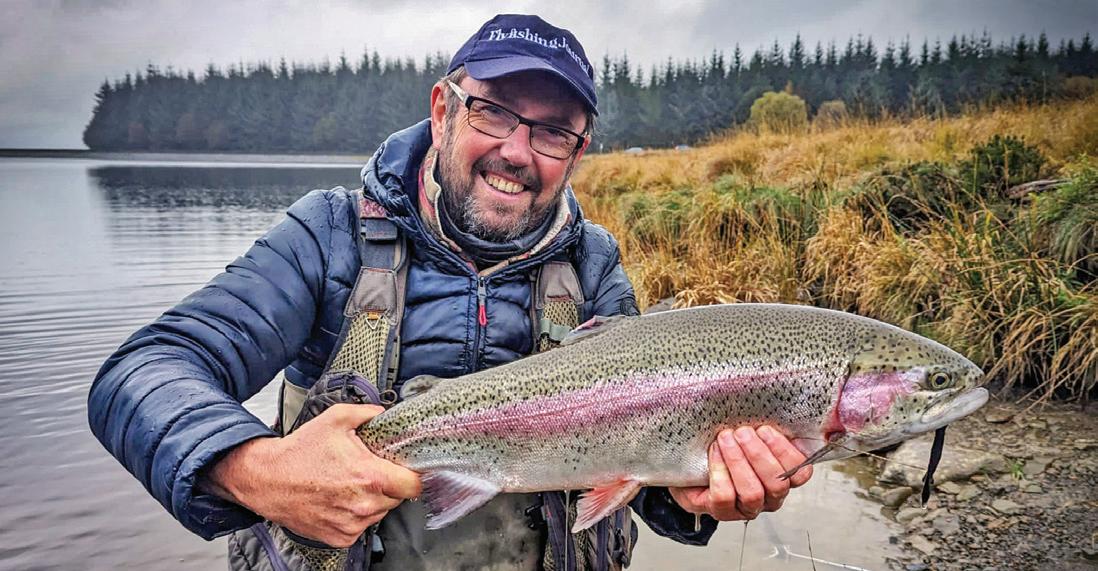
Even though the season is underway it has been a disjointed a air for most of us. I can’t remember a wetter start to any season. Rivers have been in ood for most of March into the beginning of April and many of us have ooded banks on our lakes and reservoirs. Hopefully as the weeks go on this will change and we can enjoy shing the hatches we have been eagerly waiting for.
I love this time of year, it’s when everything comes together with nature giving us signs that the cold months are long gone and summer is on the way. Seeing the hawthorn and gorse come into bloom and the sound of the visiting cuckoo calls is a sign I need to be out on the water. We have been waiting so long for this that sometimes if you don’t get out it in April and May it can run away quite quickly. I love the lighter nights, drawing out with the anticipation of some great buzzer activity. en for me the cream of our sport is shing dries from a drifting boat covering feeding sh in the wave engul ng the May y which are hatching o . Exciting days ahead!
I want to say a massive thank you to our readers and all the encouraging positive feedback we regularly receive about the Journal. I hope you enjoy this issue as much as we have putting it together. We have great features from our team of top contributors from rivers to reservoirs, trout and salmon, innovative y-tying, Irish Loughs and some great destinations to whet your appetite. Plus, this issue we see the rst of a new series from sh whisperer and master chef, Andrej Urosevic showing us some tasty recipes to try out with your hard-earned catches.
I wish you all tight lines for the coming months and don’t forget the issue is also now available as a digital download, plus please remember to send us your catch photos.
Ceri Jones
M ceri@ y shingmedia.co.uk
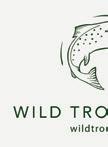


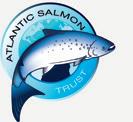

3 flyfishingmedia.co.uk
Flyfishing ISSN 2754-6020
© Nous Media Ltd
ephemera
OFFICIAL TRADE SUPPORTER OFFICIAL TRADE MEMBER OFFICIAL SUPPORTER OFFICIAL MEDIA PARTNER
ections of a green drake mayfl y or
danica Photograph by Ceri Jones.

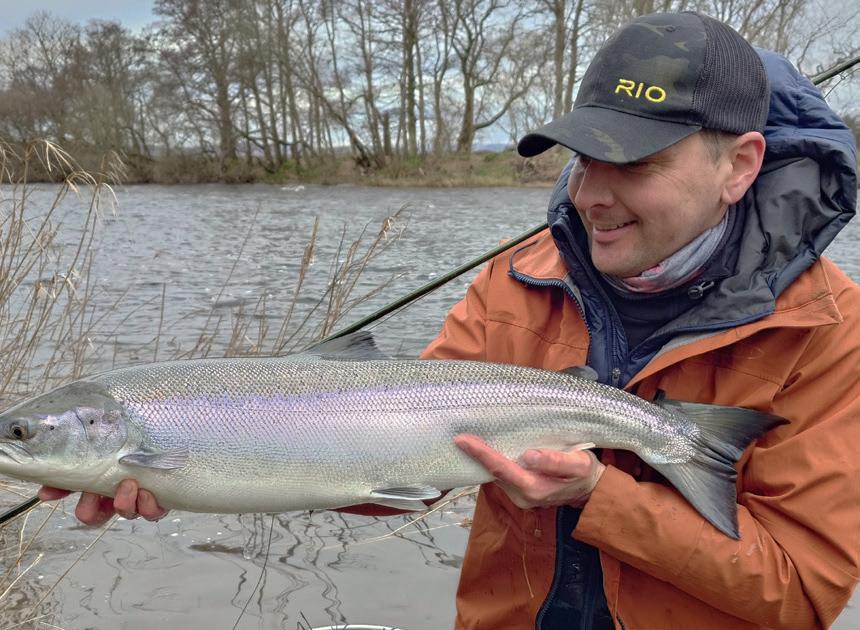
Buzzing For The Season
We go afloat with Russ Owen on Llyn Clywedog in search of early season takes.
Silver Linings


David Hoppe recounts a truly memorable salmon trip on the majestic North Esk.
The Angler’s Blessing
The wonderful world of the caenis is brought poetically to life by Peter Boyle.
Fly Scene
What’s happening in the world of fly fishing? Find out in our regular news section.
Flying High
Our editor, Ceri Jones, shares his thoughts ahead of a fly fishing summer.
Ceri Chats With…
Author, TV presenter, and adventurer Will Millard sits down with our editor.
Young Angler Spotlight
Top Scottish rod and youth team captain Jake Gilchrist shares what motivates him.
Tried and Tested
Our team give their verdicts on some of the latest fly fishing gear.

4 Flyfishing Journal
14 08 20 28 32 37 24 40
VOL 03: APRIL - JUNE 2024 20 14
Contents
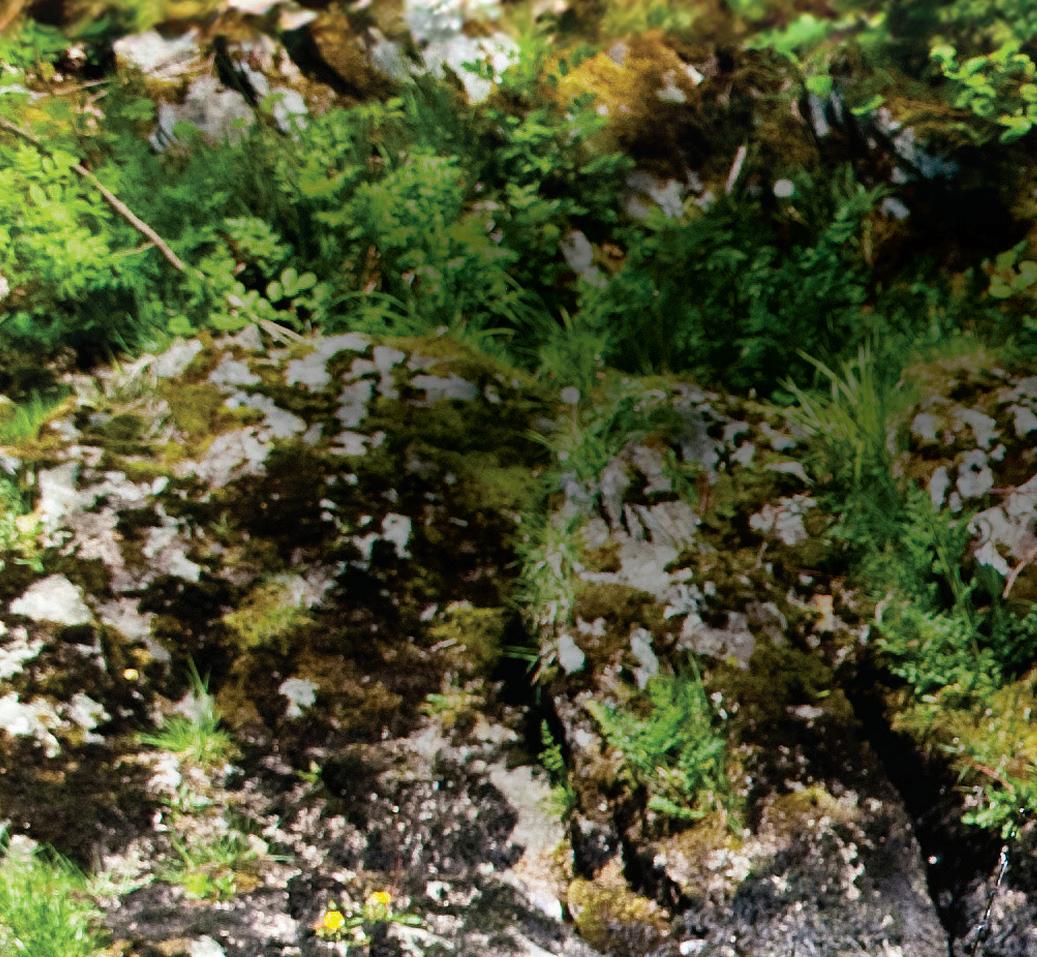
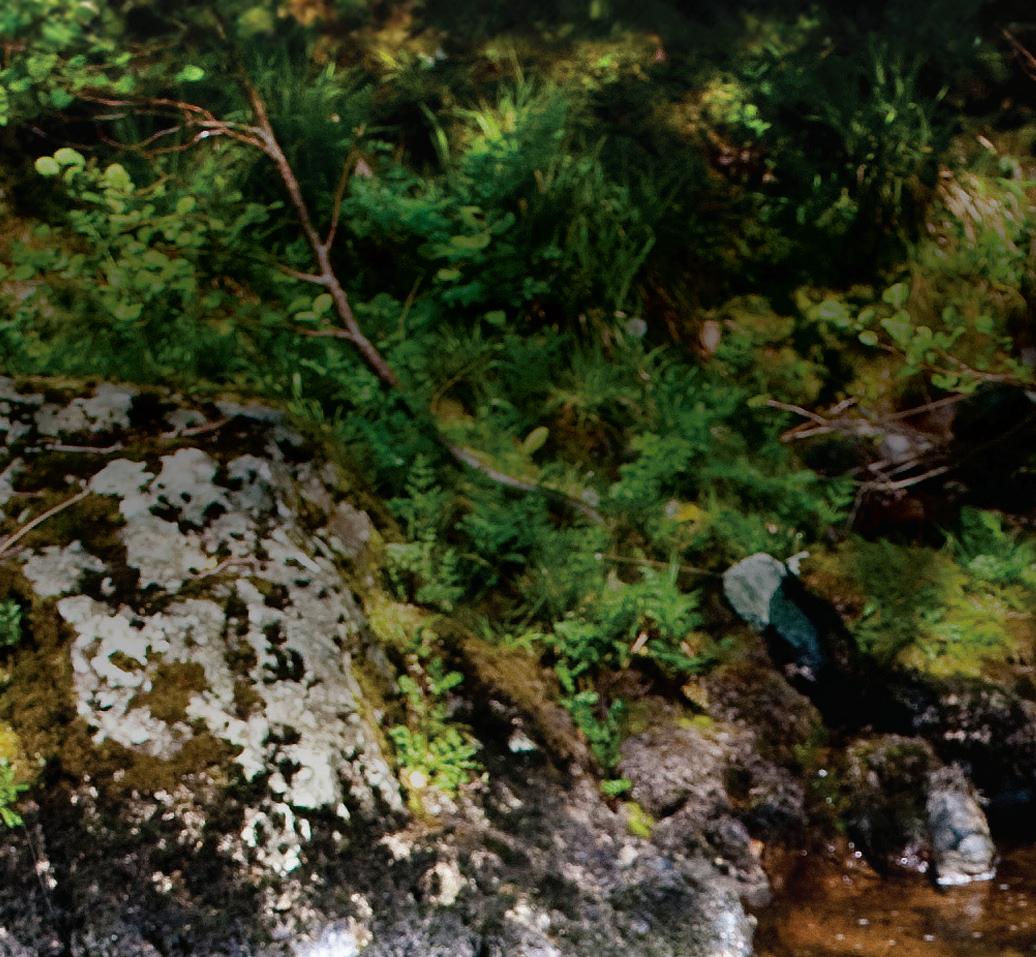


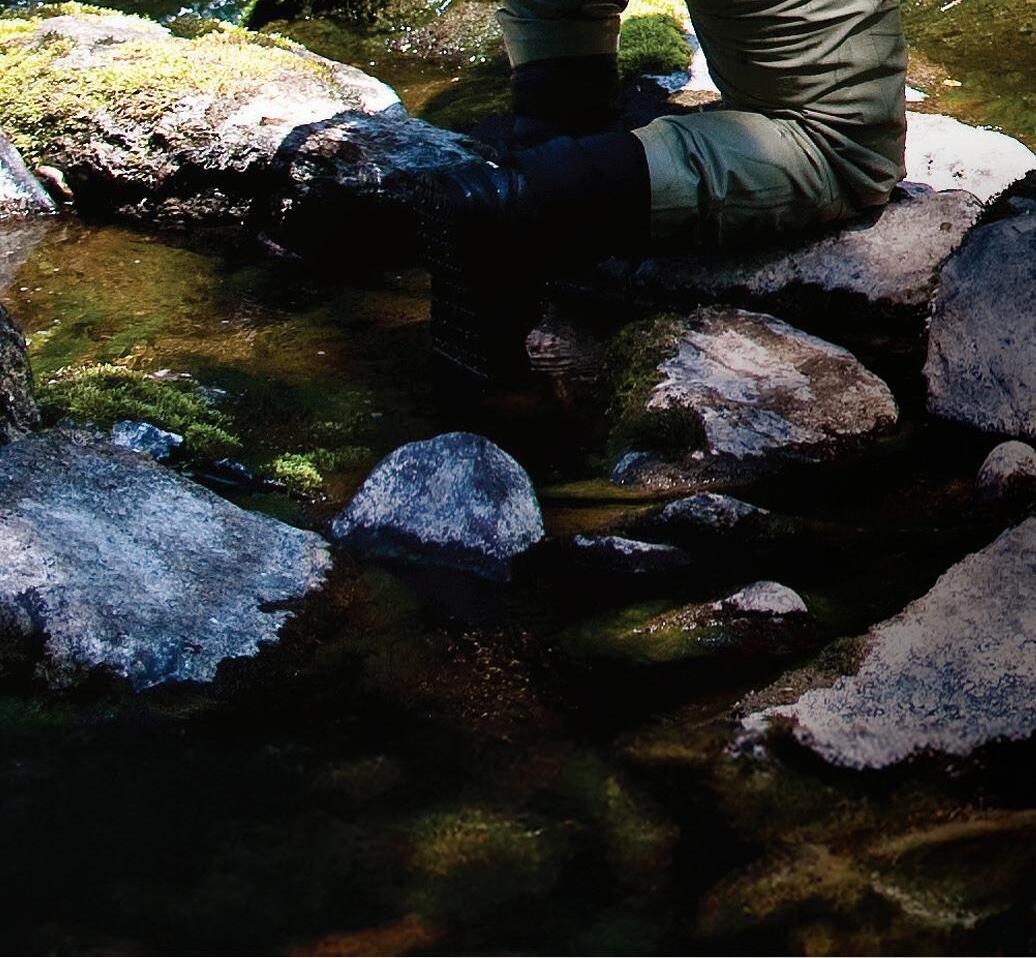
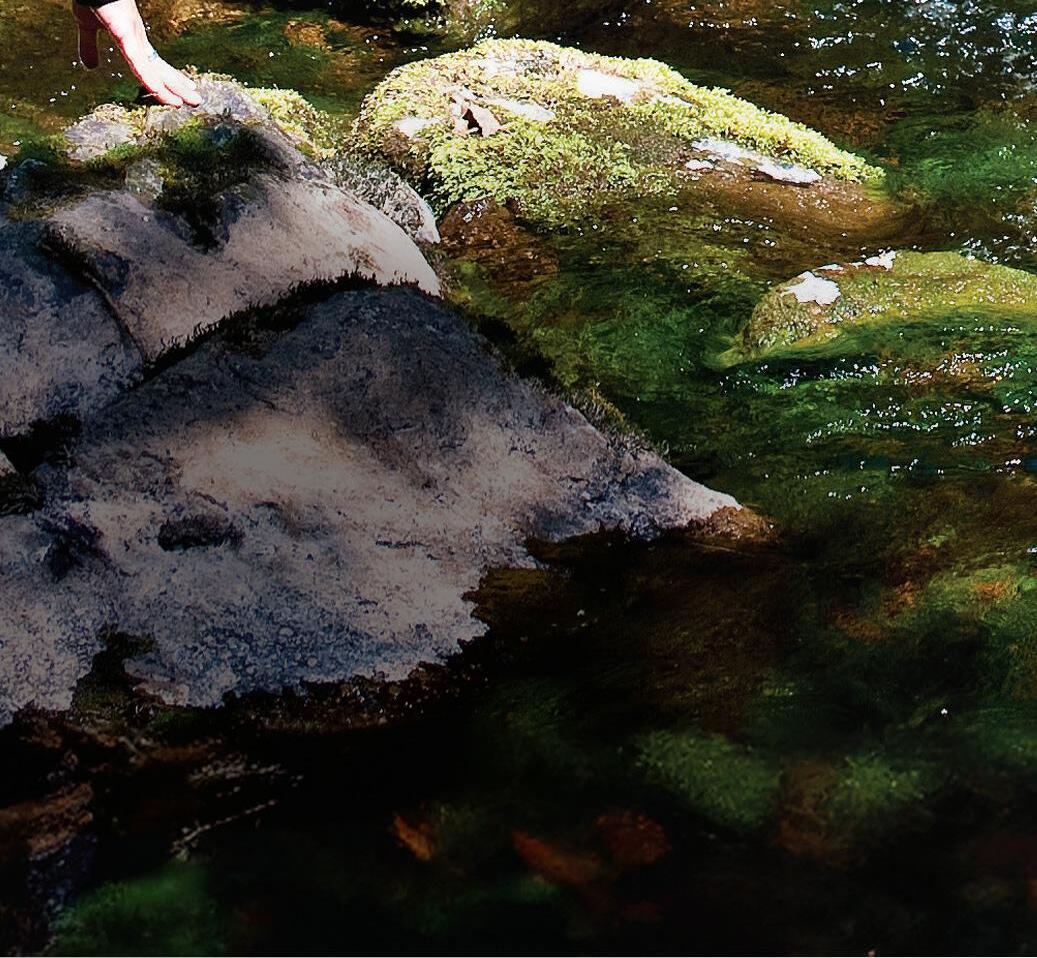

YOU THE EDGE, SINCE 1840
East Lyn, Devon. Image courtesy of Henry Gilbey
GIVING
The finest products. Expert knowledge. Friendly advice. www.farlows.co.uk Free UK Mainland delivery on all orders The
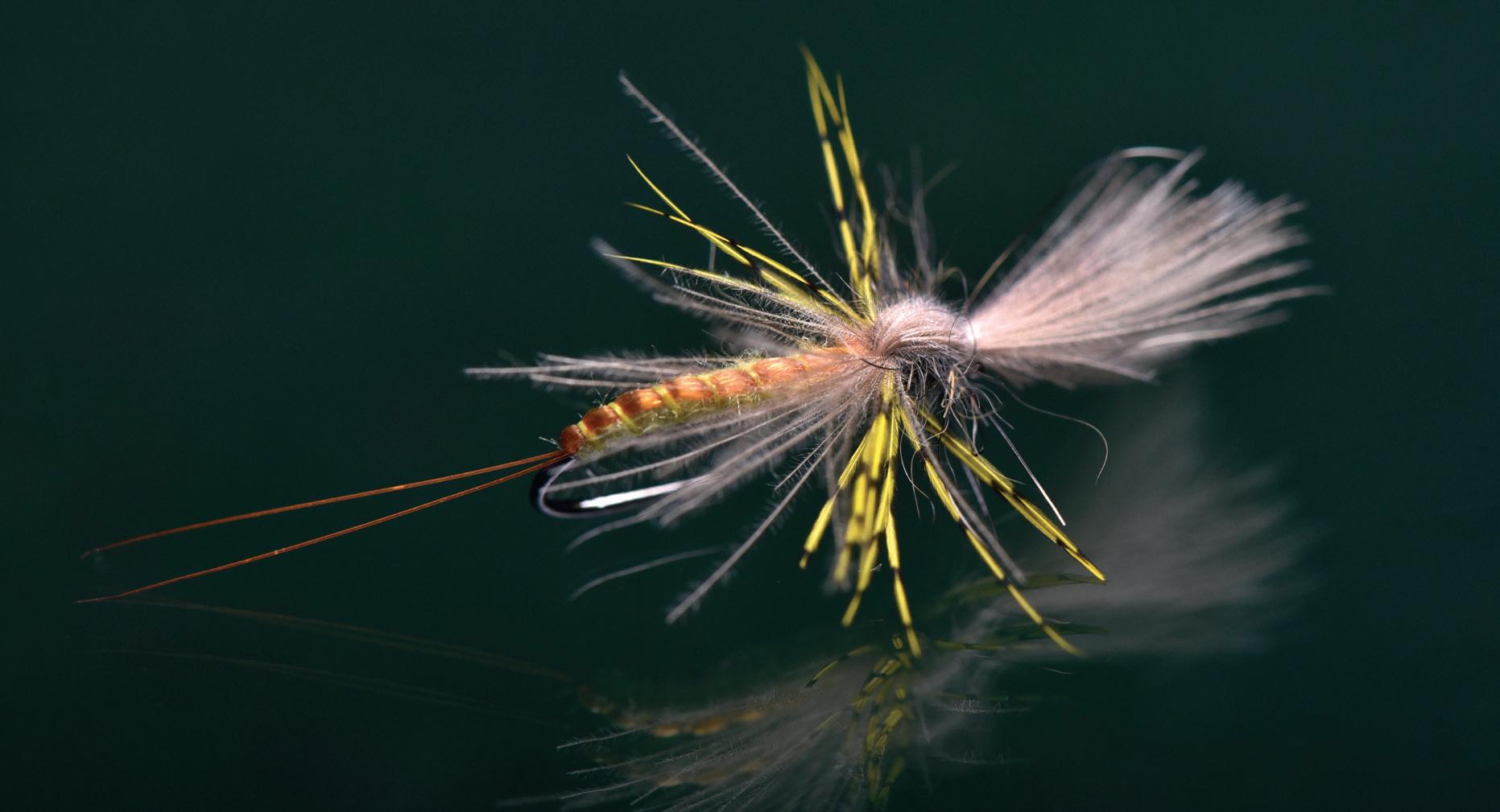
Yellow Fever
Rob Redman shows us how to tie one of his favourite hatches of the year.
A Well-Kept Secret
Discover the hidden fly fishing utopia that is the Falklands with Mauritia Kirchner.
Wandering Streams
When the river runs high, head to the tributaries – Sean Jones shows you how.
Reawakening
Our team reawaken from their winter hibernation and enjoy some stillwater sport.
Cooking Your Catch
A new series with celebrity chef Andrej Urosevic shows you how to cook trout almondine.
Queens of the Desert
Chris Hague showcases why Dubai should be your next overseas fishing trip.
Angling Trust
The latest information from one of the sport’s most important bodies.
Mayfly Memories
The best of Ireland’s mayfly hatches come later in spring, says Rob Connor.
Jolly Good Yellow
Angling author Duncan Hall heads to South Africa in search of elusive yellowfish.
Origins Of…
the
Alexandra Allun Rees takes a deep dive into a fly of great lineage from a bygone era.
Meet Our Experts
Say hi to the wonderful people who make this magazine a possibility.
Guides Directory
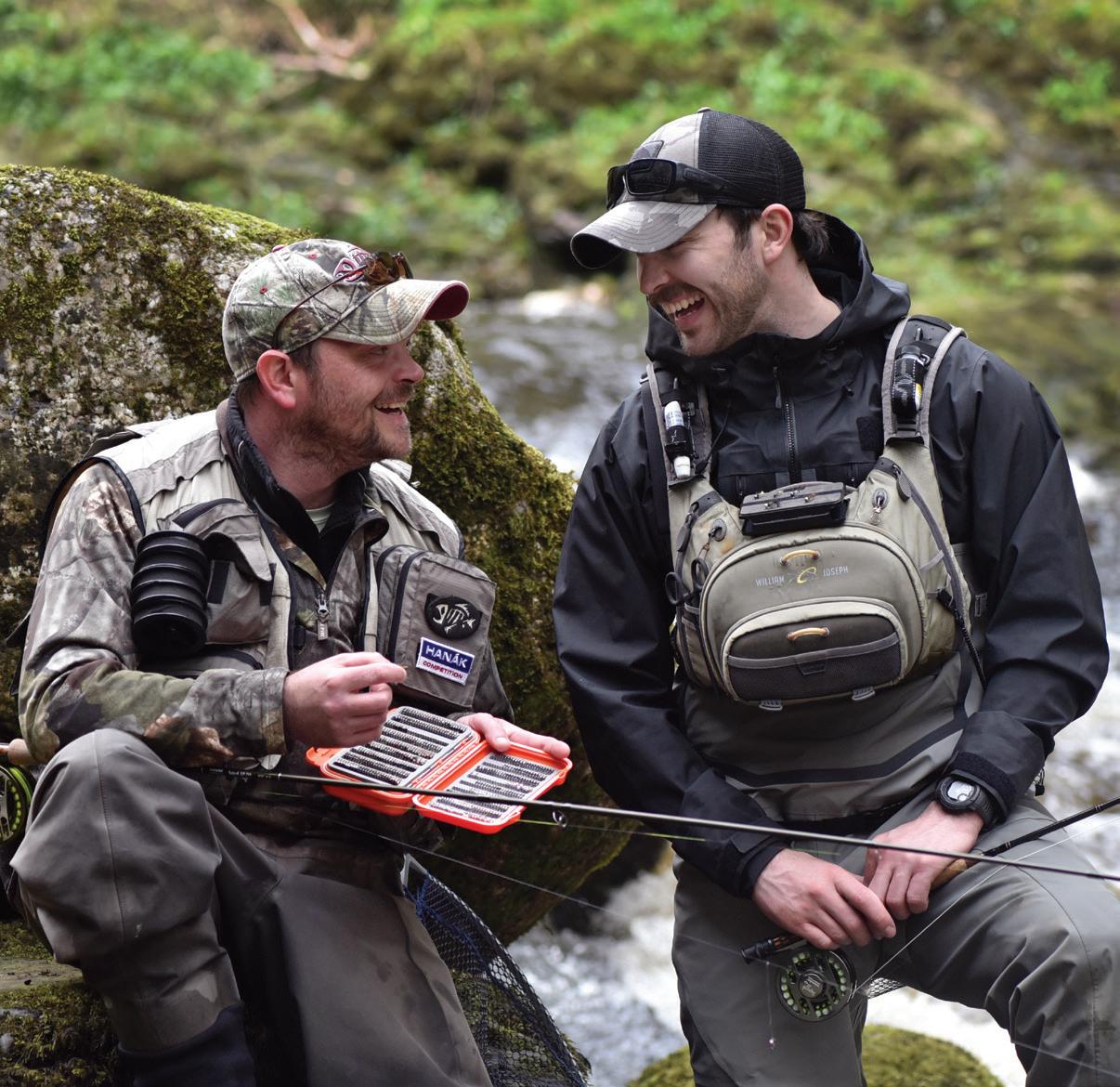

Flyfishing Journal 6 Destination Fly Tying Tried and Tested Fly Scene Entomology Rivers Saltwater Stillwaters Conservation Categories: 48 60 54 80 90 76 70 66 75 88 44 44 84 54
• Fully searchable New
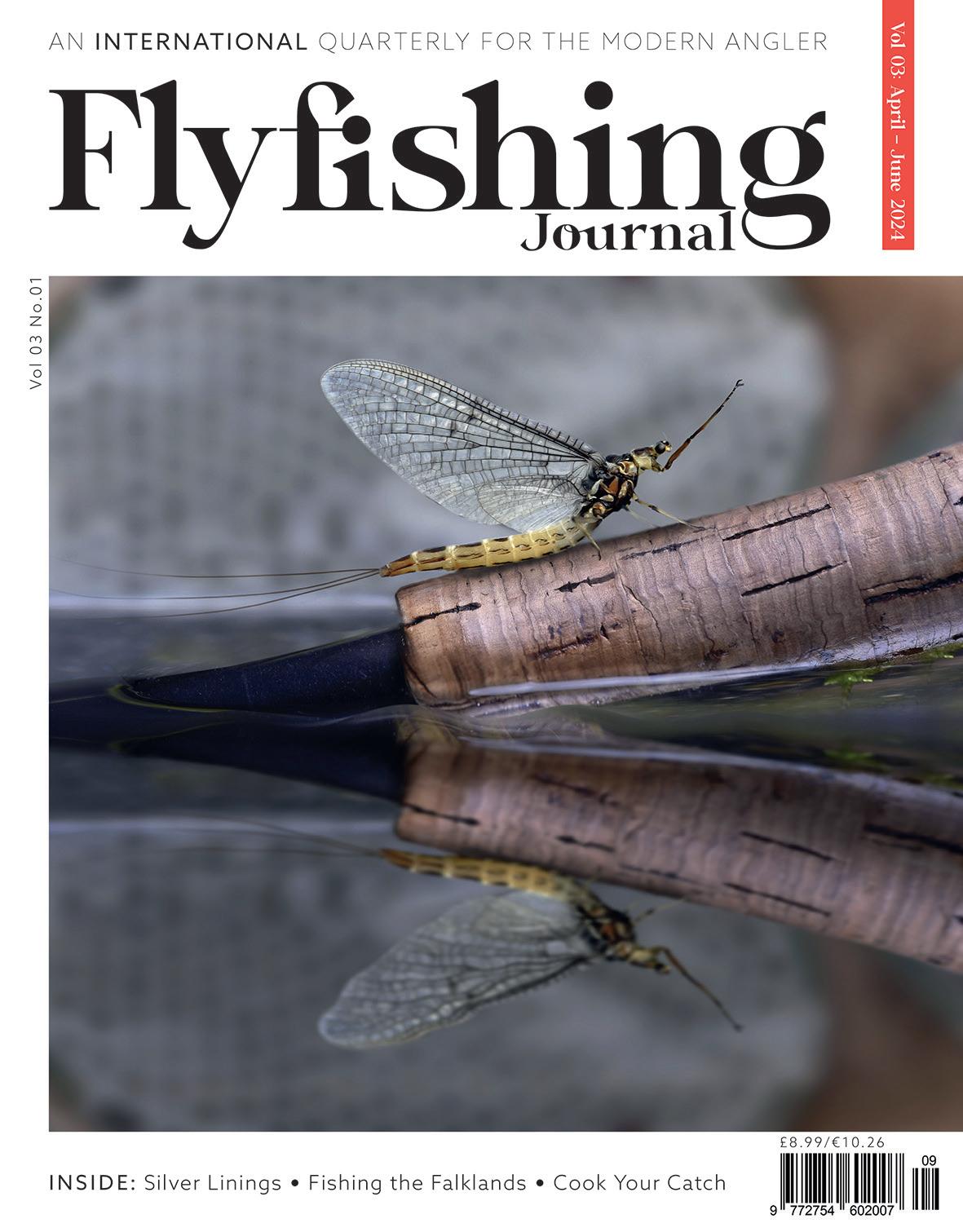

• Accessible anytime, anywhere so you can read on the go!
• Available on all devices including smartphones and tablets
Experience the tranquillity of flyfishing wherever you go! is now also available in digital format
Digital issues £8.00 / $10.00 / €9.00 each Print issues £8.99 with overseas rates available Available worldwide.
FOR FURTHER DETAILS ON HOW TO BUY YOUR DIGITAL OR PRINT COPY OF FLYFISHING JOURNAL, PLEASE VISIT.
Hope you are enjoying reading the latest issue www.flyfishingmedia.co.uk
for2024
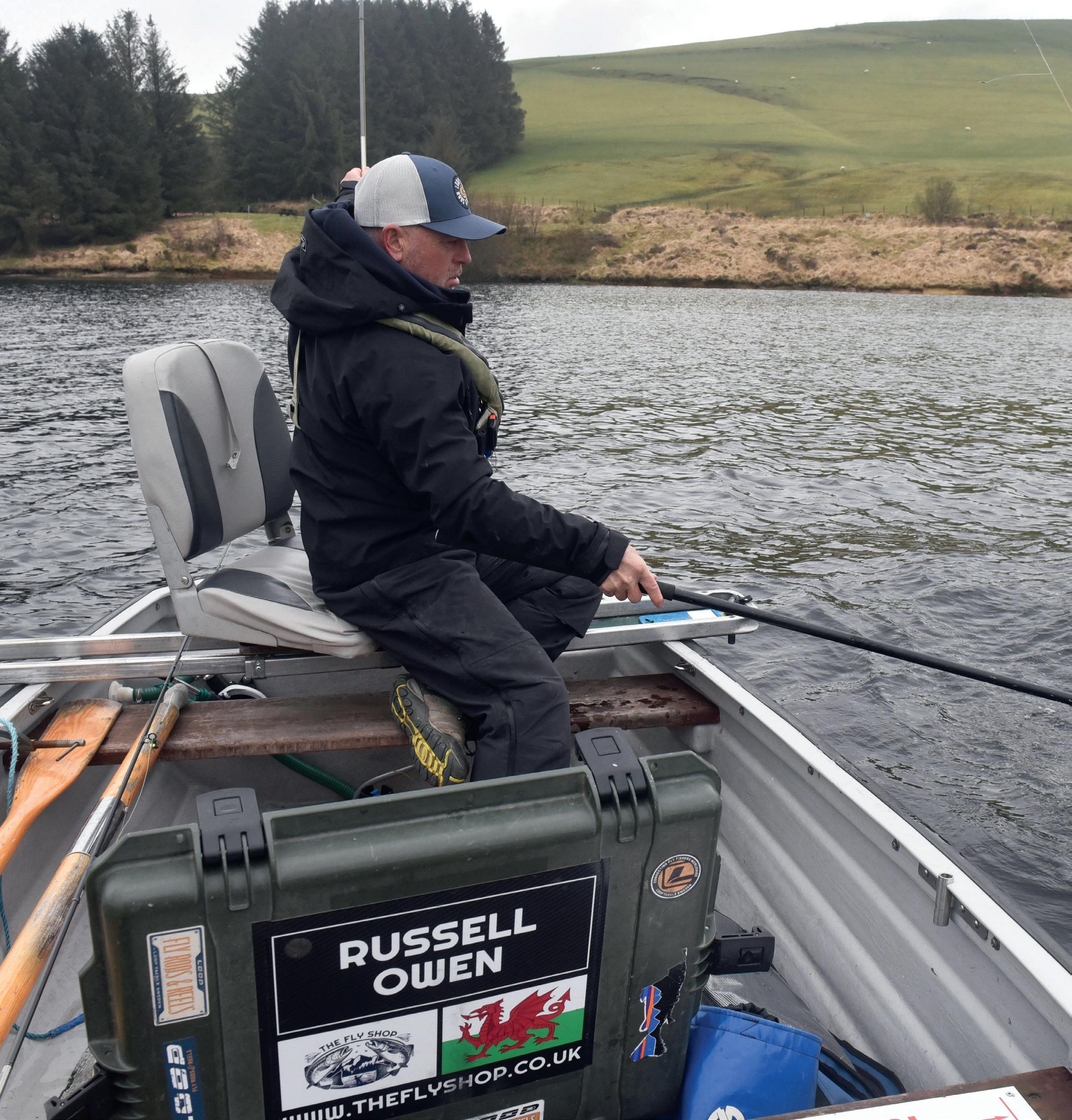
Flyfishing Journal 8 STILLWATERS
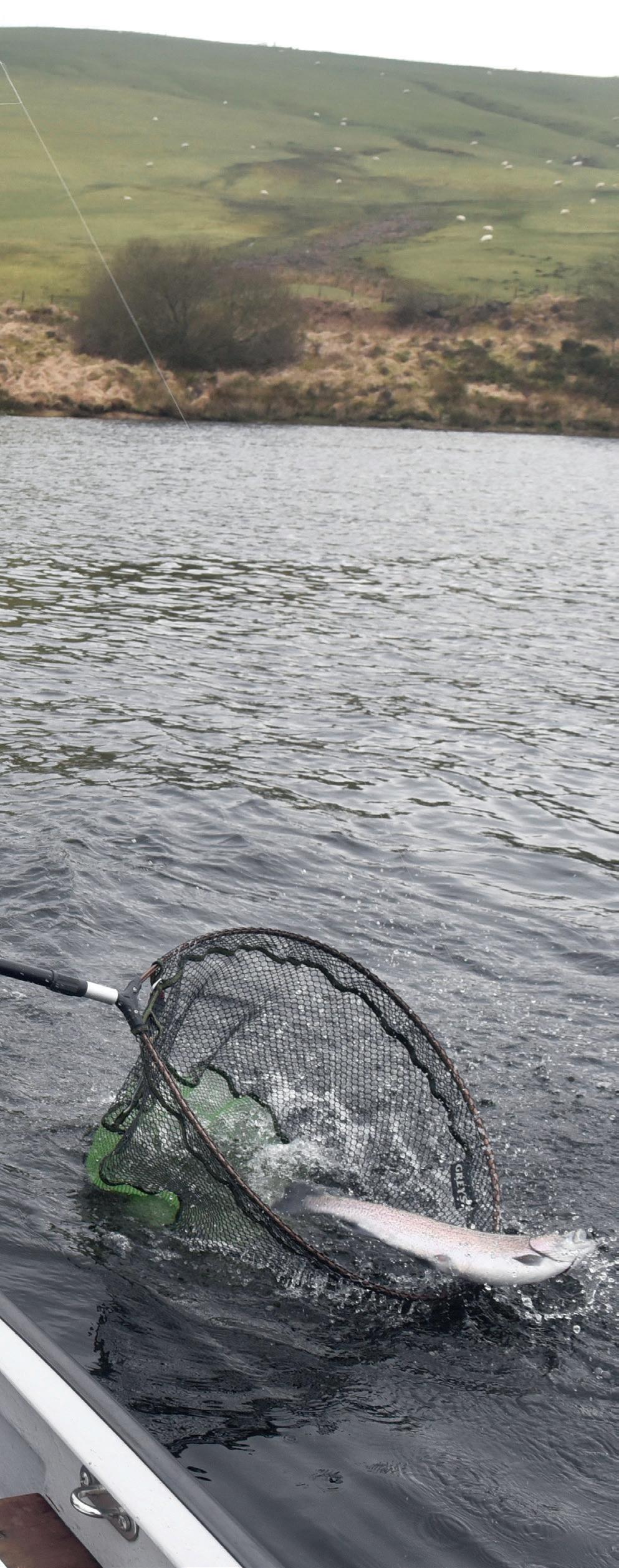

Buzzing for Early Season
Our editor heads out with Russ Owen on the famous waters of Llyn Clywedog to sample some of its early season sport and look ahead to the warmer months to come.
Nearly all lakes see a buzzer hatch in the spring, and it can range from a splattering to a full-on cloud burst on the rich lowland waters. However, on waters such as Clywedog, which is nearly 1,000ft above sea level and has slightly acidic
Russ slides the net under one of Clywedog’s early season buzzer feeders.
flyfishingmedia.co.uk 9
WORDS Russ Owen, PHOTOS: Ceri Jones

water, the hatch is more modest. This does not detract from its importance to the fish and the process of the start of the feeding season. Our buzzer hatch starts soon after we open in early March and continues as the water temperature rises right through to the end of April. The second point about Clywedog that’s quite different from most places is that the fish won’t be cruising around mid-water
feeding on the ascending larva, which is the normal way. The fish at Clywedog target the insects as they get slowed and trapped in the surface tension as they hatch. This is why our dry fly season can start in March and April.
TROUT CANDY
On the day Ceri joined me it was late March, and the hatch was very much in
An overwintered rainbow putting a fine bend into the rod.

Flyfishing Journal 10
STILLWATERS
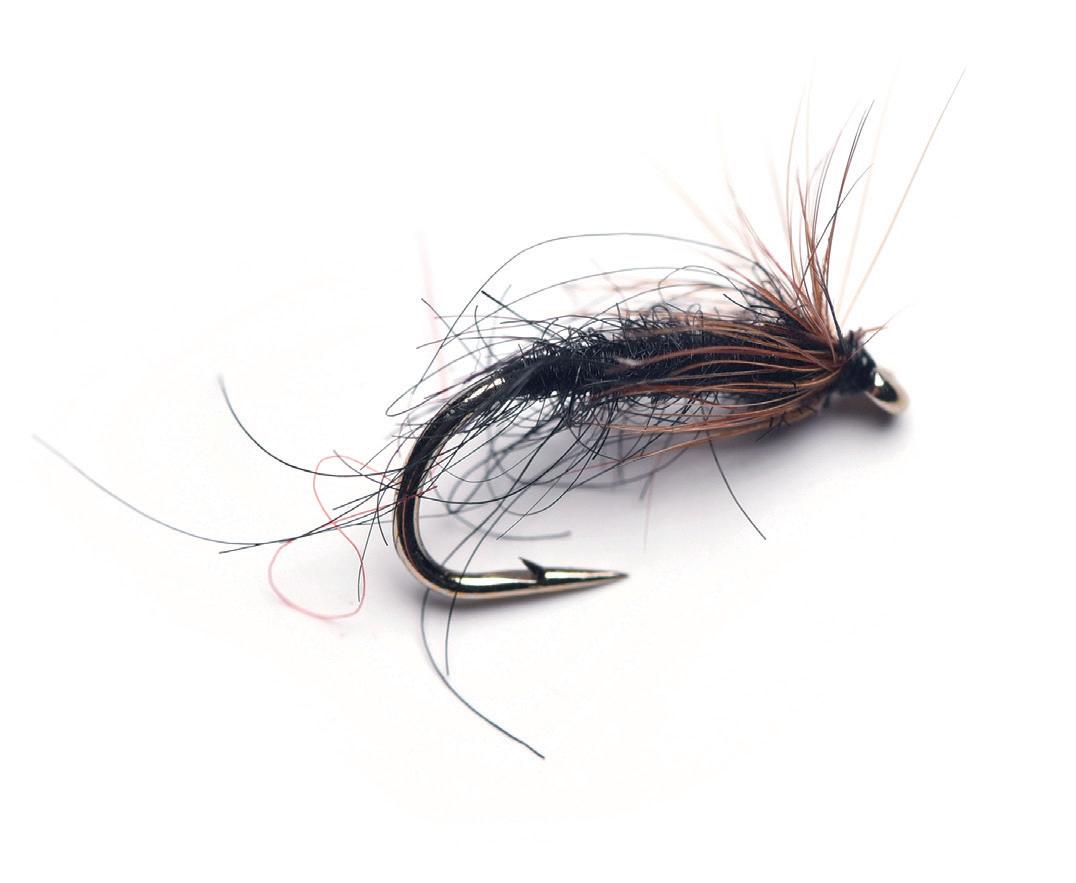
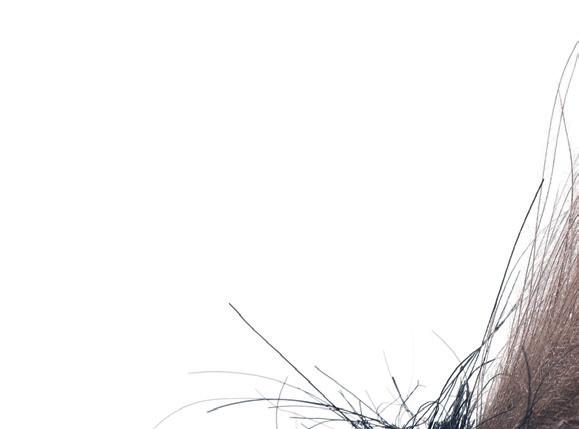

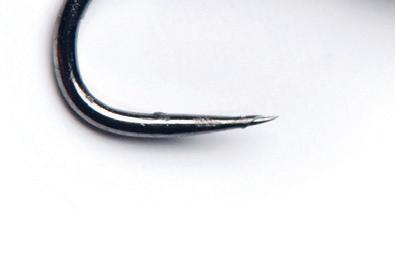
its infancy so we choose to use a washing line set-up with a 12ft slow intermediate tip and three flies: a candy booby variant on the point and black diawl bachs on the droppers. There are certain areas that the buzzers seem to like and the deeper water off the popular side is one of the best spring buzzer beds, so this is the area we started. Although a chilly easterly wind blew across the lake, within a few minutes we saw fish starting to feed on the surface so when the fish came into range the cast was duly made and the hungry trout obliged. It was not the black diawls that were catching their attention

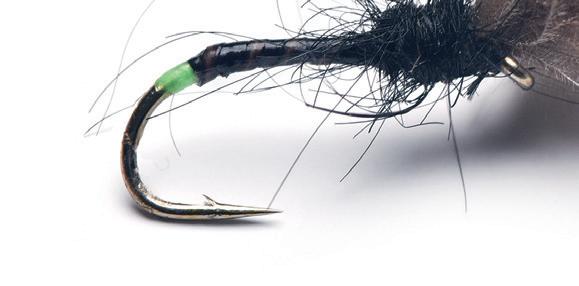

though, rather it was the candy booby that seemed to be the preferred offering. We spooned the trout and indeed the emerging buzzer were certainly in evidence with most still wriggling. As the morning went on, we drifted further down and caught several more rainbows – a mixture of overwintered fish and this season’s stock fish.
"THERE ARE CERTAIN AREAS THAT THE BUZZERS SEEM TO LIKE AND THE DEEPER WATER OFF THE POPULAR SIDE IS ONE OF THE BEST SPRING BUZZER BEDS. "



The buzzers on Clywedog come in all shades of black!
The fish are in fine condition in the cool spring water.

11 flyfishingmedia.co.uk

TAKING A GAMBLE
With the easterly breeze continuing and after a coffee in the lodge, we decided to take a gamble and head for the bottom end of the lake and the sheltered waters off Bwlch y gle dam with very few if any anglers venturing that way since Clywedog opened and no reports of fish being taken down there. Our fingers were firmly crossed that there might be some overwintered fish feeding on the edge of the ripple off the dam wall. On arriving there was little evidence of fish feeding but we soon saw a couple of fish in the calm waters obviously sipping a few of the emerging insects. With a few precise casts, both Ceri and I were quickly into fish –some beautiful full-tailed, overwintered fish that were very hungry after a winter

of lean pickings. In fact, fish were coming blind here indicating that there was a good head of fish happily residing in the area since last year.
SEASON’S CHANGE
As the hatch itself progresses over the next month to six weeks, ever-increasing
Russ constantly scans the surface for any signs of movement.
A typical Clywedog surface feeder.


STILLWATERS Flyfishing Journal 12


"IT’S GREAT FUN WHEN YOU SEE THE FISH TRACKING UPWIND SIPPING DOWN BUZZERS – YOU CAN LAY A TRAP IN FRONT OF THE FISH READY FOR THEM. "
Always a sign of a fish that’s been in the lake a while spots in the fins and white tips to them .


numbers of insects start to hatch. This is a turning point at the lake, which goes hand in hand with rising temperatures as it tends to draw the fish off the contours that they patrol during the first few weeks after opening to the open water right across the lake. Indeed, at times we see large pods of fish feeding heavily on the surface. During this period, it will be the dries that become



the preferred method to catch these fish –flies such as small black shuttlecocks, bob bits, and the top hat buzzer have certainly proved very successful over recent seasons. In fact, it’s great fun when you see the fish tracking upwind sipping down buzzers –you can lay a trap in front of the fish ready for them. As I mentioned at the start of the article, this hatch is the start of the feeding season here at Clywedog as once we get into April, we start to see the arrival of not just our resident ospreys but also more and more terrestrial insects on to the water – cow dun, hawthorn fly, alder and then the big hatch at the start of June. Exciting times ahead.
Russ’ top early season buzzer set up. Candy boobie variant.
Blue holo ribbed jc diawl Bach.
Black holo ribbed jc diawl Bach .


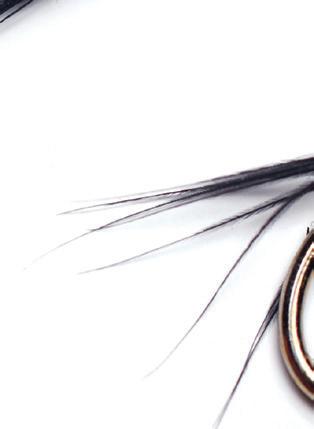
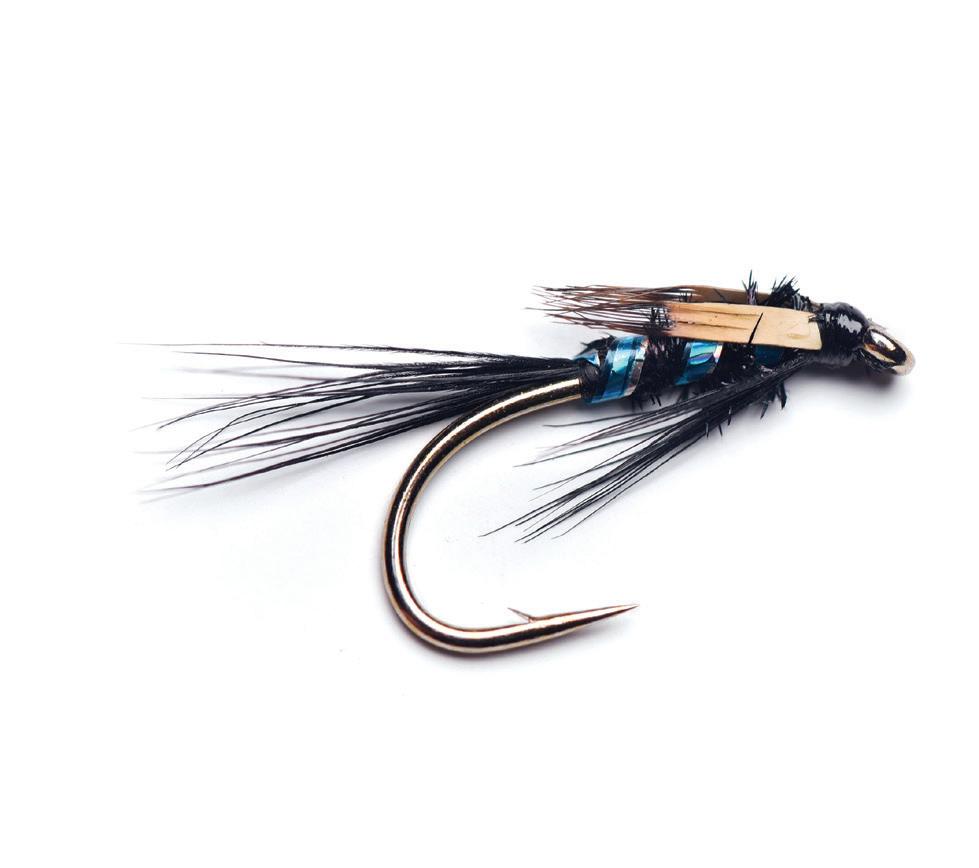



flyfishingmedia.co.uk 13
Silver Linings
David Hoppe heads out on a rare foray to the North Esk in search of silver springers and the hope of extending a remarkable streak of beginner’s luck.
Ifeel like a little bit of a fraud writing an article about salmon fishing. Truth be told, I have only been on six, three-day salmon trips, all of which were to the stunning North Esk, in Montrose, Scotland. However, of those six trips, I have somehow managed to catch fish on all bar one. I have just returned from a recent trip where I was fortunate enough to have hooked some more spring silver. Perhaps it’s just beginner’s luck?
The stretch we fish is run by Pert Fishing Ltd on the North Esk. It is just sevem miles from the sea and consists of approximately two miles of single bank fishing comprising of some 12 named pools. There is the lower section which includes the famous Luther’s Pool, a deep run where the Luther Burn meets the North Esk. In summer, the fish are often seen in the deep pool resting, waiting for levels to rise so they can carry on their incredible journey. The middle section includes The Bridges. Here there is a fishing hut used by the anglers where you can have a coffee watching the salmon leaping in front of you. The top stretch includes The Boatpool and finishes at Upper Weir.
RUDE AWAKENING
It was mid-March, and our highly anticipated annual trip was underway as I drove from the Midlands up to Montrose. After eight hours of driving, I finally met up with five other anglers, including fellow contributor Craig Barr, in the hotel bar. We were all excited about the prospects of an opportunity to hook up with an elusive spring salmon.
Next morning, I was rudely awoken by my phone at 4.45am. A very excited Mr. Barr was on the line: “Come on let’s go fishing”. I politely told him I would join him a little later. I met with Craig on the riverbank at a more resasonable 7am. I parked my car, opened the boot, and started preparing. Waders on, warm jacket zipped up. Out came a 13.6ft Sage Sonic with RIO Elite Scandi Outbound (8/9) which, if my wife is reading this, I did not buy last month in preparation for this challenge.

I have learnt that in the spring, just like early season trout, the salmon tend to stay deep and as such, it’s important to ensure that the fly gets down fast to reach the fish. I have been using 10ft RIO Medium

14 RIVERS Flyfishing Journal
WORDS AND PHOTOS: David Hoppe
An immaculate North Esk spring fish for David, taken from Hoppe’s Hole.
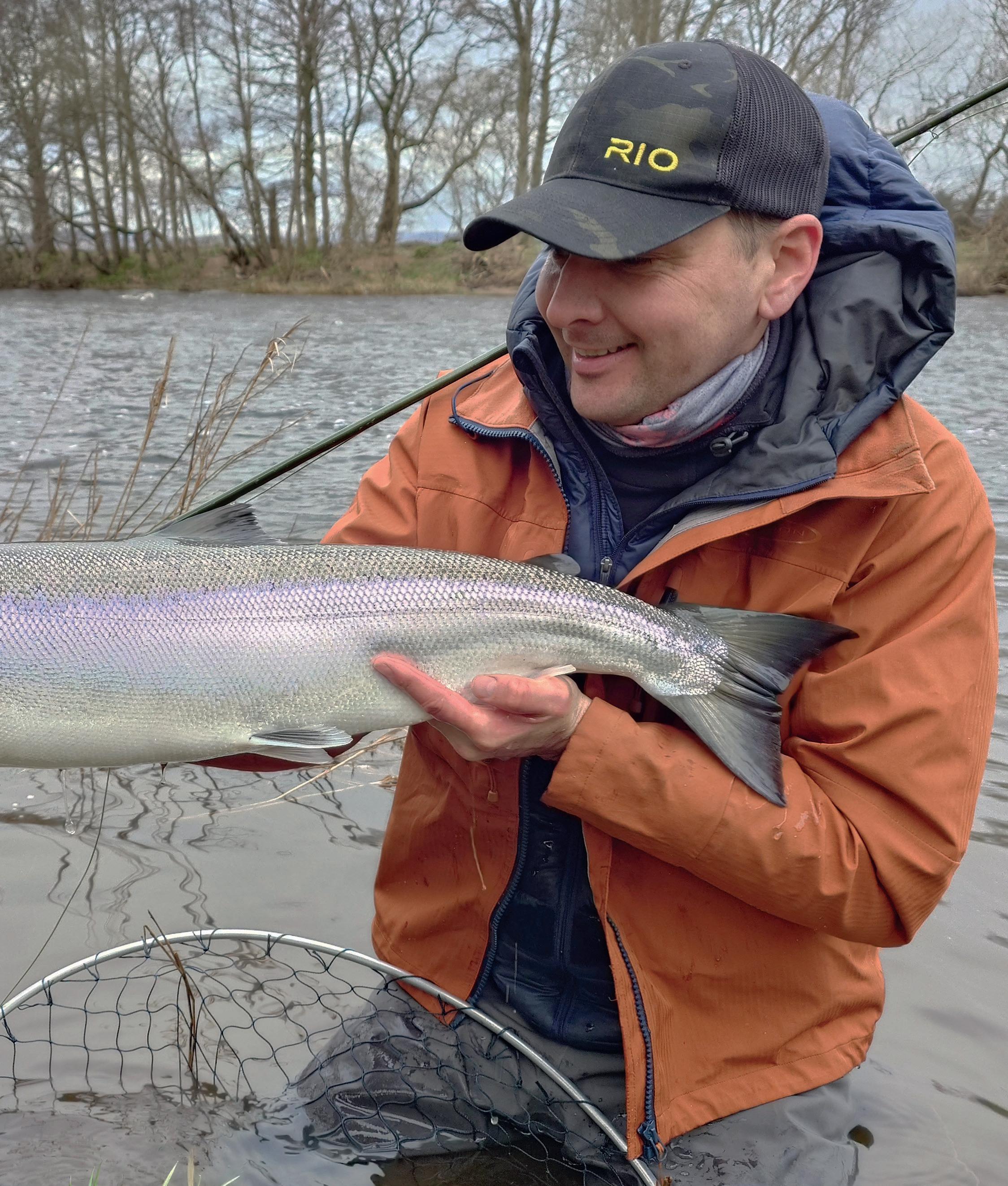
flyfishingmedia.co.uk 15

Versileader Fast Sink which sinks at a rate of 6-7 inches per second. If you are using a fast sink leader, you need a short leader otherwise your flies won’t sink fast enough. I use a maximum of 3ft leader.
I am getting addicted to modern salmon flies. The number of flies available is mindboggling. I have quickly learned that if you buy or tie one fly which looks ‘fishy’, then you better play it safe and have the same fly in different sizes and weights and colours. All of a sudden you own an alarming number of the same fly… just in case. This year I decided to start my campaign with a Fulling Mill Solar Monkey Global Cascade (0.5inch). It is weighted, not too large and has a bit of flash and, well, in the palm of my hand, it just looked fishy!
DOWN TO BUSINESS
The river level was perfect. Recent heavy rain had kept levels up and there had been some large spring tides earlier in the week, which would surely push the salmon up the river. The weather was overcast and mild.
I decided to start at the top of our stretch,
fishing Upper Weir. I checked my watch; it was now 7.56am. I entered the water as stealthily as possible. You don’t want to scare any holding fish which might be in front of you. My plan was to cast towards the other bank, let the sink-tip and fly dig in, then the fly would swing around towards Hoppe’s Hole (a deep run which is where over the past few years I have caught from, hence its christening by the other team members). Hopefully, a big salmon would be waiting: First cast was terrible, I really should have some casting lessons. Second cast was a little better, but my fly didn’t reach the hole. Third cast, perfect, then the line just stopped and before I knew it, I had raised

16
David’s Solar Monkey Global Cascade.
RIVERS
Flyfishing Journal
A beautiful spring morning on the North Esk.

"TWO OF THE ANGLERS WERE RUNNING TOWARDS ME, NETS IN THE AIR, ONE OF THEM STUMBLED AND NEARLY WENT FLYING. "
the rod and bent into a large fish. I was in total shock!
In a panic, I started bringing the line in with my hands, like you do when playing a trout. Then I came to my senses and quickly switched to playing the fish off the reel – my instinctive line grabbing thankfully going unnoticed by my companions. Two of the anglers were running towards me, nets in the air, one of them stumbled and nearly went flying. The others were driving at full speed, crosscountry with one angler hanging onto the side of the 4x4 for dear life. It was like as a scene from a movie.
PERFECT DESIGN
The salmon is designed for power and speed, to negotiate rapids and waterfalls. The speed and power they display when on the end of the line is simply just incredible. A flick of their tail and they appear 5m

downstream in a matter of seconds. This fish initially kept deep swimming upstream with occasional insane bursts of speed creating a screeching sound, as the line was forcefully cut through the water.
After around 10 minutes, I felt like I was winning. Craig got in the water with the net. Everyone on the bank was giving their own instructions and advice – it was both total chaos and bliss at the same time. First attempt at netting didn’t go well, the fish spooked and tore downstream. Second attempt was no better, made worse by the live commentary on the bank. However, I finally managed to get the fish to cooperate, and Craig netted the fish which was met by cheers, high fives and pats on backs. I glanced down into the net. A perfect, freshly run double figure salmon, which was most likely in the sea a day or so previously. The fly was in the corner of its mouth.
LIGHTNING STRIKES TWICE
Despite perfect conditions, things were quiet for the rest of the day, although one of our group hooked a fish and kindly passed the rod onto his friend to play the fish. Despite his best efforts over the years,
flyfishingmedia.co.uk 17
Craig Barr first on the scene with his waiting net.
(Right) Relief for David, a bar of silver safely in the net.
"FIRST
CAST, A LITTLE OFF. SECOND CAST, THE FLY NEARLY REACHED THE ROCK. THIRD, PERFECT AND THEN THE LINE TIGHTENED."
he hadn’t hooked a salmon, so this really was a kind gesture. Unfortunately, the fish took a run and threw the hook. Then it started to rain. The following day the river had risen over 2ft and had become a muddy brown, making flyfishing nearly impossible.
Some heavy rain made the second day almost unfishable however things had eased on the third day – the river had dropped and was clear again. Everyone was incredibly enthusiastic and excited by the prospects of a salmon. I left the group to fish the upper sections and searched for silver at the Bridges. Around 12pm I had a call from a distraught Craig who had hooked and lost a good fish from Hoppe’s Hole. I decided to meet up with him for a counselling session. He talked me through what he did, where he had cast. The fish was hooked 20 yards downstream from the deep run, next to a rock in the shallows. I asked if I could have a cast. He agreed and laughed, thinking that there was zero chance of a fish now.
First cast, a little off. Second cast, the fly nearly reached the rock. Third, perfect and then the line tightened. Craig was in total disbelief. It was another totally insane fight with the fish
stripping line, jumping, trying everything in the book to evade capture. Finally, the fish found the net and what a pristine fish it was. Another of the North Esk’s finest, around the 13lb mark.
On reflection, this year I was very lucky to have caught. But over my (not so extensive) six years’ experience, I have learned you need to do everything you can to increase your chances and luck. You need to cover as much water as you can; on day one I walked 16km. You must take in all available information from your fellow anglers, (chances, flies, potential new fish hiding spots). In the spring, you need to keep your flies deep and in the taking zone for as long as possible. Sounds obvious, but you won’t catch during a two-hour lunchbreak, so eat on the river or while walking between beats. If you do all of the above, you will most certainly increase your chances of a fish. But with all that said, I still believe the most important element is luck. This salmon fishing could get very addictive.
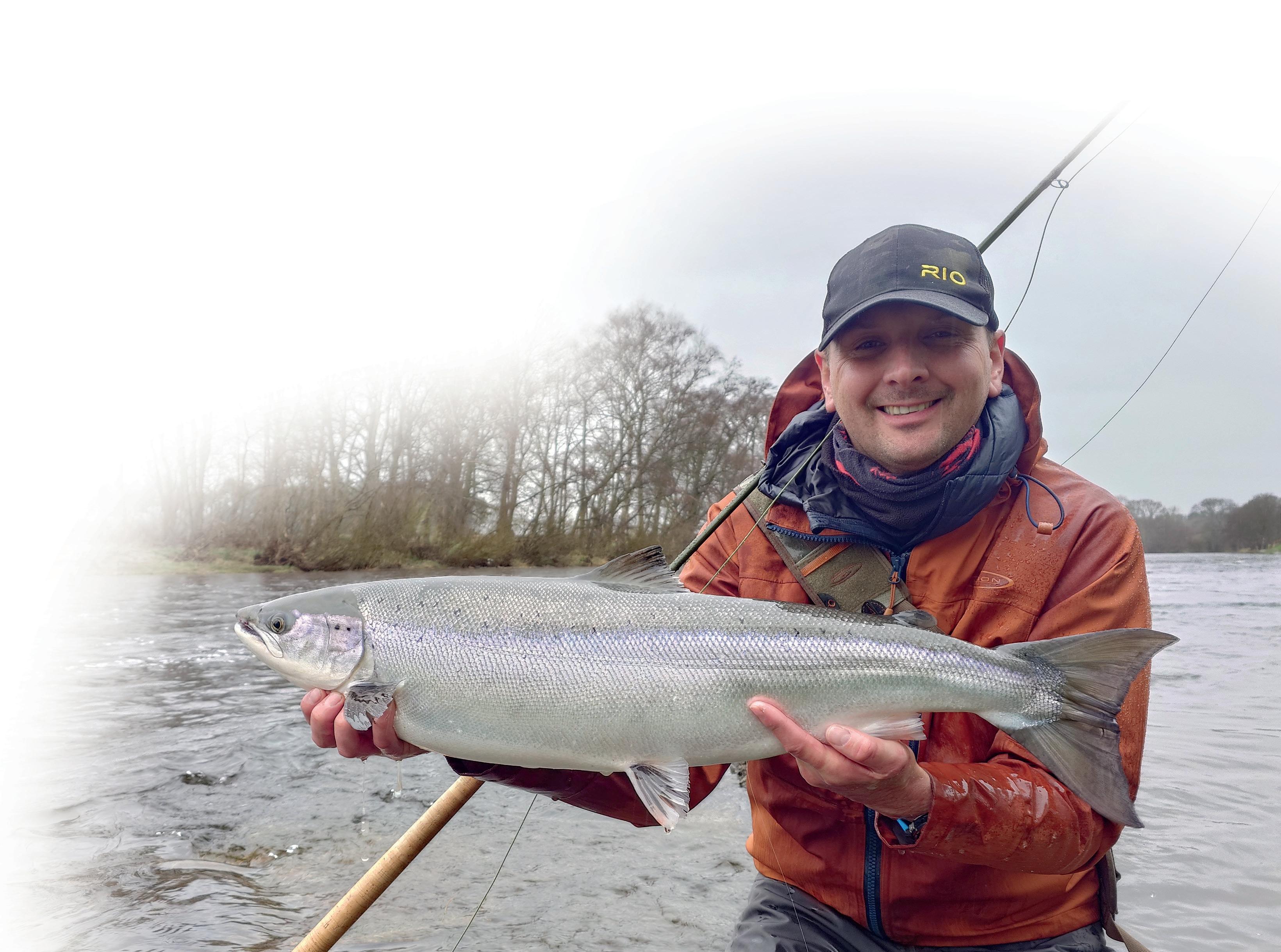
18 Flyfishing Journal
RIVERS
David’s second pristine double of the trip.




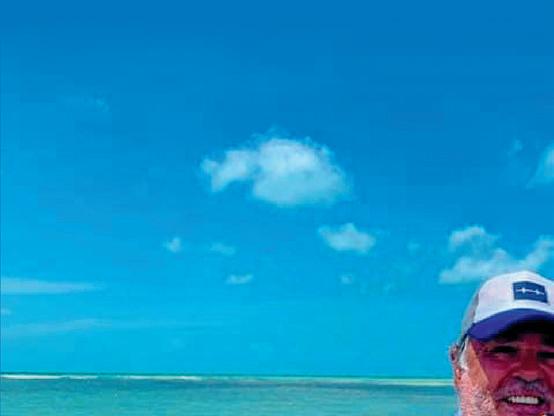
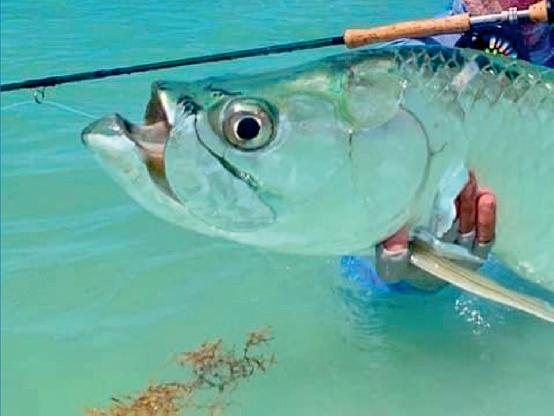

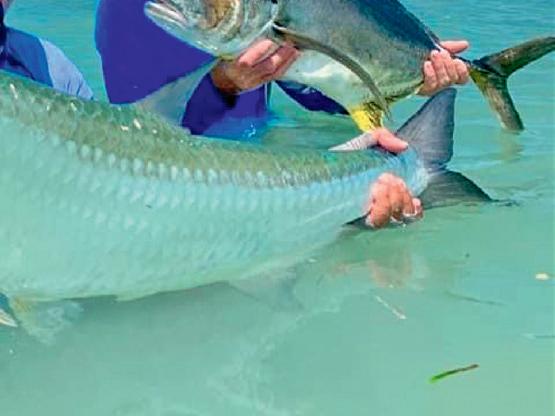


• Cape Verde, Blue Marlin
• Paredon, Cuba
• Cayo Santa Maria, Cuba
• Cayo Cruz, Cuba
• Zapata, Cuba
• Ascension Bay, Mexico
• Slovenia, Grayling & Trout
• British Columbia, Salmon & Sturgeon
• Gaula, Norway
• Verdal, Norway
• East Ranga, Iceland
• Bahamas Bonefish School
2024
020 8742 1556 M info@gofishingworldwide.co.uk www.gofishingworldwide.co.uk
Hosted and Tailor Made Trips
J
GO FISHING
CALL FOR A NEW BROCHURE
Ghillieuk
WORLDWIDE
GhillieUK.com
@Ghillieuk
WORDS & PHOTOS: Peter Boyle

Caenis: the Angler’s Blessing
Peter Boyle teaches us the merits of patience, precision, and perseverance as he gives his advice for how to make the most of fishing a Caenis hatch.
In the enchanting ballet of dawn, the final wisps of spectral mist gracefully twirl and dissipate upon the water’s surface, surrendering the stage to the sun’s grand spectacle. A radiant performance ensues, illuminating the delicate spider webs woven intricately through the hedgerows with the ethereal glow of summer dawn dew. The once serene silence yields to the rhythmic symphony of “whit-tit-tit-tit-tit-tit” from the whimbrels, a harmonious call awakening the intrepid anglers who have dared the 2am start.

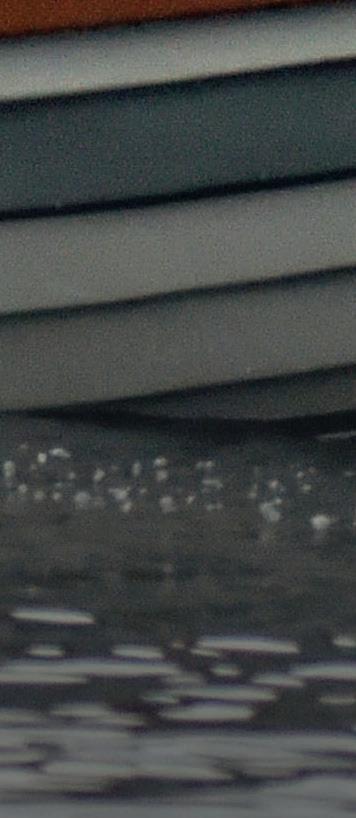

Within this mesmerizing dreamscape, the initial surge of anticipation and excitement gracefully yields to an unwavering focus on observation. Standing in the company of the breaking dawn is the solitary angler – poised, pensive, and keenly aware. As a silent spectator, they await the genesis of activity, the moment when the lake stirs with the bubbling emergence of dark snouts belonging to brown trout, eager participants in the dawn banquet of the diminutive Caenis fly.
For the privileged angler beholding
Peter
Flyfishing Journal 20
STILLWATERS
heading out just after dawn in search of caenis feeders.

this spectacle, shoals of wild brown trout swimming with mouths agape, a thrilling challenge unfurls. This is the essence of fishing in its purest and most poetic form – a dance with nature where the slightest misjudgement can metamorphose the theatre of dreams into a symphony of elusive trout.
CHALLENGES AHEAD
The Caenis fly, a delicate member of the Mayfly family, graces the stage from June to August and demands very settled conditions. Therein lies the challenges, in
order of priority: the first is how to present your fly with precision, the second how to navigate the boat in the tranquil waters to ensure you meet the shoals of elusive trout who are so absorbed by the blanket of fly on the water that they feed erratically and lastly what pattern to use.
My set-up is simple. 5-wt, weight forward, floating fly line, tapered leader threaded through the center of the fly line, seamless ring attached to the end and tied to a 4lb fluorocarbon cast with a single size 16 to 18 dry fly. Then just wait, keep your profile as low as you can and wait,
flyfishingmedia.co.uk 21
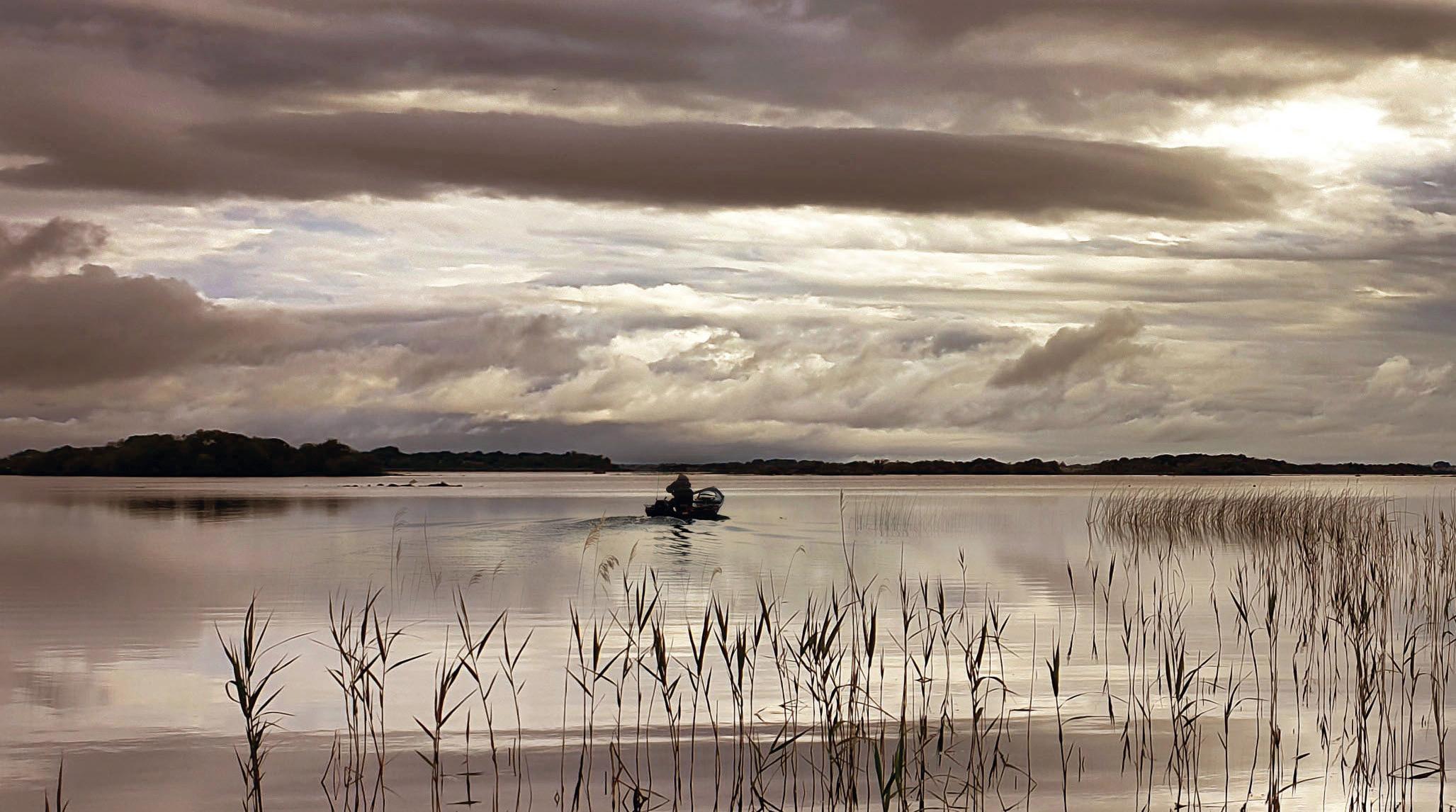
just sit on your hands. They will come. Plan your strategy, watch the shoal and try to select which fish you are going to target. Anticipate the direction and when the moment feels like you can’t bear it any more then cast. Reduce the risk of spooking the shoal by targeting the fish who are at the edges of the shoal, and expect refusals, as more often than not they are so absorbed that they just do not see your fly. If you experience a refusal do not react cast, wait until the fish has passed and slowly raise your rod. Be mindful of your false casts as too many will signal your presence and spook the shoal.
The second challenge comes down to watercraft. My Caenis fishing is largely solitary, so the boat is set-up


to reflect that. To reduce profile, I have taken a lesson from more seasoned Caenis hunters on the Corrib and I fish out of the pointy end of the boat. This can be difficult as if there is any slight breeze at all the boat will want to swing broadside. To overcome this I mount an electric engine on the gunnel at the front of the boat in conjunction with a canoe drogue in the water at the rear out over the engine. The electric engine is not to chase fish, use the oars for that, the electric engine is used solely as a side thrust in maintaining the position of pointy end pointing at the targeted fish.
The third challenge is fly selection. The
"THREE OR FOUR WILD TROUT GRACEFULLY BREACH THE WATER’S SURFACE, RISING IN A MESMERIZING BALLET, REPEATING THEIR DANCE FOUR OR FIVE TIMES WITHIN A MERE FOOT SQUARE."
The hatch is on and a selection of Peter’s imitations.
Flyfishing Journal 22
STILLWATERS

most important advice is to expect refusals and do not react by changing fly. This will add a level of frustration that will get into your head mess up your game. Just wait. Sit with the fly in your hand and concentrate on executing your cast. Once you see a shoal encroaching into your vicinity put a cast into the water just ahead of them. This will allow the friction of the water to assist in your pick-up and reduce false casting when you have selected your target.
PATIENCE IS A VIRTUE
Amidst the culmination of meticulous preparation, there emerges a scene that ignites the senses. Three or four wild trout gracefully breach the water’s surface, rising in a mesmerizing ballet, repeating their dance four or five times within a mere foot square. Your fly, a lone voyager in the midst of this aquatic performance, perilously teeters on the brink of being engulfed by the flurry of feeding fish.
Your eyes strain to discern your offering amidst the intricate tapestry of flies already adorning the water. Then, in a heartbeat, your fly vanishes from view. Time seems
to stretch into eternity as you instinctively strike, every fiber of your body tense with anticipation, suddenly releases. The rod responds, and a surge of relief washes over you as the weight of the trout registers at the end of your line.
What follows is pure visual euphoria –the sudden realization among the fellow trout that something is amiss. Their collective response is an explosive dance, as they disappear from view. Yet, this electrifying moment is just the prelude –the prologue to the genuine thrill awaiting as the true fun of the angler’s quest unfolds, now just to hold on and land it!
Searching the many Corrib bays for caenis and feeding fish.
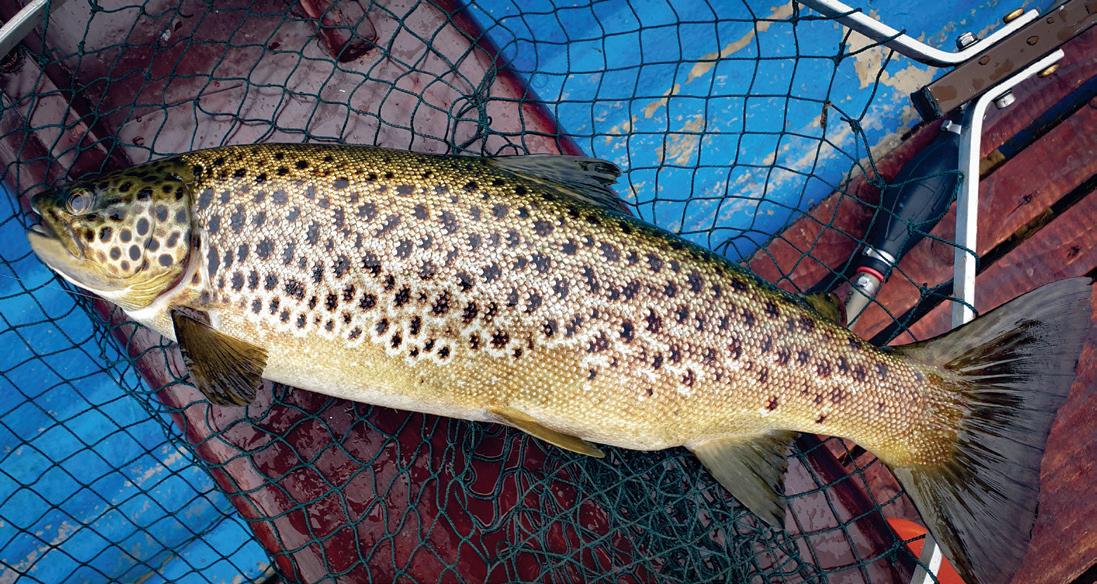
flyfishingmedia.co.uk 23
Corrib gold, nice when the plan comes together.
Get your Journal fix online
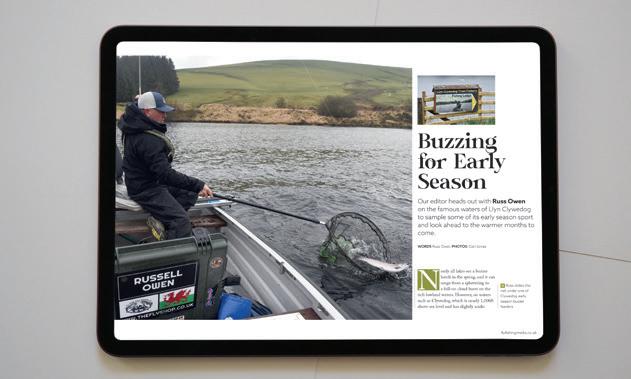
We love creating a premium-quality printed publication here at Flyfishing Journal – it’s something we are proud of. But we also recognise that some people love to get their fly fishing inspiration fix on a digital platform too. That’s why we have launched a new digital version of the Journal that is available to buy on your computer or smartphone.
This fully searchable digital version of the magazine also allows our inspirational and informative content to be enjoyed by more fly fishers that ever before as it’s available to download anywhere in the world. Whether you’re here in the UK, in the United States, New Zealand, or Europe, you can get your fly fishing fix on your device quickly and easily.


You can buy individual issues for as little as £2 or you can sign up for a digital subscription so you never miss a thing.
Keep the tranquillity of fly fishing close at hand wherever you roam by grabbing a digital copy of Flyfishing Journal today – simply head over to www. nousmedia.co.uk and click on Flyfishing Journal in the top bar menu.
Tickets still available for River Fest

Tickets are still available for the UK River Summit and Festival, which takes place on the river Wandle in London on 21 May this year.
Guest speakers such as Penny Gane from Fish Legal, Phillip Duffy from the Environment Agency, Dr Bella Davies from the South East Rivers Trust, Lawrence Gosden from Southern Water, Shaun Leonard from Wild Trout Trust, Stuart Singleton-White from the
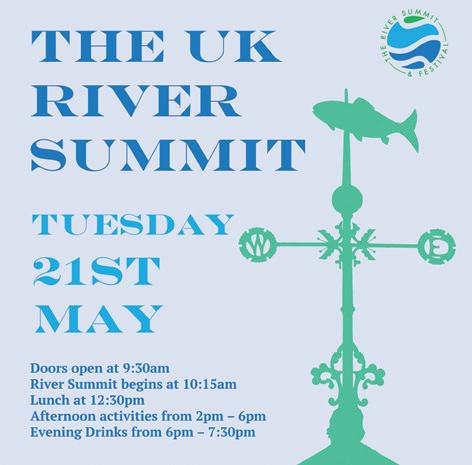

Angling Trust, and Liberal Democrat candidate for Carshalton and Wallington Bobby Dean will all be in attendance.
Tickets are still available for the event online at: D www.orvis.co.uk/products/uk-river-summit
Flyfishing Journal 24
FLY SCENE
Your Pictures

A stunning scene from Llyn Teifi taken by Anthony Pease who spent a few hours with his young son fishing there in the early season – looks a cracking spot.
@anthony__pease

Ever fancied cooking your catch? Find out to do it in style with the help of Andrej Urosevic in a new series in this very issue. Visit page 66 to find out more.
@andrejcooksfish

If you ever find yourself over in Lochgilphead in western Scotland, be sure to visit the excellent Fyne Tackle – an amazing fishing shop and you might just spot a familiar magazine.
@fyne_tackle

Regular contributor David Hoppe admiring an impressive tail – read more about it in this very issue.
@davidhoppeflyfishing

Andrew Gibson sent us some inspirational pictures to get us all excited about the new season including this mayfly that stopped by to say hello on the river Coquet in Northumberland.
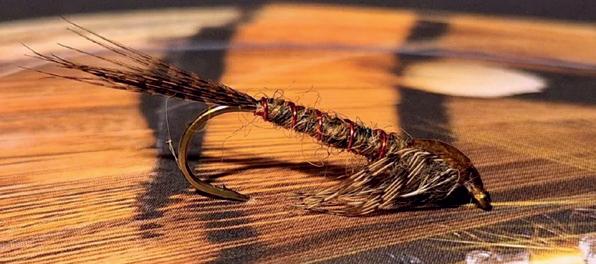
An expertly tied mayfly nymph tied at the British Fly Fair International by Kevin Sheridan –with a copy of Flyfishing Journal as the background, nice touch!
@kevinsherdian1
25 flyfishingmedia.co.uk

Long into the Evening
As the days grow longer and the season gets into full swing, we’re dreaming of long evenings out on our favourite waters in search of mythical evening rises.
FLY SCENE Flyfishing Journal 26
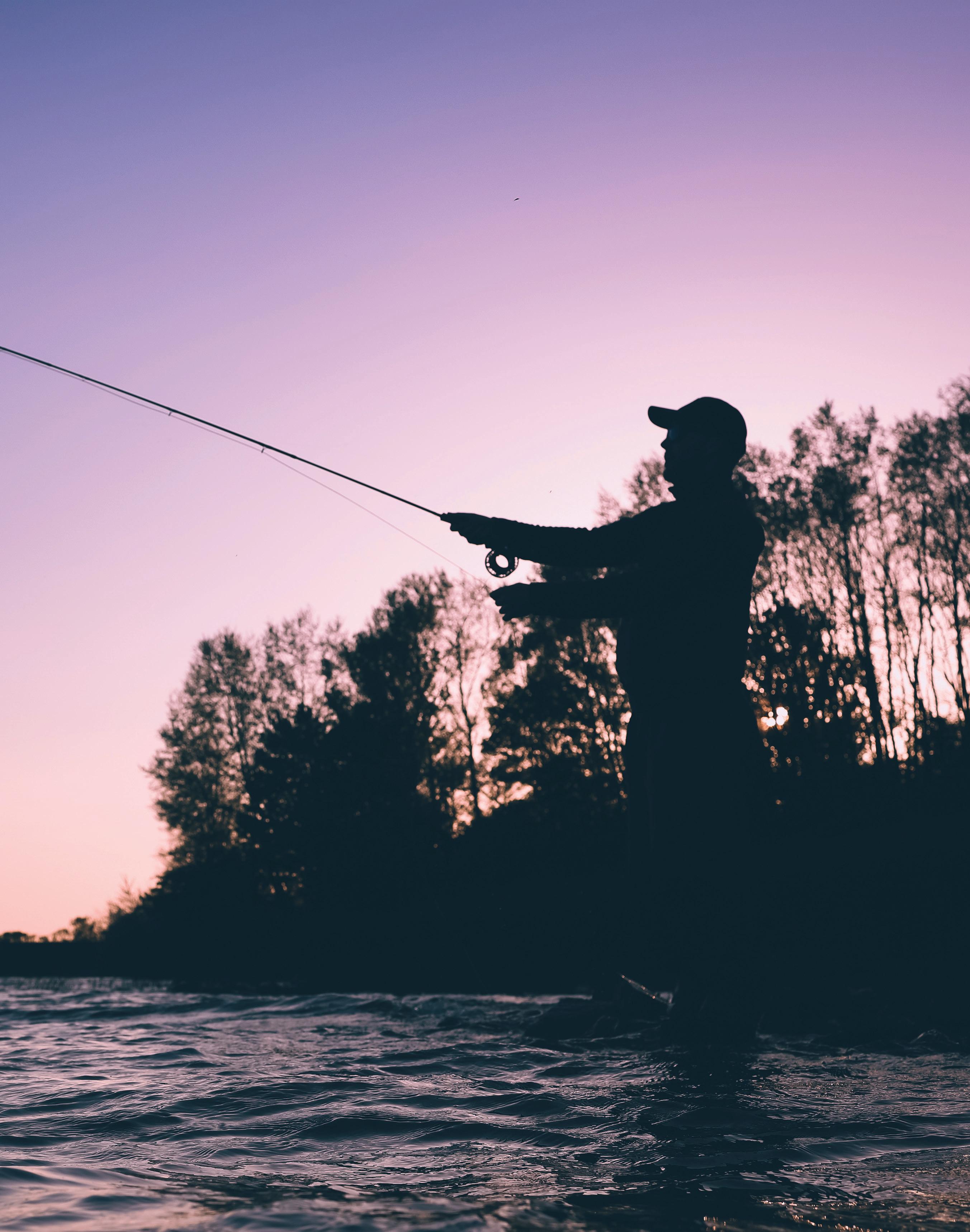
flyfishingmedia.co.uk 27
PHOTO: David Guest
My Pilgrimage to the West

Ceri Jones explains why he’s made the same pilgrimage to the west of Ireland every year for the past 30 years –the fishing, friends, and folklore are hard to beat.
Every year for the past 30 years I have gone over to Ireland for two weeks in May, and each time when I return home I have a lump in my throat. So much so, that in 2012 I went for a fortnight and stayed for two years. The
only time I missed my pilgrimage was two years during lockdown, and I missed it so much. I vowed then that as soon as the pandemic was over I was going to overdose myself fishing for the browns in the west. My plan was set into place, and I searched for a van to convert. In
A golden morning at Lough Nafooey, County Galway. One of my favourite spots to stop and make a brew.
A quick photo before returning this Corrib Ferox back to her home, magical fishing.

FLY SCENE Flyfishing Journal 28

April 2022, I bought my Toyota Hiace which was an electrician’s van, which was clean with more history than the British Monarchy – a great buy! The following weeks were spent insulating, fitting tongue and groove, electrics, led lighting, USB ports and so on. Now I was a white van man on a mission for adventure.
Three years on, I now spend a month at a time staying in my van. It’s the best thing I ever did and would recommend to anyone thinking of doing it. I base myself at Lough Corrib where I have my boat, thanks to good friend and top angler Basil Shields. During my trip
I head to Conn, Arrow and this year hopefully head over to Sheelin and then down to Currane.

THE ATTRACTION
Apart from the obvious, fishing for exceptional wild brown trout in idyllic surroundings, there are other reasons why there is such a draw for me each year to return, especially during May.
It’s almost like a festival where anglers come from all over the world and meet up. It’s incredible how a fly can bring so much joy and bring
WORDS AND PHOTOS: Ceri Jones

"YOU MEET SOME GREAT CHARACTERS TELLING STORIES OF TIMES GONE BY AND TALES OF BIG FISH HOOKED AND LOST. "
likeminded people together. Making a fire on an island ready to cook lunch is so enjoyable, and when lit, it’s like a smoke signal for other anglers to join you for a chat and a brew. I love stories, that’s why I started my podcast. You meet some great characters telling stories of times gone by and tales of big fish hooked and lost, maybe a lot are blarney but hey, it’s great to hear. While having your lunch, you often see the old fellas showing young lads how to collect the mayfly for dapping in the shelter of the stone walls and hawthorn bushes. While out with Jimmy Tyrrell recently, we went in for lunch. He started getting the food set up and I went to get the pan from the boat. Upon my return I could see Jimmy fighting a losing battle with a swan who wanted our lunch. I creased up laughing – I wasn’t sure whether to help or take a photo. The camera won – simple pleasures.
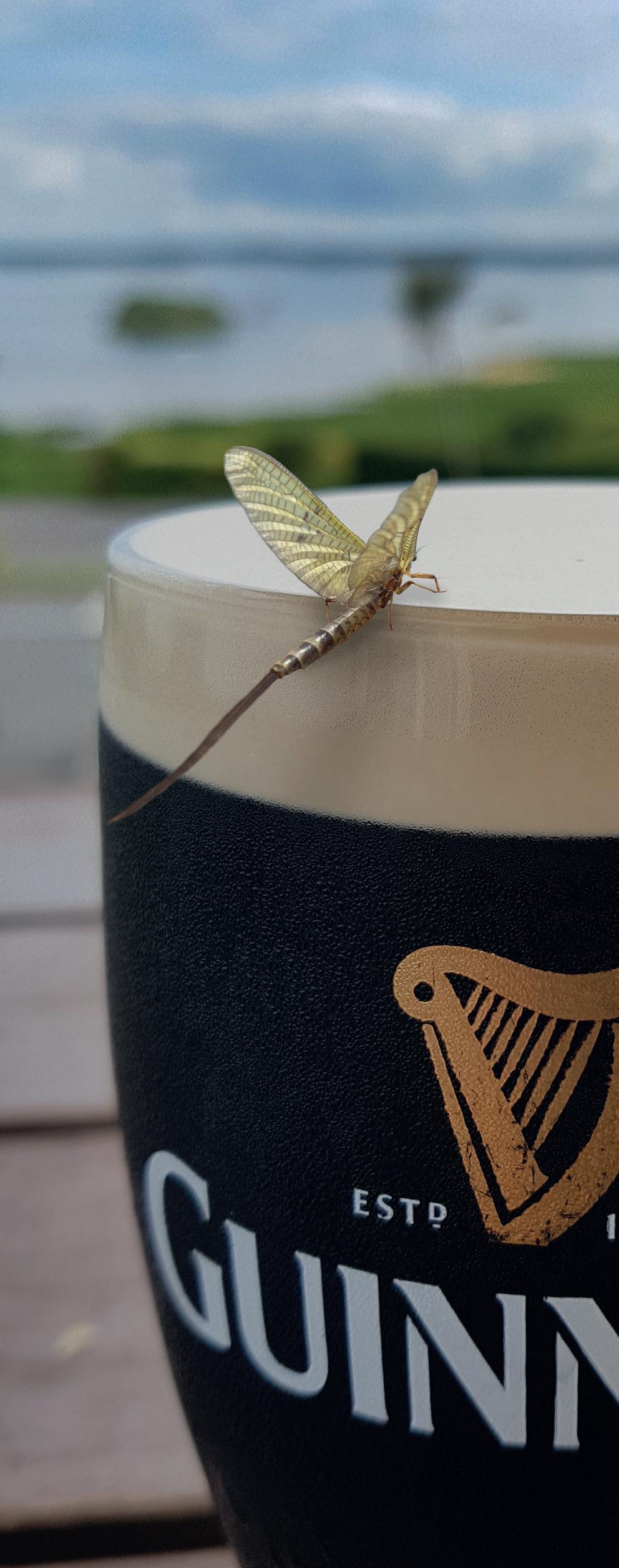
Flyfishing Journal 30
FLY SCENE
A typical alfresco island lunch.


THE CRAIC
We often hear the phrase ‘How’s the craic?’ and there is plenty to be had in the west of Ireland. The great thing I have found, there are lots of remote bars in the west and often there can be a spontaneous session with music and these nights can be the best. This is where a van comes in handy, I can now enjoy a glass or two without needing to drive anywhere – I just sleep in the van. When on the road, nothing beats waking up in the morning, sliding open the door beside a lake and making a brew.
THE FISHING
Creamy pints and mayflies at Maire Lukes, overlooking Lough Mask, does life get any better?
The fishing at this time of year, it can be great with plenty of fish looking up and a floating line is all you need, whether fishing dries or pulling wets. It can, however, be tough at times but that’s wild fishing for you. I will be spending most days on the flies but certain days when I think the conditions are right, I will be after the Ferox. I had great fish last year up to 14lb, so I’m on the case for more of the same this year.
flyfishingmedia.co.uk 31
Jimmy Tyrrell, doesn’t want to share his lunch, but this swan had other ideas.
Ceri chats with… Will Millard
Our editor spends some quality time with TV presenter, explorer, author, and passionate angler Will Millard to find out what pushes his fly fishing buttons.

Flyfishing Journal 32 RIVERS FLY SCENE
What age were you when you first got into fishing?
I started fishing at four years old, I fished with my grandfather. I had one of those Argos fishing kits, which included a metal rod. I used to sit on my granddad’s knee, we lived on the Fens, and I was very lucky that at the front of our house was a B-road and across the other side was a creek, so the fishing was literally on our doorstep. That’s where I spent my whole childhood really, learning to fish and building rafts.
How often do you get to fish?
Not often enough! I know every angler says that but at the moment it’s as little as once every couple of weeks and those are snatch sessions of maybe two or three hours in the evening. I try to fish a lot through the winter attempting longer sessions from dawn till dusk.
I read your latest book ‘The Way of the Hermit’, which mentions Ken Smith’s Loch Treig ferox –while staying with him you caught one yourself? Yes, I did. The Loch is around five-and-a-half miles long on Rannoch Moor, not easy to get to and its remoteness is part of the charm of the place. This particular day it was bright and I was fishing by a burn as it entered the Loch. I hooked this fish, didn’t get a look at it till I landed it, and thought it
might have been a pike. To my amazement it was a ferox with a head like a sheep and a kype like I had never seen before. I caught a 13lb brownie from Chew but nothing like this. I estimated 7lb – a special fish.
You have done several television documentaries, tell us more about your work?
I originally wanted to be a cameraman, but later became a presenter. I fell deeply in love with going on expeditions, my first was in 2007 travelling across New Guinea. Then in 2015, we filmed ‘Hunters of the South Seas’ where we spent three months with remote communities who have adapted to ocean life like nowhere else on the planet. In 2018 we did another BBC documentary called ‘A Year With the Tribe’ where I spent a year living with the Korowai Tribe in West Papua.
You also have a few TV documentaries on rivers and fishing in Wales too, is that correct?
Yes, the first was the River Taff, about how this river had come back from the dead from heavy
" I HOOKED THIS FISH, DIDN’T GET A LOOK AT IT TILL I LANDED IT, AND THOUGHT IT MIGHT HAVE BEEN A PIKE. TO MY AMAZEMENT IT WAS A FEROX WITH A HEAD LIKE A SHEEP AND A KYPE LIKE I HAD NEVER SEEN BEFORE."
When it all started, Will fishing with his granddad.

flyfishingmedia.co.uk
33
Is now the official media partner for

"It's really important for us to have
Flyfishing Journal involved with Fishing for Schools.
Because we need our work promoted and there is no better way!"
Charles
Jardine, Fishing for Schools.
"By becoming the media partner, we will be working with Charles and his team to encourage these youngsters to develop a new skill and enjoy being outside in wonderful surroundings."
Rob, Saara, Ceri, Flyfishing Journal.

www.flyfishingmedia.co.uk
Grab the latest copy of Flyfishing Journal for expert tips, product reviews, and thrilling stories from around the world.

As well as receiving your copy direct to your home, you can now also pick up the latest copy of FFJ at the following specialists stores.
• Farlows - Pall Mall, London
• Sportfish - Winforton, Hereford
• Orvis- Stockbridge
• Fyne Tackle - Lochgilphead, Argyll Plus, your local WH Smiths.
Find us nationwideyour next fly fishing adventure awaits!
www.flyfishing media.co.uk
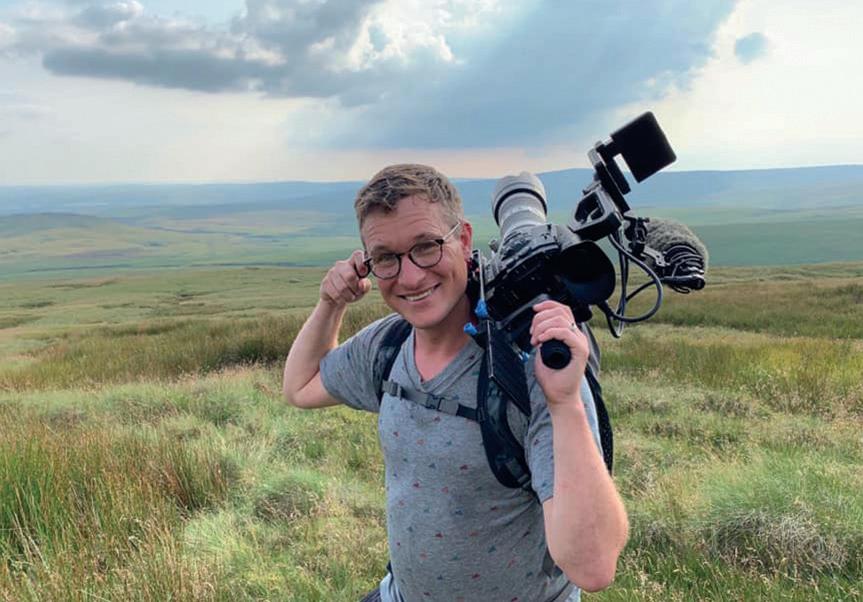
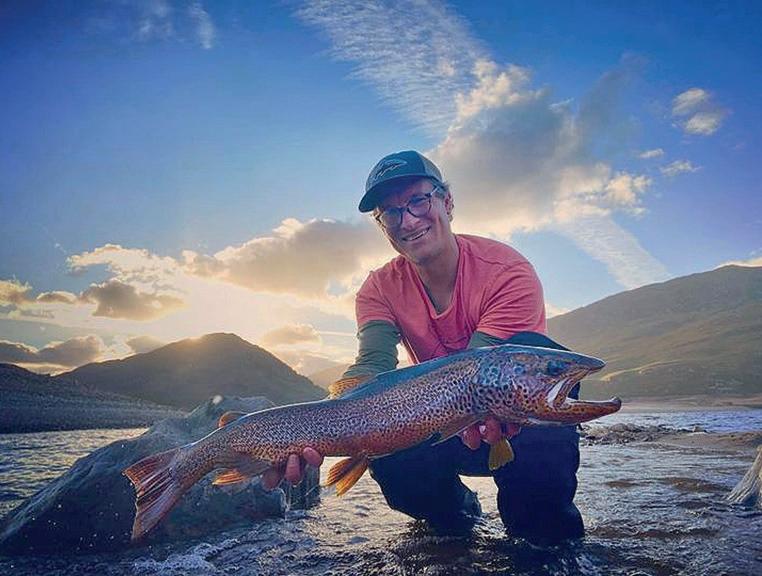
" NOW THE TROUT SEASON HAS STARTED AGAIN I REALLY WANT TO GET UP ON THE WELSH HILL STEAMS AND GET BACK TO MY DRY FLY FISHING."
industrial pollution. I also did one on the River Wye from source to sea on how it has shaped our lives. In 2019 we did ‘Go Fish’ where I sought answers to the reasons why we all look to the water to solve our problems. Fishing for sewin, sharks, giant carp, and a huge pike I caught on a South Wales lake on the last day of filming.
Are you working on anything at the moment?
I have a book coming out in May called ‘My First Day’s Fishing’. I’ve been working on it for two years, it’s a children’s book to get kids into fishing. Beautifully illustrated, I wanted to get back to that hand-drawn, Bernard Venables kind of Mr, Crabtree feel. It’s about watercraft and the magic of water. I’m really proud of it.
What is your most memorable fish?
Definitely the ferox with Ken, which was one of those times when all the elements came together – an amazing story in an incredible location. When
all those things get together, that’s what makes a memorable fish.
Have you got a goal for this season?
Now the trout season has started again I really want to get up on the Welsh hill steams and get back to my dry fly fishing. I also love tench and perch fishing, and this summer I want to head to Pembrokeshire and fish for the seabass. Last year I promised myself I would go, but this season I am adamant.
Learn more about Will on his website:
D www.willmillard.com
Listen to more of Ceri’s chat with Will on the Casting With Ceri Jones Podcast.
flyfishingmedia.co.uk 35 RIVERS FLY SCENE
Will with his Loch Treig Ferox.
At work filming on location.
Born from a love of the water and chasing the thrill of the take.

Lost Lake Fly is founded upon a dual ethos of high quality products and great value for money. High quality fly fishing essentials for a great day on the water.



Fly tying materials from leading brands.


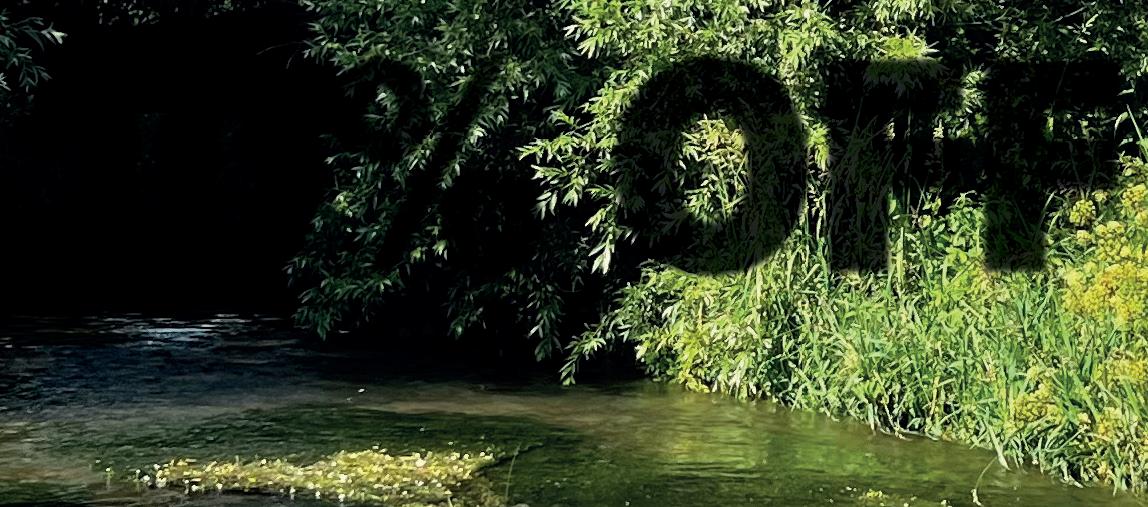






















to fly fish with us. Bespoke fly fishing experience days. Plus so
FLY FISHING AND FLY TYING ESSENTIALS lostlakefly.co.uk mark@lostlakefly.co.uk 07940 098 199 10% OFF Use this coupon and receive 10% o your next purchase* *Can not be combined with other o ers. Limited one coupon per customer. CODE: newfly10
A fantastic range of flies for stillwater, river and sea. Learn
much more!

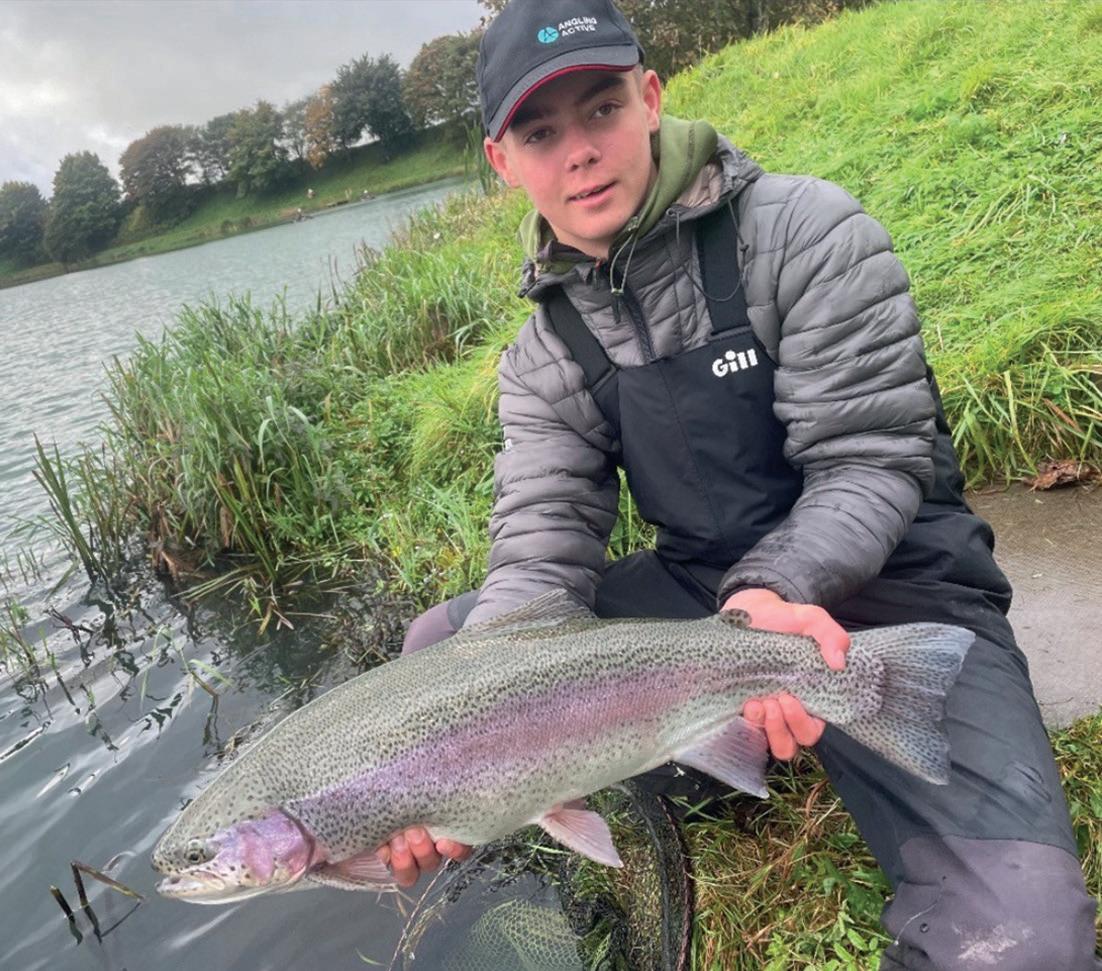
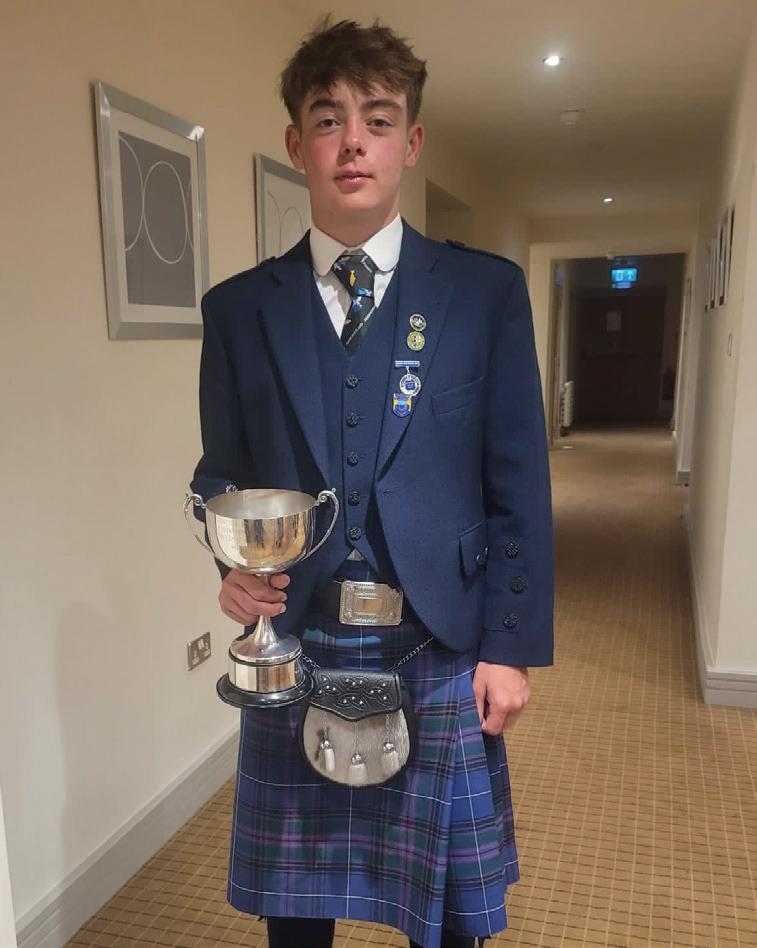
Young Angler Spotlight: Jake Gilchrist

First of all, congratulations on being part of Team Greys, great achievement. How does it feel to know your success and hard work has not gone unnoticed?
Thank you, it’s a great feeling and honour to be selected to be part of the Greys team. From day one I have used the Greys rod, which has seen me through many competitions.
You are 17 now, what age did you first pick up a fly rod and how did it all start?
I first started fly fishing at the age of nine after visiting the local fishery with my friend and his dad. Then from that day, I spent the whole summer fishing at the fishery, where I couldn’t get enough. I was so lucky to live on the doorstep of Kingennie Fishery near Dundee and to gain knowledge and
flyfishingmedia.co.uk 37
Our editor Ceri Jones chats with current Scottish top rod and Youth Team Captain Jake Gilchrist
FLY SCENE
Scottish Youth Top Rod at Llyn Clywedog 2003
Jake with a stunning 14lb Kinross rainbow.
Smile says it all, a fully finned specimen from Mentieth

tips from local anglers and staff.
What would you say is your biggest achievement to date?
To be able to fish the Spring Invitational on Rutland Water amongst the best anglers in the UK, and to represent the Scottish Youth Fly Fishing Team for my third year with the honour of becoming captain this year down in England.
How often do you get out to fish?
I use up all my free time fishing or fly tying and enjoy fishing new place mostly around Scotland, where I enjoy gaining knowledge at the local fisheries.
What is your favourite type of fishing, boat or bank?
I prefer fishing from the boat through the season on the reservoirs for both rainbow and brown trout.
When the winter comes, I do a lot of river and bank fishing as there is a lot of local competitions that run during the winter months.
What are your top three most successful flies and why?
My first go-to fly is a yellow owl as you can fish it in any size anywhere and always catch fish. My second favourite fly is a sparkly damsel for fishing the bank as again it works anytime anywhere. My third favourite fly is the cormorant as it consistently catches and when used in the right place and time can be deadly.
What are your goals for this season?
I would like to qualify for the Airflo Championships again to be able to enjoy the experience down at Rutland, learning from the best anglers in the UK. I would also like to win gold with the youth team this year as captain.
Flyfishing Journal 38 FLY SCENE







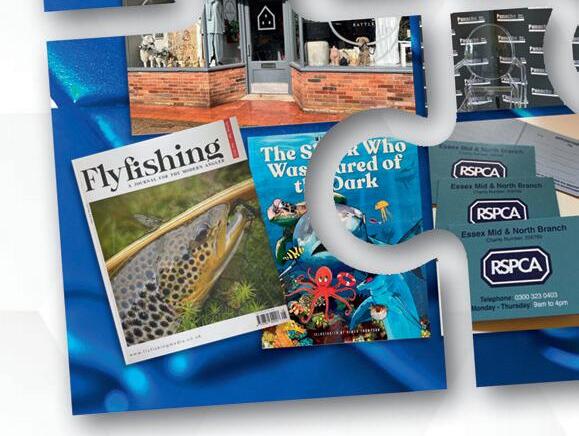


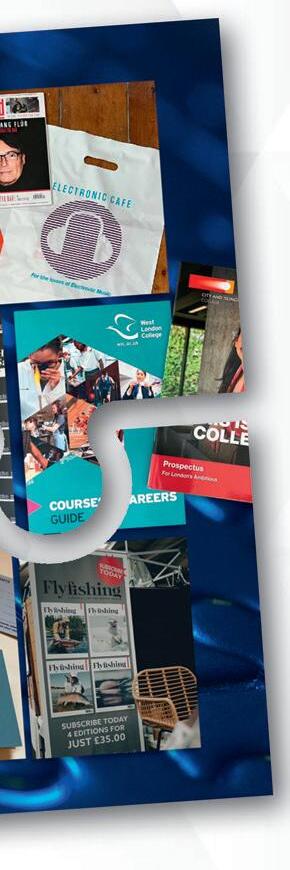












Connecting your ideas www.nousmedia.co.uk Saara Rootes J 07790 193360 M saara@nousmedia.co.uk Rob McGinlay J 07917 777721 M Rob@nousmedia.co.uk Flyers l Promotional Postcards Business Cards l Promotional Event Banners Branded Clothing l Shop Signage Tote Bags l Stickers l Packaging Print Solutions Hard Back Books l Wire Bound Books Notepads l Perfect Bound Books Layflat Binding l Thread Sewn l Saddle Stitched New Specialised Print Solutions Nous Media is commited to... Connecti n g your ideas Rob and Saara have over 30 years experience in the print, publishing and design industry. We offer our knowledge, guidance and expertise in getting your message across in many formats. We have costeffective solutions to meet your needs and budget. Contact us today
Tried and Tested
Our team at Flyfishing Journal spend a lot of time on the water, so who better to take some of the latest fly fishing products out and put them through their paces?
RAIDZAP
UV Cure Resin
Tried and tested by Alun Rees
UV cure resin for fly tying has been available for 15 years or more. If you follow many of the social media fly tying channels, you’ll probably have seen over the past 12 months a new kid on the block in the shape of Canadian company, Raidzap.
Raidzap comes in the following viscosities: super thin, thin, medium and thick. It also comes in a flex version with a variety of colours including fluorescent green, fluorescent pink, fluorescent red, fluorescent orange, black (referred to as black widow) and clear. The resin is generally available in 15ml bottles. The Raidzap Flex thick is also available in 66ml bottles; convenient, since the thicker viscosity is usually used on larger flies, and you’ll end up using more.
Each pack includes a standard nozzle, a brush for larger applications and a needle application nozzle for more precise use. This gives added value since you often have to purchase these items separately with other brands.


The recommended uses are: super thin – quills and small perdigons, thin – larger perdigons, buzzers and wing cases, medium – buzzers, heads and larger bodied flies, thick – saltwater and predator flies. The Flex version can be used to repair feathers and also in the creation of bulk head patterns where you need a good profile but still want to retain mobility in the materials. I only tested the thin and medium and found the viscosity and working time was excellent No ‘pooling’ of the resin occurred. Despite not using a dedicated Raidzap torch for curing, a variety of torches were used and left no tackiness or residue.

D www.stayhooked.co.uk
T RRP: £17.99
Flyfishing Journal 40 TRIED AND TESTED
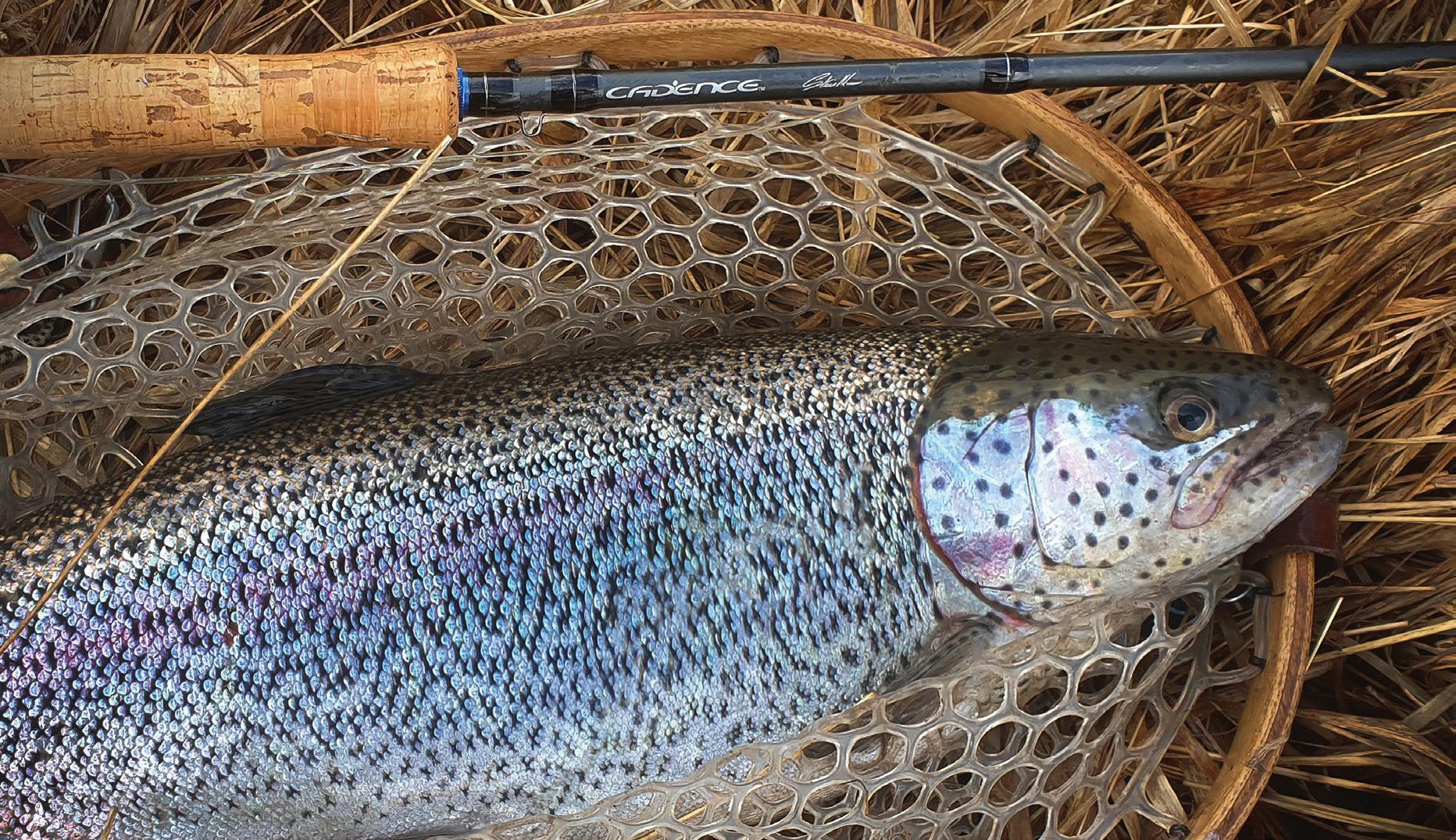
Cadence
CSM 10ft 7-wt
Tried and tested by Ceri Jones
I tried this rod out at my local reservoir on opening day this season and found it was a pleasant rod to use. Most of my own rods are a fast action but it didn’t take long to get into the swing of it as I found this rod has more of a middle action and needed a more relaxed approach. It’s very light and comfortable in the hand, it would load my #WF7 floater nicely and reaching 25 yards plus with one false cast and little effort. Even though I was testing it on my local lake from the bank, it would be more suited fishing from a drifting boat, perfect for dries, buzzers, or even pulling wets – also perfect for stillwater fisheries. A rod you could comfortably fish with all day. On the day I tried it I had a number of fish up to 5lb and it performed really well. It was then it changed its character as its strength and power came into play as it and handled the strongest fight with ease.
The four-piece blank has a beautiful mat gray finish which I like, finished with black whippings with an attractive high gloss varnish. It has sloped stripper

guides, stylish ALPS reel seat and fighting butt – this I feel does help when playing a good fish to help leverage. It also has a keeper ring at the handle. which I like – some manufactures seem to leave out these days.
The rod is designed by Irish fly caster and expert angler Stevie Munn, so you can be sure to have top product when someone with Stevie’s experience puts his name to it.
D www.cadencefishing.co.uk
T RRP: £279.99
flyfishingmedia.co.uk 41
Mackenzie
FX2 Graphene Atlas
Tried and tested by Chris Hague
Amid all my rods, the Mackenzie FX2 holds a special place as my favourite casting tool. This rod is a genuine delight, attributed to its super-light build, exquisite flur-cork handles, titanium rod guides, and an ALPS reel seat. Beyond its aesthetic appeal, this rod effortlessly manages a diverse range of lines, thanks to its impressively fast rod tip recovery speed, translating to a high line speed. The unmistakable correlation is evident – high line speed equals more distance. What truly distinguishes this rod is its ability to achieve remarkable distance with minimal effort.
The convenience of its six-piece design transforms the Mackenzie FX2 into the ideal companion for destination trips. As someone who organises annual fishing expeditions to Iceland, I can affirm that this rod takes the lead in the gear selection process. In the challenging waters of Iceland, where fishing sessions extend up to twelve hours a day, the lightweight design of this rod becomes a paramount advantage. The last thing you’d want on such expeditions is a heavy rod, making the Mackenzie FX2 Atlas the perfect choice for extended and comfortable fishing sessions.
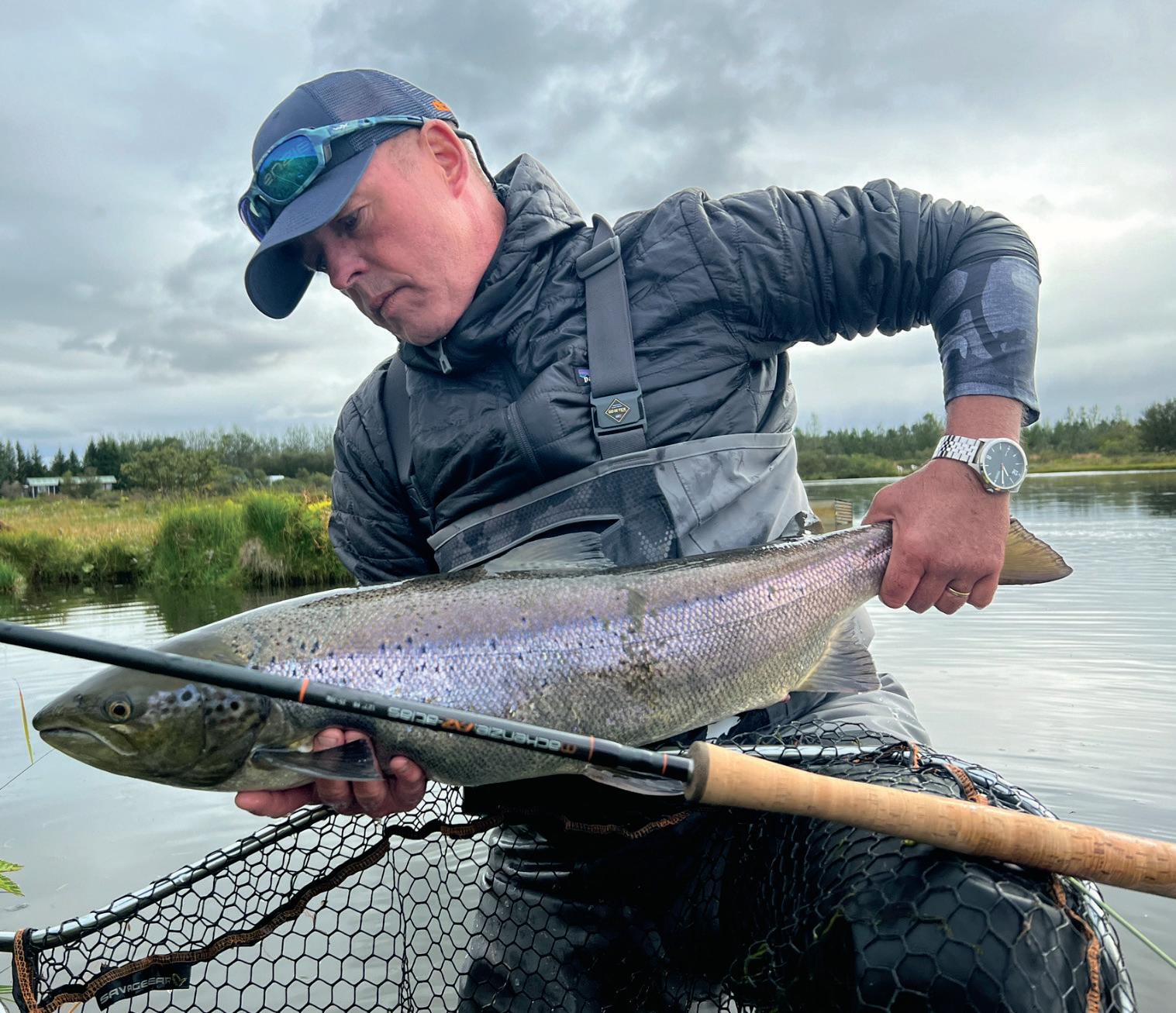
Beyond its exceptional casting ease, the Mackenzie FX2 boasts the necessary backbone to confront the formidable strength of any large fish. Its distinctive blend of effortless casting and robust strength positions it as a reliable companion when grappling with the challenges of reeling in super-strong salmon. Whether casting with finesse or engaged in a battle with a powerful fish, this rod seamlessly delivers both finesse and strength.

Flyfishing Journal 42
TESTED D www.mackenzieflyfishing.com T RRP: From £1,039
TRIED AND

Yeti
Loadout Gobox 30
Tried and tested by David Guest
Whenever I head out fishing, I tend to find that far too much kit usually makes its way out with me, which can be troublesome. I like to have every eventuality covered, but sometimes that’s not practical with a backpack or bag. The storage epiphany I needed recently hit me when I was given the chance to test out the Yeti Loadout Gobox 30.
To readers of a certain age, the idea of using a hard box for your fly fishing gear storage and transportation is as old as time (think classic Shakespeare seatboxes) – this Yeti offering gives you a similar vibe in a more modern and rugged package. The case is incredibly tough – Yeti says it’s practically indestructible – and it’s also totally airtight when sealed so no amount of dirt or water can get inside. When you open it up, the spacious inner can be organised with a central divider and a small tray,


both of which can be removed if necessary. Inside the lid, you’ll find a useful fabric storage compartment with zippered pockets that Yeti calls the PackAttic. There’s also a heavy-duty strap for this box that can also be removed.
So far, I have only used the box while fishing on the river, where it excels at allowing me to bring anything and everything I need, knowing it will be safe, although it is a little bulky and heavy for constant roving. Where I think this box will really come into its own is on a boat or bank fishing at a stillwater. As Mrs. G can testify while sunning herself on the riverbank while I fished, it makes a comfortable place to sit as well as being a beast of a storage box.
D www.yeti.com
T RRP: £250
flyfishingmedia.co.uk 43
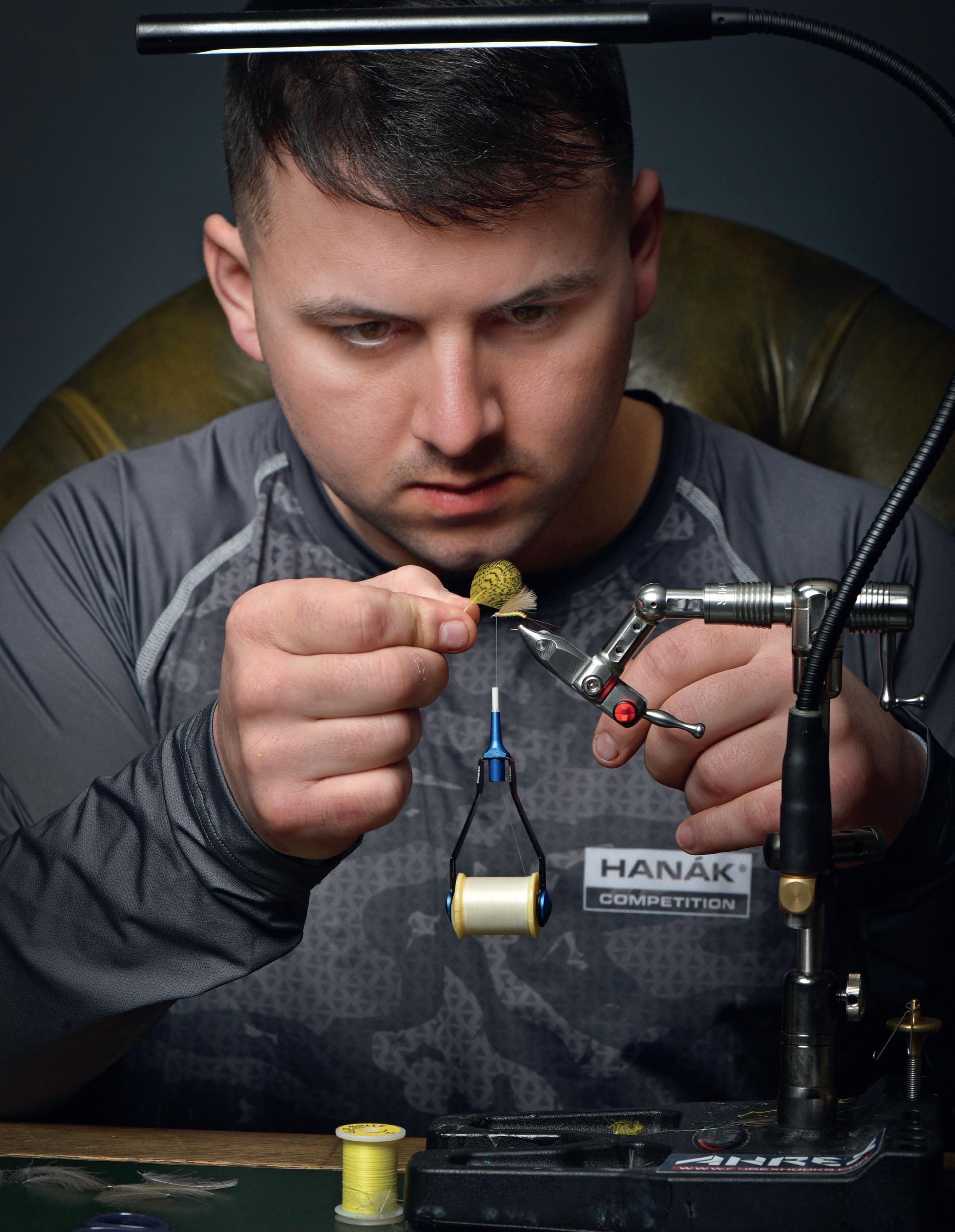
Yellow Fever
Rob Redman lets us in on the secrets to tying a fly that imitates one of his favourite hatches of the year – the Yellow May.
WORDS Rob Redman, PHOTOS: Ceri Jones
Flyfishing Journal 44 FLY TYING

Tying list
Hook: size #14 Hanak H130 BL
Thread: UNI 14/0 white
Tail: Tailing fibres
Body: Troutline kapok dubbing
bright yellow
Rib: Glo Brite no 10 (yellow)
Back rib: Camel flexi floss
Vertical wing: CDC (dun)
Hackle/legs: Partridge yellow
Thorax dubbing: Troutline kapok peach/natural fox squirrel.
Rob’s Yellow May Emerger
The Yellow May is a sight I eagerly anticipate, its striking and distinct hue never fails to capture my attention. This hatch typically graces the waters from mid-May to July, subject to the prevailing temperature and conditions. Immersing myself in the observation and study of aquatic insects is a passion of mine as I am fascinated by the intricate details and seek to unravel the secrets of the trout’s diverse culinary choices.
The Yellow May is a stone clinger that offers valuable clues about its habitat requirements. Thriving in fast-flowing and turbulent waters, this hatch can signal a feeding frenzy for the trout. As the nymph makes its ascent towards the water’s surface, the anticipation builds until it breaks free
in a sudden burst, launching itself into the open air.
The fly pattern I’ve meticulously crafted mimics the emergence of the Yellow May, striving for accuracy in capturing the insect’s profile. Speed is of the essence, as trout are quick to discern the vulnerable stage of the dun before it fully emerges. By presenting a fly that mimics this critical moment, I aim to entice the trout with minimal effort, tapping into their instinctual feeding behavior.
In crafting this pattern, I adhere to the theory of covering various stages of the hatch with my dry flies. Depending on the stage of the hatch will determine the style of pattern I chose, I utilise patterns such as paraduns and split wings to represent the dun.
flyfishingmedia.co.uk 45


1
Start by securing the thread and creating a smooth thread base along the body, extending it about a quarter of the way around. Secure two tailing fibres and loop the thread under the tail to elevate it before returning to the midpoint.

2
Attach the Camel flexi floss followed by the yellow Glo Brite rib on top.
3

Guide the thread down the body, incorporating both materials simultaneously, and halt at the tail fibre’s base. Apply a small amount of kapok bright yellow dubbing to the thread, forming a thin dubbing rope that tapers naturally with additional dubbing.
4

Carefully move the dubbed thread up the body, creating distinct segments leading to the front of the hook shank, stopping around 4-5mm from the eye.
5

Take another small amount of kapok dubbing, this time in a peach/orange shade, and add a few turns to accentuate the thorax with a hint of colour.
Flyfishing Journal 46 FLY TYING
6

Fold the Flexi Floss back over the body length and secure it at the front, mimicking a natural tone.
9

Select a yellow partridge feather with fibres approximately the length of the body and secure it by the tip with two or three turns.

12
Begin winding the dubbed thread, twisting the dubbing with your fingers as you progress toward the eye, leaving about a millimetre of space before reaching it.

7 8
Wind the yellow Glo Brite up the body in open and touching turns, creating around seven ribs before securing it.
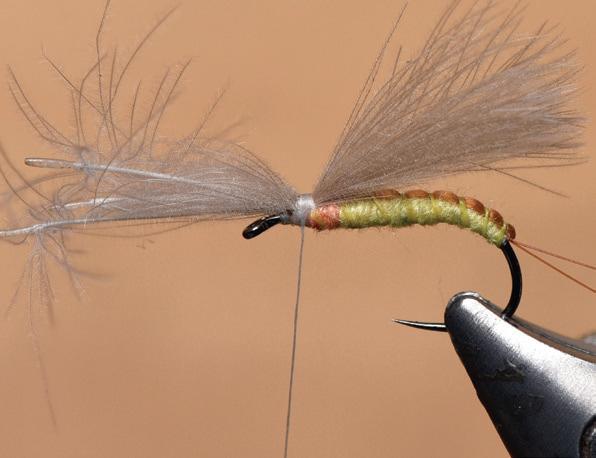
Pick three dun CDC feathers, align the tips, measure the desired length (slightly beyond the hook shank), and secure them in place.
10

With your hackle pliers, make a single turn of the hackle to simulate the legs.
11

Take a pinch of natural fox squirrel dubbing and loosely apply it to the thread.
13
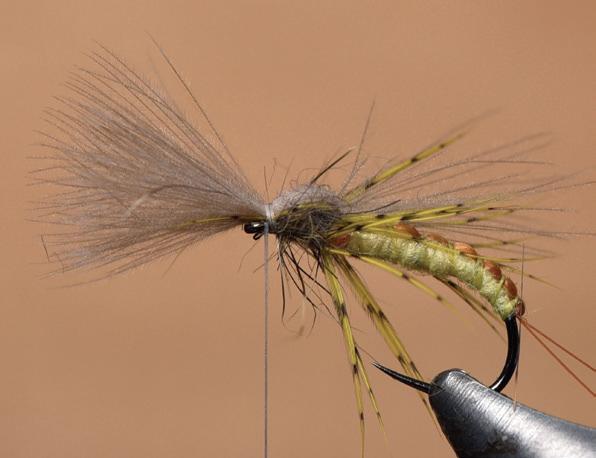
Grasp the CDC feather tips and fold them over the thorax, securing them with two turns. Lift the CDC at this point, apply two tight turns underneath up to the eye, then perform a whip finish.
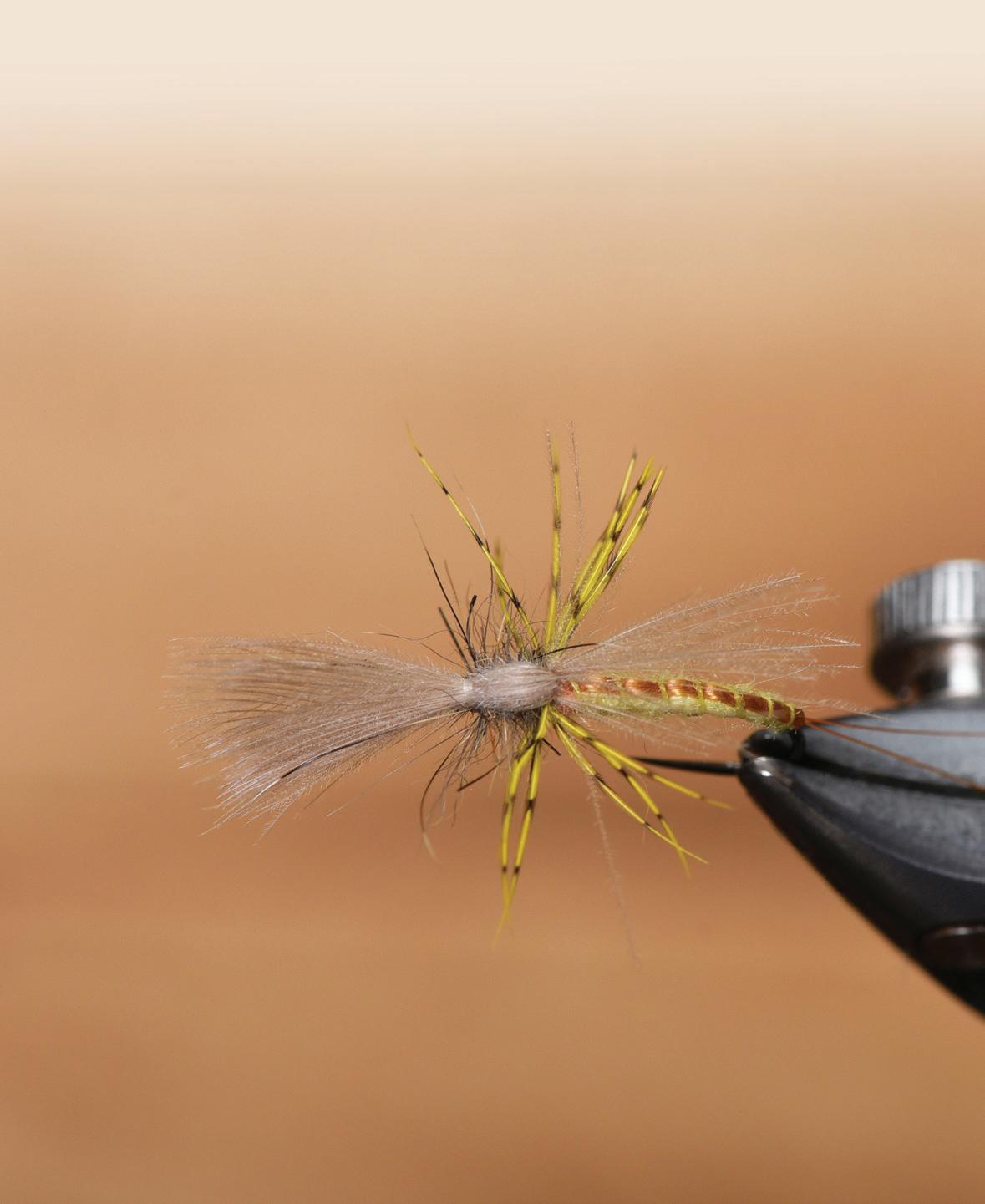
14
Utilise a dubbing needle to neaten up the fly, ensuring the legs are evenly dispersed. Brush out the fox squirrel dubbing for a more attractive appearance. Your fly is now complete!
47 flyfishingmedia.co.uk
A Well-Kept Secret
Mauritia Kirchner takes us into the relatively unknown with a trip to chase the stunning sea trout of the Falkland Islands.

The Falkland Islands, or Islas Malvinas in Spanish, were first laid eyes on by Admiral Lord Byron back in 1765. Byron was an admiral of King George III and was nicknamed ‘Foul Weather Jack’ due to the unfavourable sailing conditions that seemed to follow his voyages. He was immediately impressed by the “high, jagged, barren rocks” at the north-western tip of West Falkland and by “one of the most beautiful harbours he had ever seen in his life.”
Before his departure, Lord Byron took possession of “this harbour and all these
islands” for and in the name of George III and unceremoniously and humbly named the most impressive bay in the west of the Falkland Islands after himself – Byron Sound. He dedicated the two adjacent bays by name to his king and queen: King George Bay and Queen Charlotte Bay. He then fired three gun salutes from the ship, served brandy to the crew, and continued his “bad weather” voyage.
Admittedly, when Admiral Lord Byron annexed the Falkland Islands for the British Crown in 1765, sea trout were not yet found in their waters. The stocking of
If you follow the North Camp Road to the northwest, you will inevitably pass the beautifully located Estancia with its several sections of small streams and brackish water connected to the sea.
Flyfishing Journal 48
WORDS & PHOTOS: Mauritia Kirchner
DESTINATION – FALKLAND ISLANDS
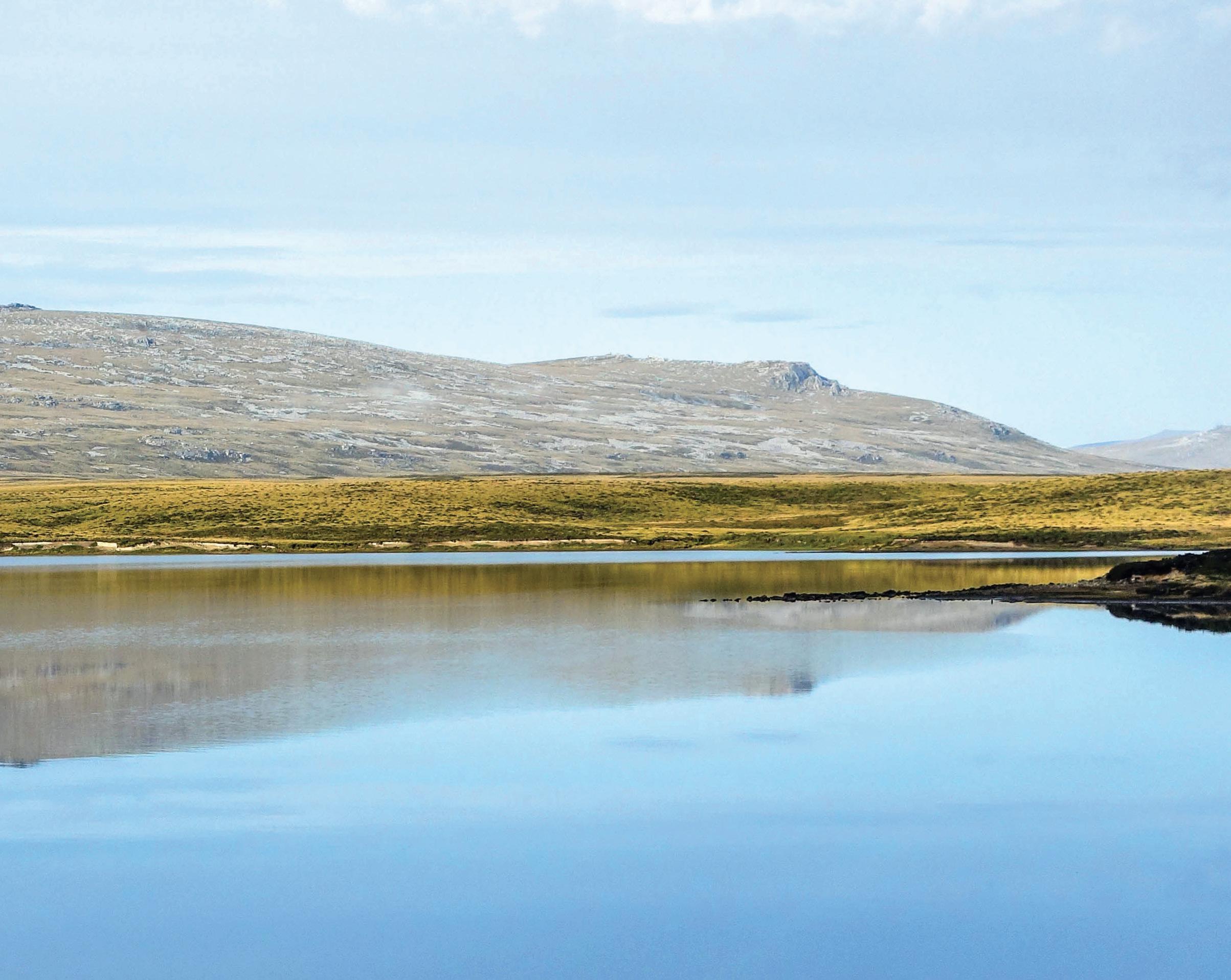
these sea-migrating brown trout (trutta trutta) in the rivers of the 12,000 square kilometre archipelago only took place in the 1950s. Without a doubt, however, Lord Byron and his crew in the 18th century would have appreciated the opportunity to compete with the well-fed and hardfighting sea trout of these waters, which are still virtually untouched and unique today – just like we do.
FALKLANDS ON THE FLY
Byron Sound, with its freshwater tributary, is certainly the best fishing spot in the

Falkland Islands, and its exact location is only talked about in secret in fishing circles as ‘The Sound’ – in the vague hope that the secret remains such. On the Falkland Islands, you don’t fish on the offshore archipelagos, as you might expect, but exclusively on East Falkland or West Falkland, and then in bays where the largest possible inflow of freshwater flows, or in the rivers.
A luxury glamping pod rented out by the landowners of the Byron Sound fishing area – which is just a 10 minutes drive away.
flyfishingmedia.co.uk 49
All rivers in the Falkland Islands are very shallow and their water levels depend heavily on rainfall. And since the islands are mostly peaty, it takes a while for this precipitation to reach the rivers. The climate of the Falkland Islands is subpolar – cold, windy, and very dry in summer. And contrary to what you might expect, it is very dry in summer. These are not good conditions for us anglers, because sea trout especially love to migrate when the water level is high. Be it for cover reasons or because they love fresh water.
Alternatively, deliberately focus on the estuary areas, and do so like the experienced anglers and rely on special moon phases with increased water levels in the tidal areas. Basically, all of these tidal areas of the larger rivers are recommended.
The best fishing spots on East Falkland at bays or in rivers are the San Carlos River, the Pedro, the Murrel, Fyring Pan, and Swan Inlet. On West Falkland the Warrah, the Chartres, Herbert Stream, and of course the Byron Sound.
When staying on East Falkland, it is recommended to follow the Stanley Town anglers and drive, so to speak, “in their cloud of dust” along the country road to the popular Pedro. This doesn’t mean intimate fishing, but it does mean a lot of

fish, which the locals also appreciate.
And when staying on West Falkland, the connoisseurs are heading towards the Sound, very discreetly of course. Everyone knows this spot should be kept under wraps because the fishing there is so outstanding. It should also be considered that the local landowners know about this gem and always keep a close eye on what is happening on the water.
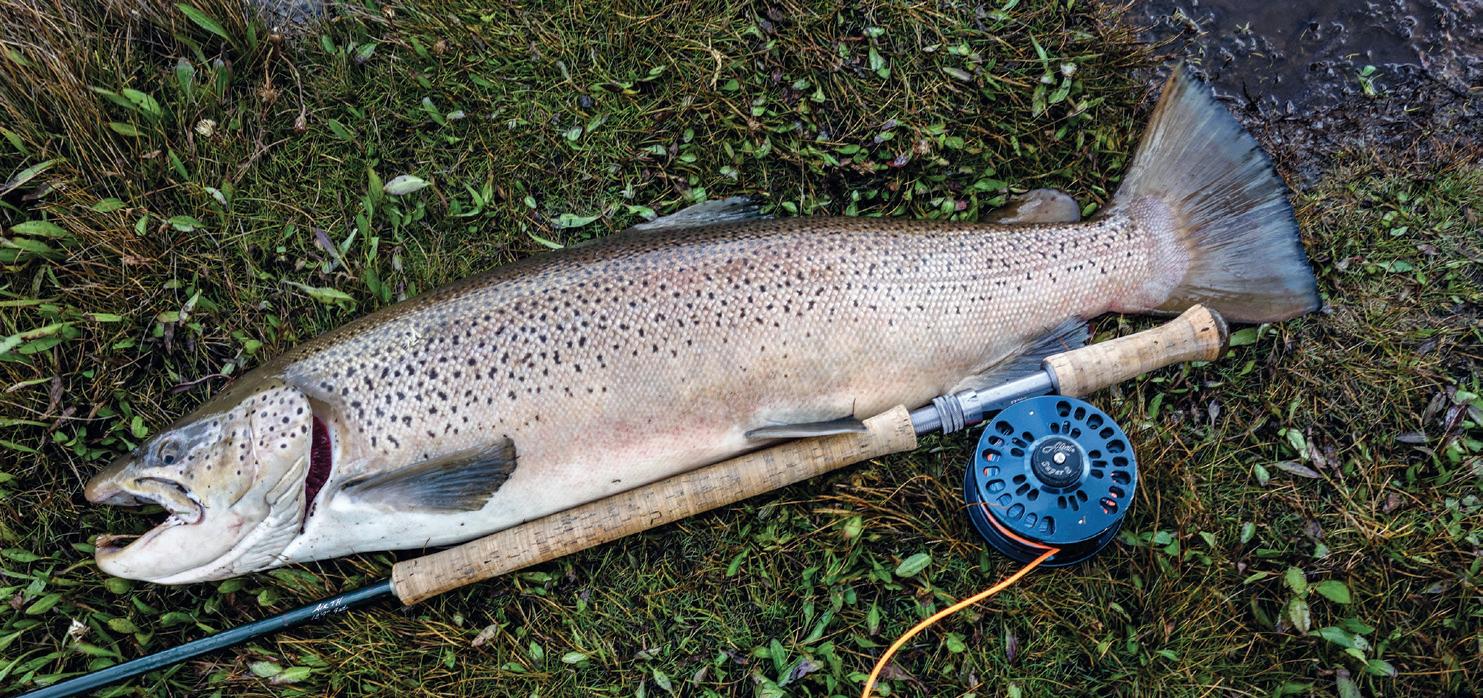
The connection between the Byron Sound tidal zone and its fresh water tributary, the Blackburn river. It is an important resting zone for the fish and a preparation ground for their mating.
A falkland sea trout in perfect condition. To compare the size: it lies next to a 12,9´ double hand rod and a #8 (ø 3.9 inch) fly reel.
Flyfishing Journal 50
DESTINATION – FALKLAND ISLANDS

WHY FISH THERE?
The question automatically arises as to why one should still undertake such a huge journey to fish for sea trout today? Why go to an archipelago just outside the gates of Antarctica, which at the time of circumnavigators and explorers seemed so insignificant that everyone was happy to be able to leave it again? An archipelago whose sovereignty changed from one nation to another over the centuries?
There are many answers to that question, the first being the reversed
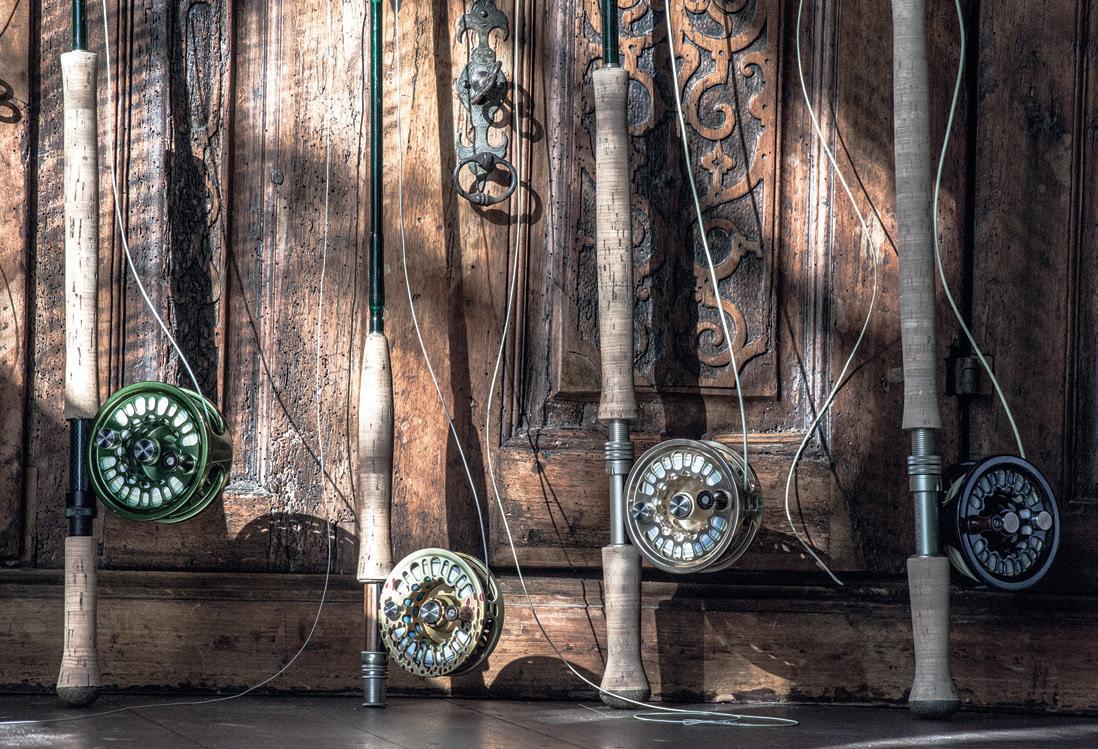
seasons. During the winter in the northern hemisphere, when the longing to swing a fly rod takes hold, you go on a plane and 16 hours later you find yourself on beautiful waters in the summery climes of the southern hemisphere.
Another great aspect of the Falklands is its price-to-performance ratio. A fourweek fishing holiday on the Falkland Islands is roughly equivalent to the cost of a fishing holiday in Iceland or neighbouring Patagonia. The difference is that you can fish there for six days (without flights) only and on the Falkland Islands, it can easily be four weeks or more (including flights, accommodation, and rental car). The well-known objection is that in those countries the fish are much larger. That may be true. But only
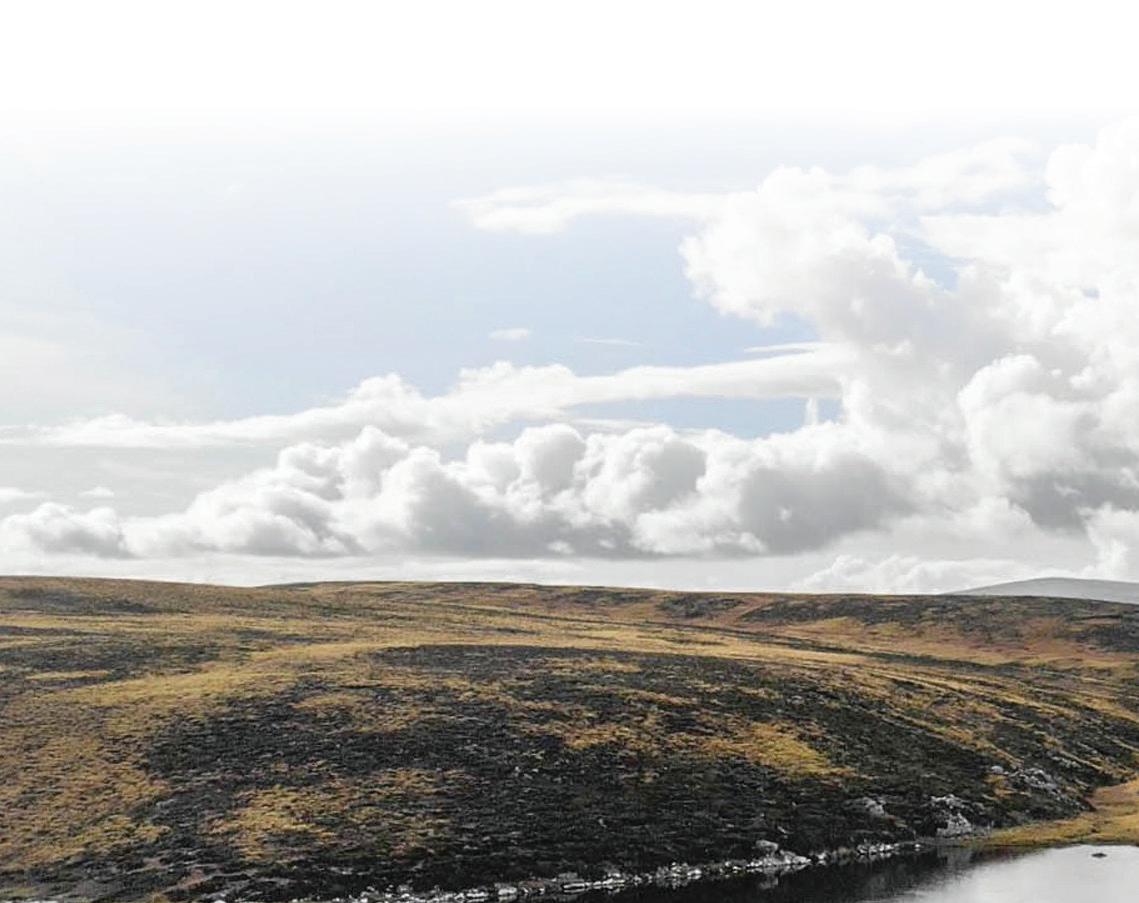
Well prepared for the fishing trip to the Falklands with single and double hand rods size 6-9. And matching Scandi or Skagit short head shooting system.
The beautiful Blackburn river feeds the Sound, and is also of great importance for the reproduction of the sea trout and the reason for them staying here.
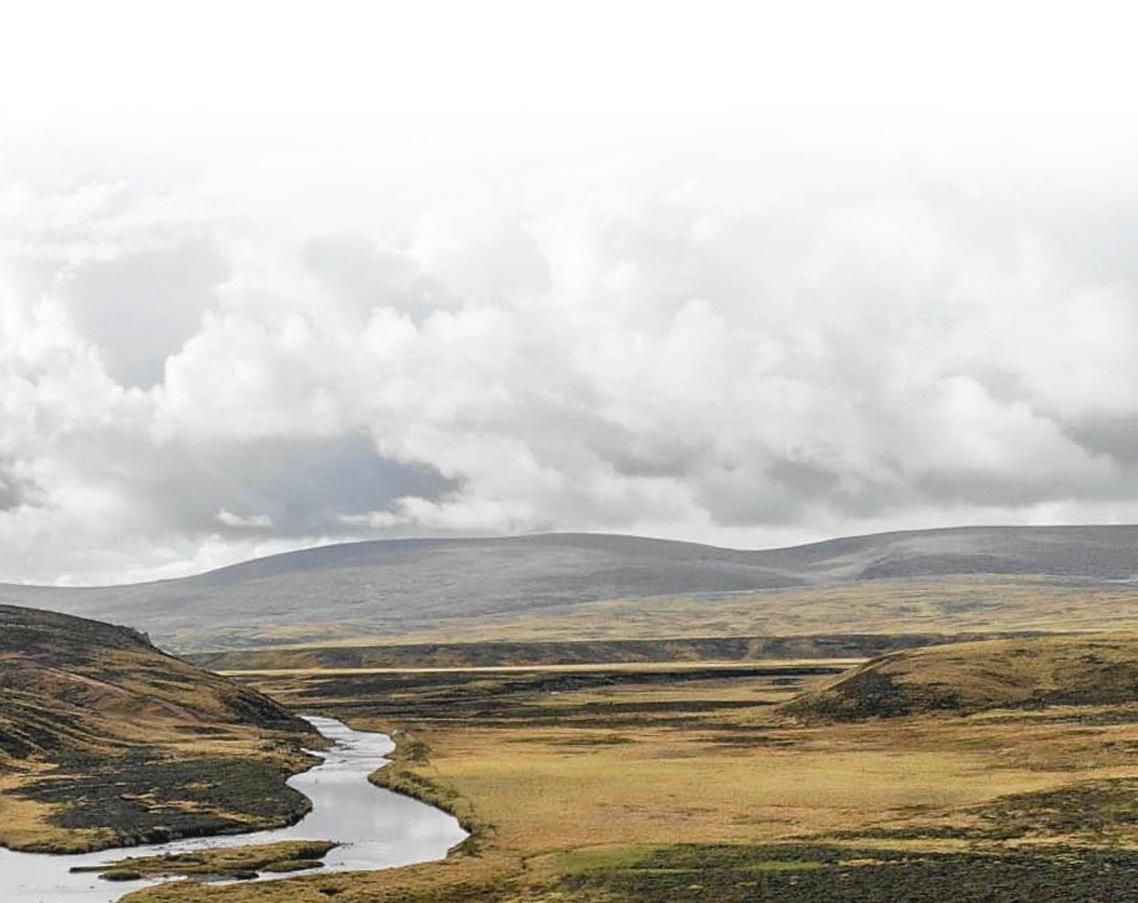


51 flyfishingmedia.co.uk
A Self Catering Lodge on East Falkland. At this location, you can't help but throw a few mouth watering Falkland Island steaks on the grill by your doorstep.

Mauritia with a nice 11 pounder. Almost all her fish were caught on single hook trout flies, size 10 or 12. Like a Red Tag, fished as a wet fly (with hen hackles).
partially. There is no guarantee of catching large, capital fish, not only because of climate change, neither in Iceland nor in Patagonia. And you may come away empty-handed despite the high travel costs. During our four-week stay on the Falkland Islands, we were able to relax and select the best moments for fishing and caught over 230 sea trout. On average 6-10lb and many between 11-15lb.
Last but not least is the sense of adventure and freedom. I enjoy fishing the northern European salmonid rivers.
But you often get the feeling that there are more anglers on the banks than fish in the water. And it’s not me only who loves to be alone and undisturbed by the water.
A holiday on the Falkland Islands is like a carefree, almost relaxed expedition. With trips across vast green landscapes in an
off-road vehicle, spectacular natural experiences with regard to the Antarctic wildlife, literally limitless selection of waters with vital, well-fed sea trout. Experiences that you do not have to share with any other anglers.

USEFUL INFO
Learn more about Mauritia:
D www.mauritiakirchner.com
Other useful websites:
falklandislandsflyfishing.com
falklandislandsholidays.com
falklandislands.travel
visitfalklandislands.com
thecovefalklands.com
Fishing season:
From 1 September to 30 April.
Fishing license:
You do not need a general fishing license on the Falklands, only a fishing permit of the landowner. The prices vary a little.
DESTINATION – FALKLAND ISLANDS Flyfishing Journal 52


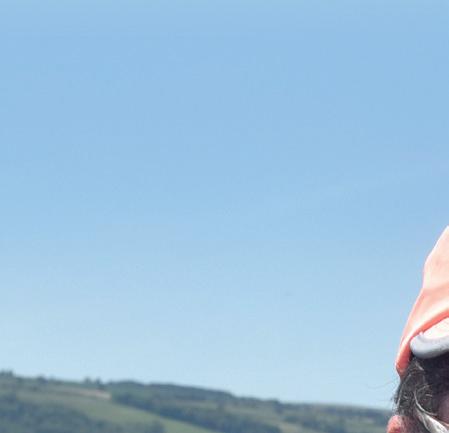

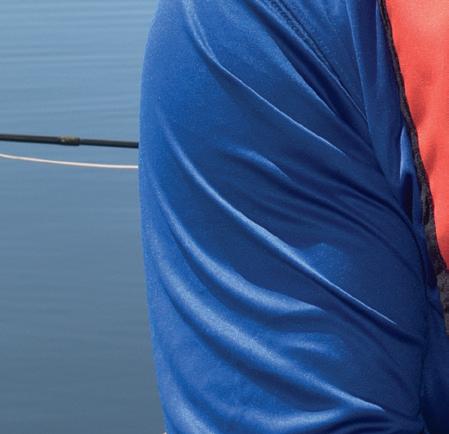



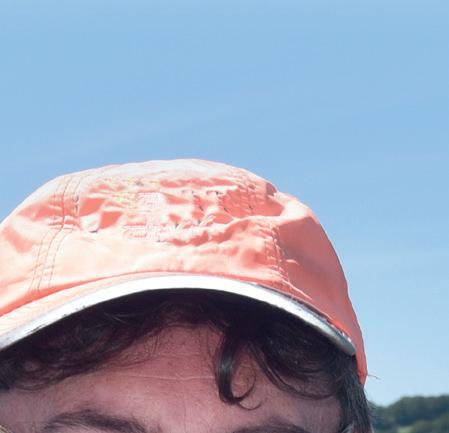






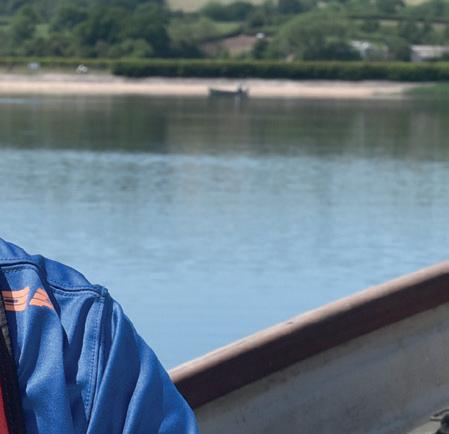




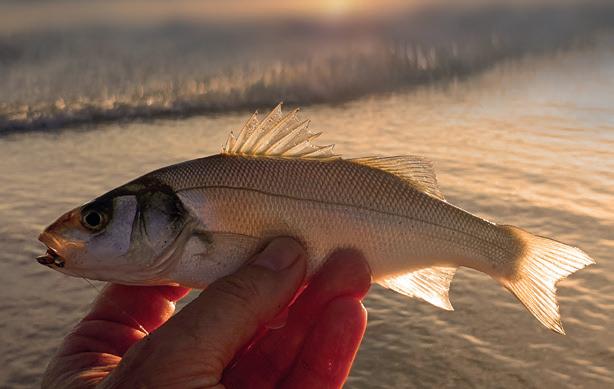
• How to beat the dog days of summer
• Sheelin’s Secrets

• Top Sedge Patterns
• In search of Bass on the fly

• More destinations to inspire
• Another tasty recipe from Andrej Urosevic
• Sea Trout summer nights
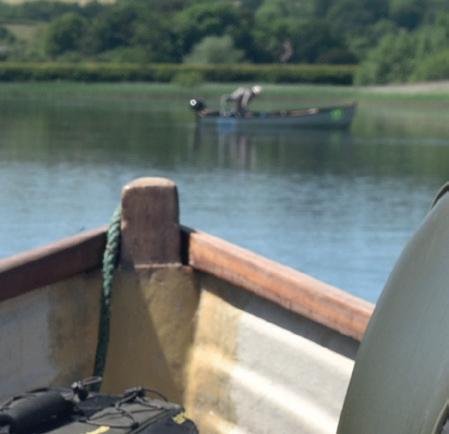




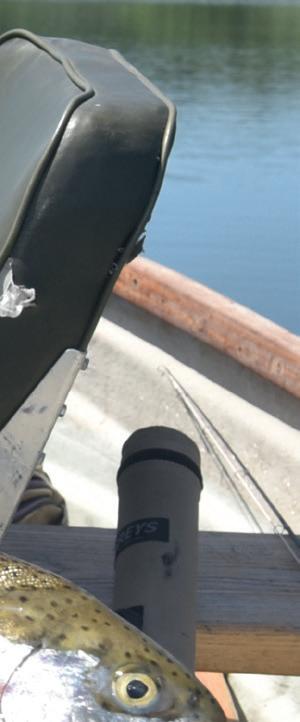
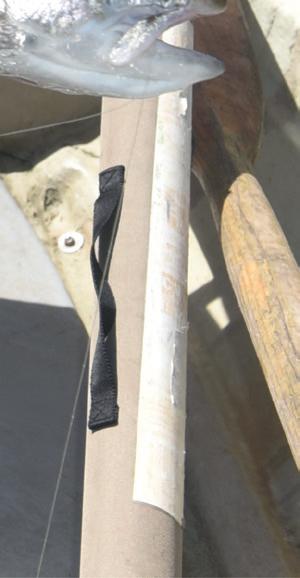
- SEPT
MUCH MORE
WHAT’S COMING UP IN THE NEXT ISSUE? www.flyfishing media.co.uk JULY
PLUS

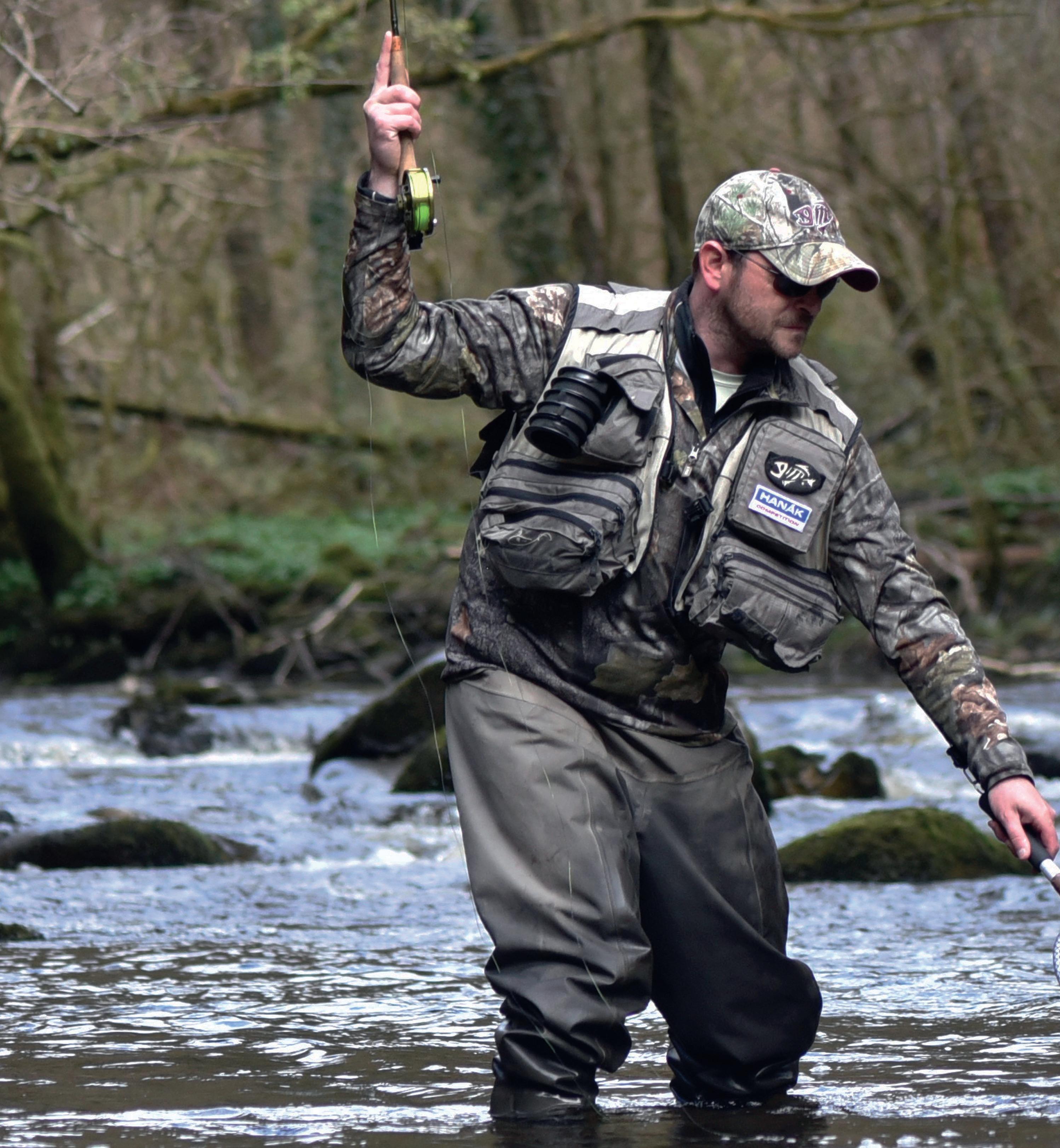
Ancient Hills and Wandering Streams

When the going gets tough and the rivers run high, those among us who seek the thrill of the take head upstream to the tributaries in search of our high.
Sean Jones explains why.

In the shadow of the Brecon Beacons, where the whispers of ancient hills speak to the wandering streams, there beholds the river, swollen and fierce, its waters considered too high for the gentle art of fly fishing for even the most bold and
Flyfishing Journal 54
RIVERS

brave of anglers. Yet, this account is not about the untameable main river, but about the tributaries, those slender veins of water that run like threads of silver through the emerald tapestry of mosses and natural lush greenery of this national park.
Despite the river being swollen beyond
what could only be deemed typical heights, making the beloved pastime of fly fishing a challenge, it was nevertheless worthy of an attempt that often warranted joint efforts when wading the turbid currents. With rods in hand and nymphs set to plumb the depths, the call was for making casts his
A feisty little brownie
flyfishingmedia.co.uk 55
WORDS: Sean Jones PHOTOS: Ceri Jones
from the tributary of the River Neath flies towards Sean’s waiting net.
into the clearer side waters, targeting the edges of the currents and the quiet rear ends of the runs. This is where the trout get pushed aside by the main river’s fury, seeking refuge in the calmer waters.
HOPE IS NOT LOST
As the river roared relentlessly, spirits began to lower. The day was still young, barely past midday, yet the catch was scarce with only a solitary fish taken from the pool’s end – falling to the regularly irresistible suspended 2.5mm tungsten beaded nymph 3ft under a dry fly. Yet, hope was not lost as we turned our gaze towards the tributaries, those that branched off the main river. There, in the quieter waters, we set upon finding the bounty we had sought after in the morning sessions. The tributaries, for me, are where the true heart of fly fishing beats – the small waterways offering solace and a chance for a more intimate experience of angling and nature. As seasoned anglers, we cast eyes reflecting the wisdom bestowed upon us by our protagonist of the waters, knowing that the swollen main river



was no place for tranquillity or feeding trout. Could this rival fly fishing at its purest? A game of wits and skill, played out in the theatre of nature’s own design – as anglers, we find joy in the challenge, the serenity, and the connection to the life that thrives in these hidden streams.
Nature began to unfold, the water’s surface broken and reflective, suddenly burst into life as countless flies rose in delicate swirls. A mixture of wing sizes catching the scattered sunlight, creating a shimmer above the flowing currents. This was the moment the river breathed, we had caught a hatch of adult olives and brook duns, an ephemeral spectacle
Decisions, decisions, Sean with good friend Thomas Willis wondering what to try next?
Flyfishing Journal 56 RIVERS
French nymphing on the edge of the turbulent water.

witnessed by the few who knew where to look. In this serene setting, the natural cycle of life revelled, unassuming yet profound beauty that brought great promises of feeding fish.
THE STORY UNFOLDS
You must move with stealth, blending in with the environment to ensure that your presence is unnoticed by the watchful eyes beneath the surface. The trout beginning to grace our nets was a treasure and certainly brought a sense of joy after the hardship of the main river.
Each cast was a story in itself, a narrative spun from hope, as the method adopted was dancing the nymphs beneath the water’s surface, tempting the trout by carefully and accurately weaving the flies beside obstacles set in the river’s everchanging and contoured riverbed.
Eyes locked on the slender indicator leader that floated on the water’s surface,
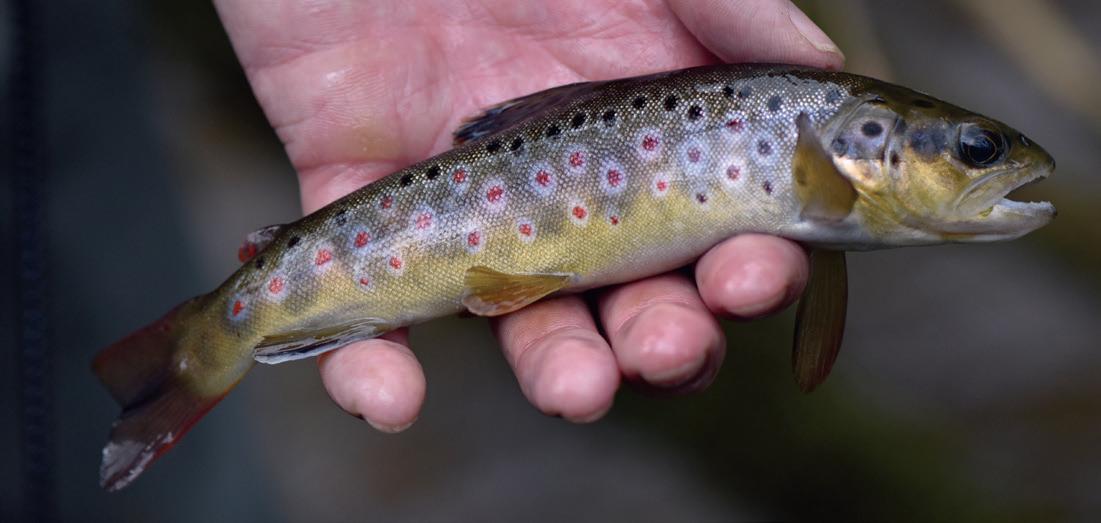
"THE TROUT BEGINNING TO GRACE OUR NETS WAS A TREASURE AND CERTAINLY BROUGHT A SENSE OF JOY AFTER THE HARDSHIP OF THE MAIN RIVER. "
patiently watching for the faintest twitch or subtlest dip that would disclose the presence of a fish below. Each ripple, each gentle sway of the line was a message to be deciphered. The takes, when they came, were nothing more than a slight hesitation in the rhythm of the water’s natural pace on the indicator, it was the right time to set the hook. Lifting the line off the water with a sense of delicacy as the tippet being used was no greater than 2.5lb in breaking strain.
In the dappled light of this woodlandsurrounded stream, we found wild trout with backs as dark as the shadowed rocks they called home beneath, the scales

flyfishingmedia.co.uk
A Brook Dunn, takes time out on Sean’s rod.
57


• Autumn 2023 issue
• Winter 2023 issue
Flyfishing Journal for only £25 BACK ISSUE SALE
Limited time only.
•
• Spring 2023 issue
• Summer 2023 issue
ORDER BACK ISSUES AND SAVE OVER £10 GET THE FIRST 4 ISSUES OF FOR FURTHER DETAILS PLEASE VISIT WWW.FLYFISHINGMEDIA.CO.UK

shimmering with mosaic artistry, the vibrant red spots surrounded by bright white rings – a stark contrast to the deep brown that leads to butter gold flanks. This elusive creature is a living testament to the beauty and complexity of the natural world, a jewel among the stones, thriving in this watery world beneath the canopy’s cover.
STAMPS IN A PASSPORT
An overdue break was in order, we found ourselves reminiscing about the elusive trout that had once straightened the ends of our lines, tales of the fish that got away, fish just beyond reach in the gorges that are unaccessible, to triumphant catches that filled from the exact same locations. These stories, backdropped by the sounds of the water and the whispering trees…
As the sun began to dip below the peaks of the Brecon Beacons, casting long shadows over the water, we reflected on the day’s fishing. The main river’s roar was a distant memory, overshadowed by the sanctuary of the tributaries and the satisfaction of the day’s catch. In working our flies to induce takes and controlled
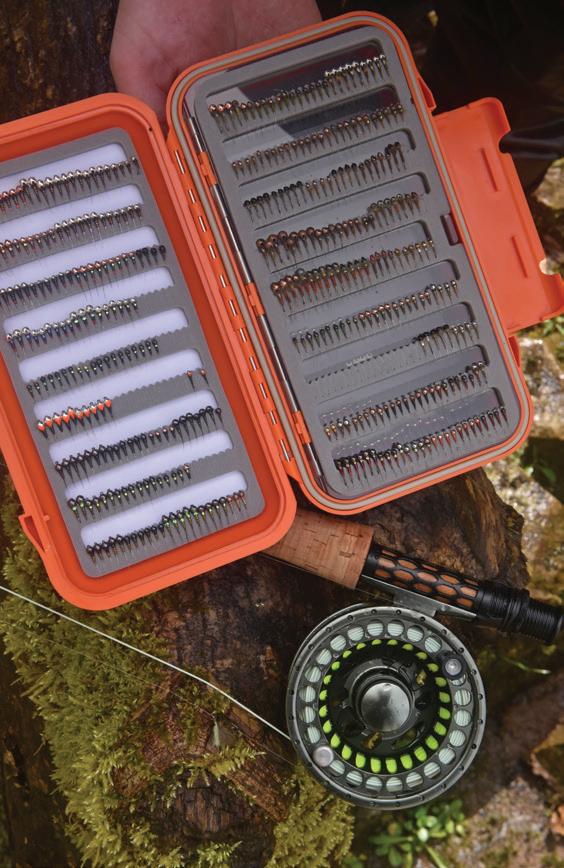
leading of the nymphs around multiple obstacles in a singular cast, fooling the wild trout that we had set out to target, we had salvaged another adventure from what would seem to be an impracticable day on the water.
And so, as anglers, we concluded the day. Feeling enriched by the streams running straight off the Brecon Beacons, our minds were already wandering to the next day, when we would again seek the wild trout together in this same location. We posed for a photograph, just as though stamping our passports, cementing the memory with a selfie. Until we do it again…
They don’t have to be big to be beautiful.

flyfishingmedia.co.uk
59
Sean looks down at Thomas, this terrain isn’t for the faint hearted.
Reawakening
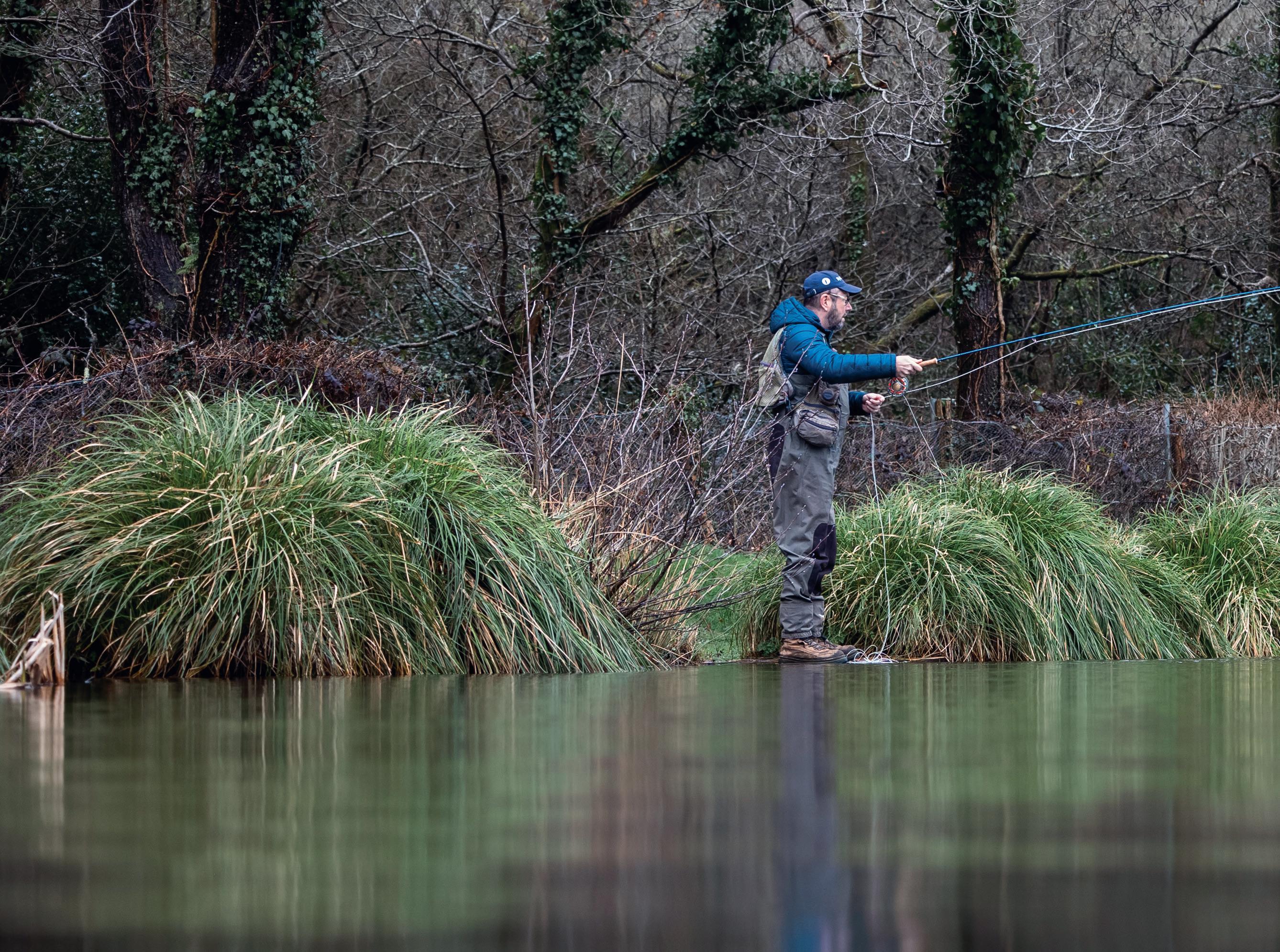
After a thoroughly depressing and soggy winter, the mere act of being out the bank again can sometimes be enough to recharge your very soul, so says David Guest.
Astate of winter dormancy in which normal annual rhythms slow the heart, breathing, and metabolic rates to a minimum and one sleeps deeply in protective quarters. This is the definition of hibernation. And with the winter we have had, I felt very much like I was crawling and grasping my way towards a pinprick of light at the end of my own protective quarters when I
headed out for my first fishing trip of early spring upon the invite of Flyfishing Journal editor Ceri Jones.
It seems pointless to dwell on the past, winter has gone now, but it has left its mark on me and many other fly fishers I know. It’s usually one of my favourite times of the year, being a keen grayling angler and fan of the finer tactics of heavy nymphing. However, this winter I was only able to find the rivers in
Flyfishing Journal 60
STILLWATERS
Flyfishing Journal editor Ceri Jones casting out at Paper Mill Fishery.
Ceri with one of several dry flymunching rainbows.

decent enough condition to fish for grayling once or twice, so never really got into my usual rhythm. My fly rods lay despairingly gathering dust in the corner of my office, longing for a break in the ceaseless rain that confined me to largely staying within four walls. But all that dark imagery from a winter of stillness was slowly melting from my being as I picked up Ceri and we headed along the M4 to a stillwater fishery of some familiarity to him, where he assured me whatever winter blues I had would be burned away like the last glistening sparkles of frost in warm sunlight. It was, however, pissing it down.
 WORDS & PHOTOS: David Guest
WORDS & PHOTOS: David Guest
61 flyfishingmedia.co.uk
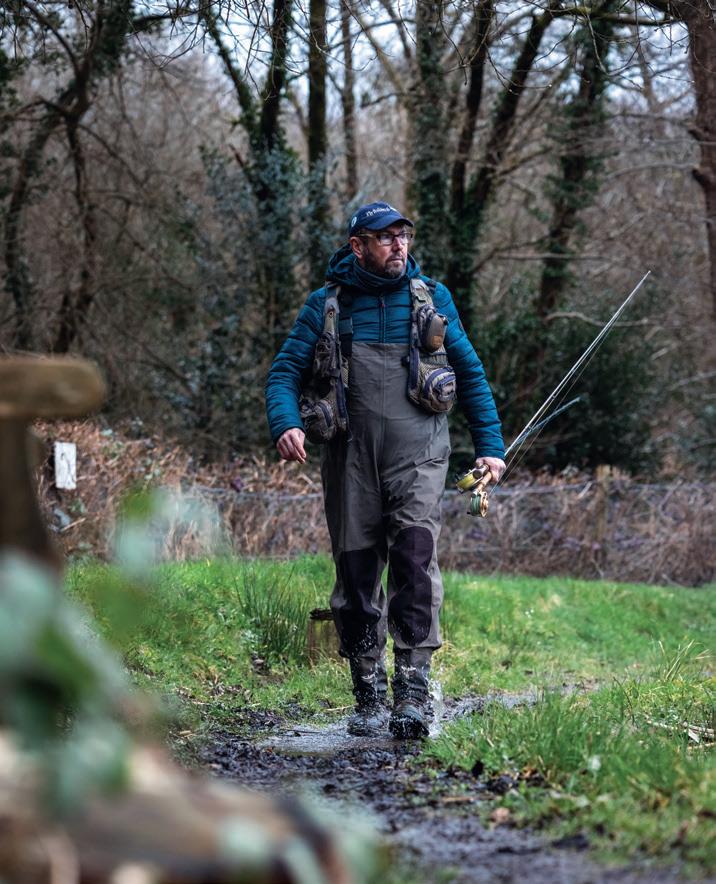

SET FOR THE DAY
After navigating our way through the spray of the motorway and arriving at Paper Mill Fishery on the outskirts of Swansea, we were greeted with sideways rain, howling winds, and a small group of hardy anglers already battling the elements in a desperate search for some fly fishing-based gratification. Our gloomy outlook was temporarily lifted by a warm cup of coffee and a friendly greeting from fishery owner Mark Vickery. We huddled inside the warm and welcoming lodge on-site at the fishery and chewed the fat over the season just gone and the one ahead. We were also able to do some literal chewing with a fabulous cooked breakfast while we waited for the worst of the weather to subside.
Eventually, the rain eased, and we summoned up the bravery to head back out to the car park and start rigging up some rods. Paper Mill is well stocked with rainbows and brown trout – and some of a very decent size, or so we were informed. Ceri had fished here before and seen some very impressive fish come out, so
that encouragement was enough for us to squelch our way through the mud to find a couple of free pegs on the far side of the lake.
If you’ve ever fished with the pressure of doing a feature for a magazine or other media outlet, you’ll know the most immediate stress is to catch something as soon as possible. Both Ceri and I were casting humongous flies with slow figureof-eight retrieves in the hopes of a fish slipping up early doors. As if the fishing gods knew that we needed a photo of a fish, we both hooked up at exactly the same
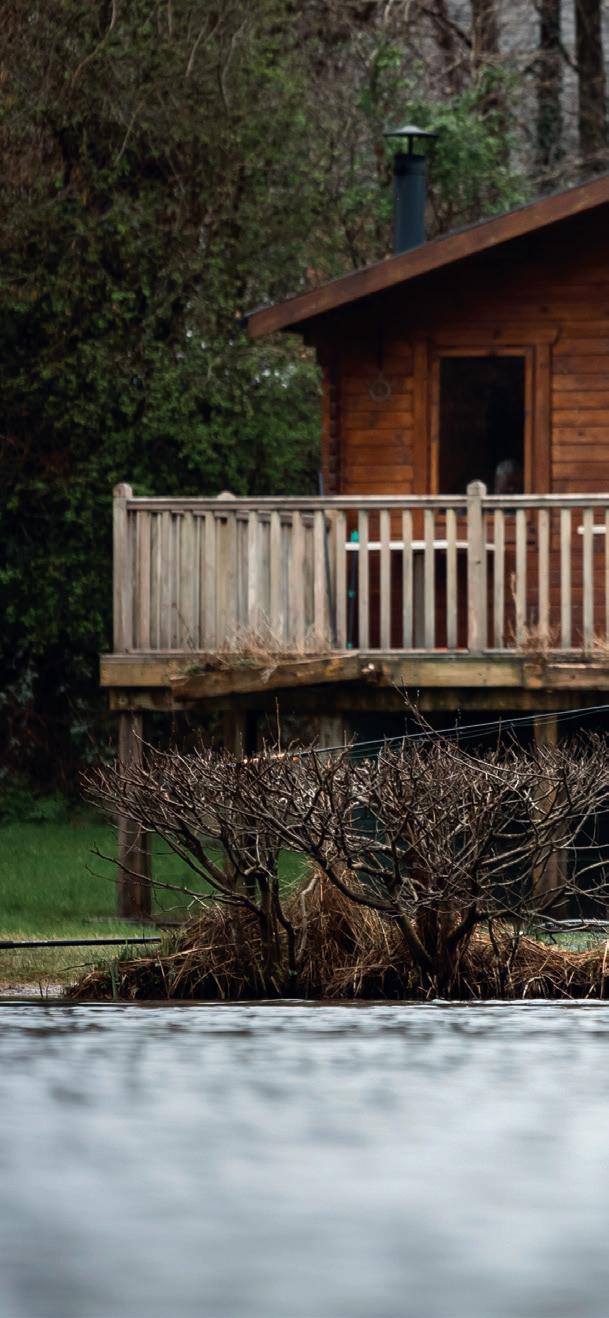
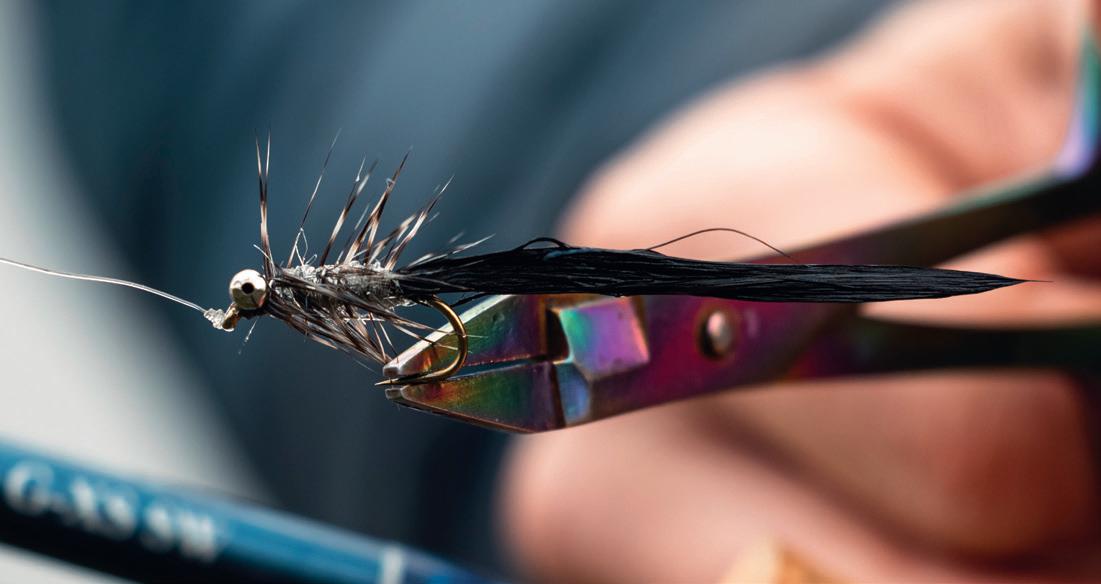
Flyfishing Journal 62
STILLWATERS
Hooking up in front of the lodge of wonderful breakfasts.
Crushing barbs, the catch and release angler’s friend.
Searching for good spots on a very wet day. Paper Mill owner Mark Vickery with his assistant Bella.
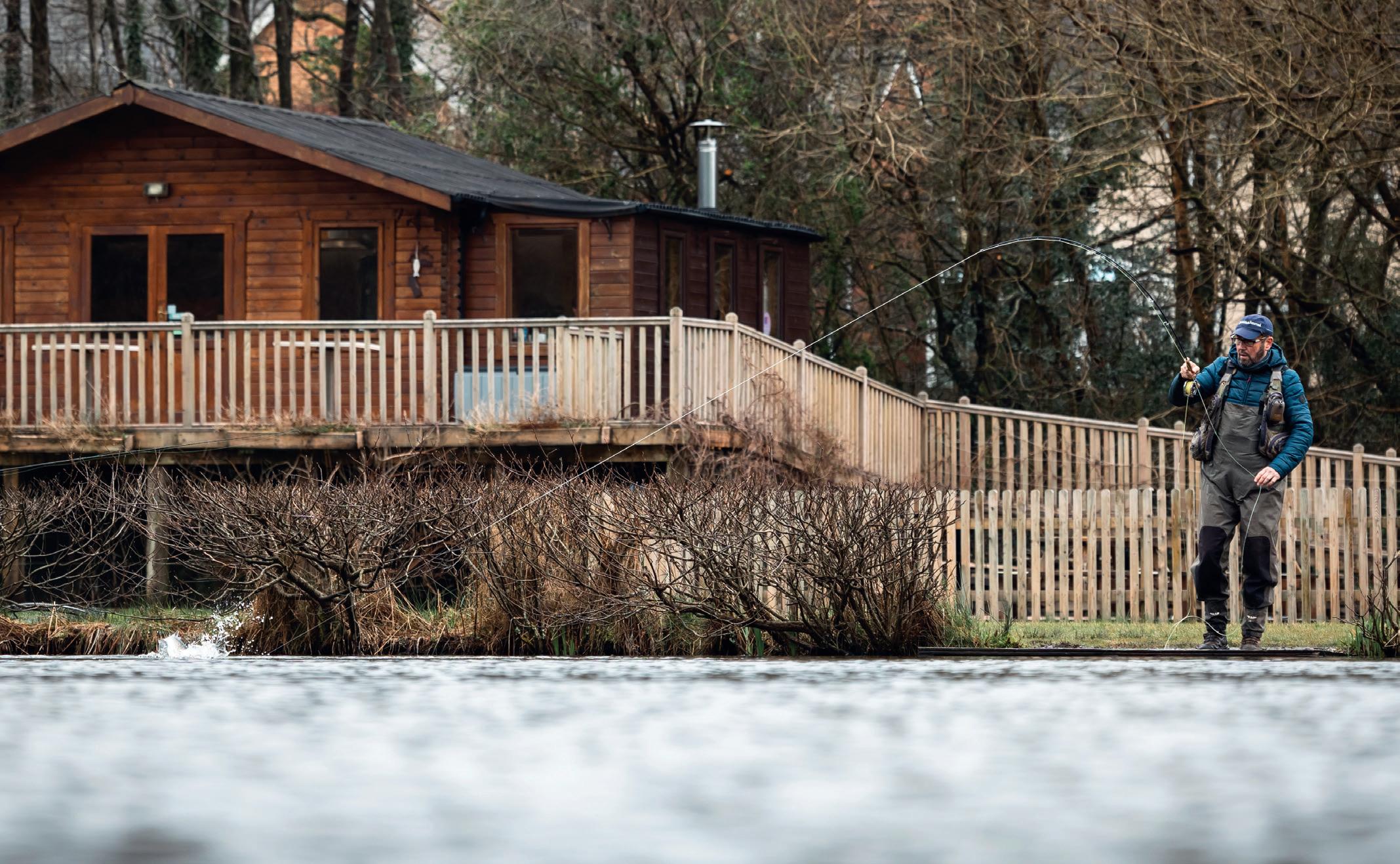
time, leaving us with the dilemma of how to photograph a fish when we were both playing one. Thankfully my first fish of the day was only around 2lb and was returned quickly, leaving me free to slide my way over to Ceri and get a look at his larger, and rather stunning rainbow.
A MOVEABLE FEAST
After that early explosion of excitement, things quietened down as we both struggled to get another take. Ceri switched to some buzzers, a staple food source at this time of the year, while I persevered with larger flies. As we moved around the lake, I thought that my post-hibernation euphoria from being out fishing again was playing tricks on me. Did I just see a fish rise? Yes, I did. And there was another. They were looking up.
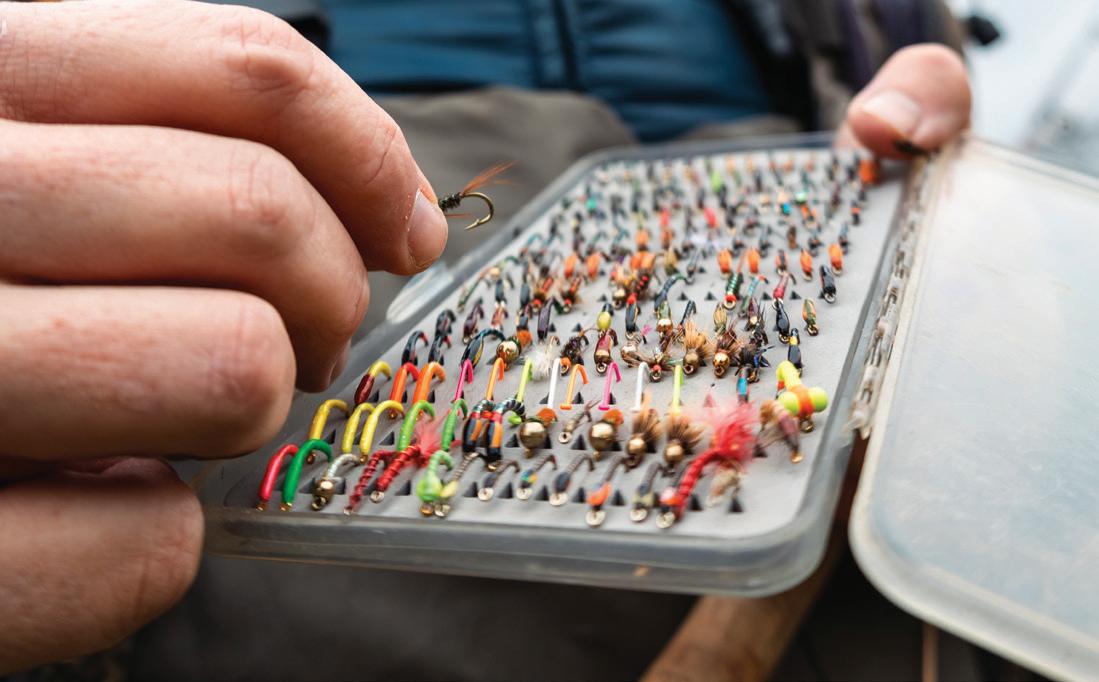

63 flyfishingmedia.co.uk

"WITHIN SECONDS OF THE FLY HITTING THE SURFACE OF THE WATER, A FISH SMOTHERED IT WITH SOME AGGRESSION. A HEALTHY AND SPUNKY RAINBOW CAME TO THE NET. NOW I WAS WARMING UP. "
“Stick a dry on,” Ceri shouted over to me, half-joking, half offering serious angling advice. So, I did. I plumped for a Shipman’s, mostly black in colour with flecks of green in the body (this first trip out made me realise my fly arsenal needed some reinforcements), tied it on and applied some floatant. Within seconds of the fly hitting the surface of the water, a fish smothered it with some aggression. A healthy and spunky rainbow came to the net. Now I was warming up.
I missed a few more takes after that, mostly from not fully paying attention, my concentration levels were clearly as rusty as my casting was. In my defence, I spent a lot of my day enjoying one of my other favourite pastimes, photography. And I was now snapping Ceri enjoying regular action on the dries too. When we arrived on this
wet, miserable, and grey day, I really didn’t suspect we’d be picking them off the top with such ease. Just as soon as it began, it stopped. A cold wind began blowing in from the east and the fish instantly headed down to the depths.
EXPECT THE UNEXPECTED
One of the things I had forgotten about fly fishing during my preservative slumber this winter was that anything can happen, and usually, the most special things happen when you least expect it. All day, Ceri had mentioned how there were some big browns in this lake and that they usually congregated in certain spots around the edges under overhanging trees. I had taken this information on board but not given it much more thought, not consciously anyway. However, at last knockings, I

Cast master sends an intermediate line out into the lake.
David ended the day with this unexpected and splendid brownie.
Flyfishing Journal 64 STILLWATERS
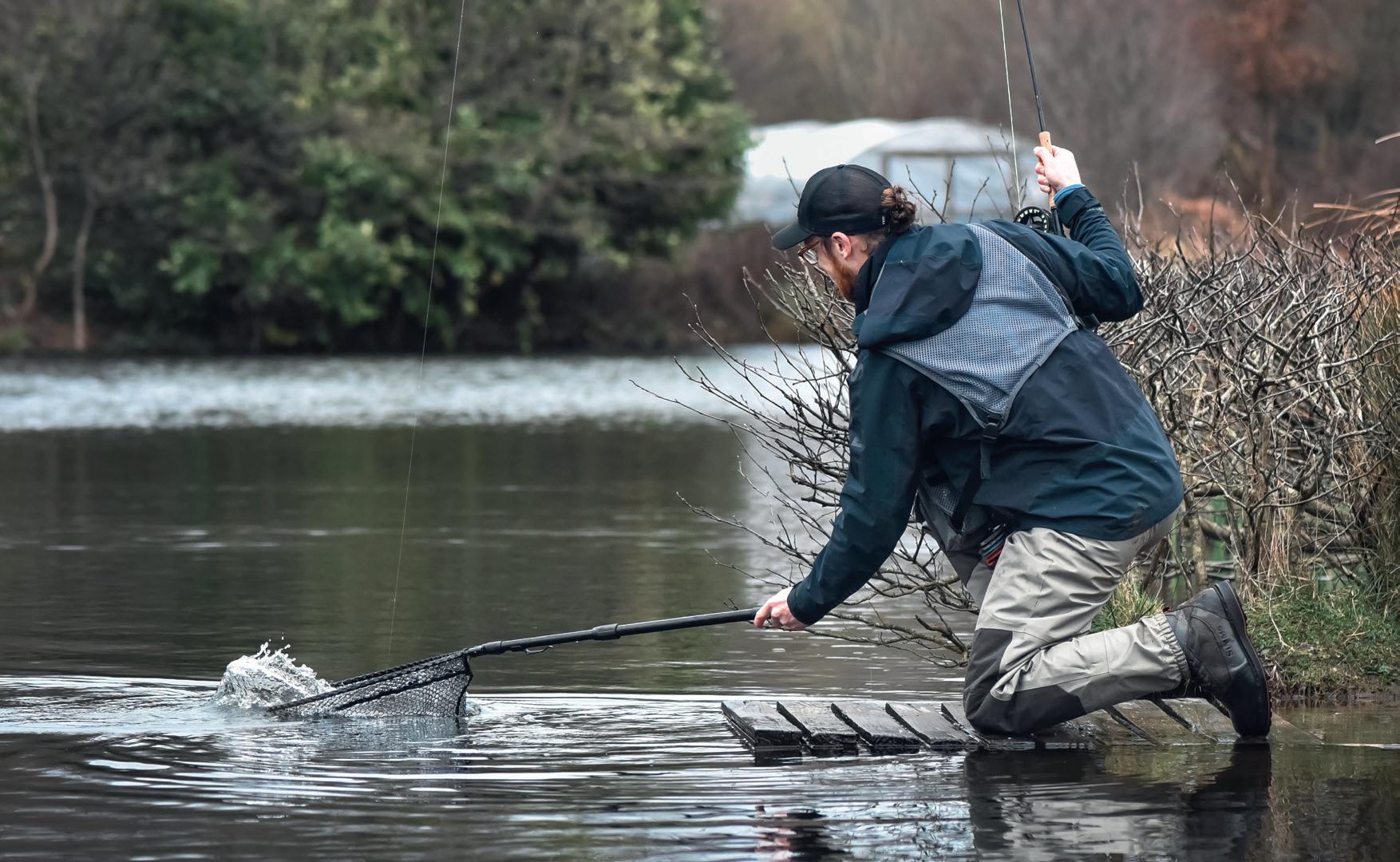
found myself back on the humongous casting along the edge of the bank to some such areas. I changed colours and outlines multiple times, not really sure what I was trying to achieve when suddenly my line was almost ripped from my hand. A superangry take had just happened not far from under my feet, and I was thrown into battle. That battle ended with me landing one of the biggest brown trout I’ve ever seen with my own eyes, let alone caught. After a few quick snaps of this brute and carefully
releasing him back, I felt like the whole experience was shrouded with a haze not unlike the one of my winter hibernation. But now everything was coming into focus. If my hunger for the new season had not been ignited before, it certainly was now.
I’m looking forward to a season of being wide awake.
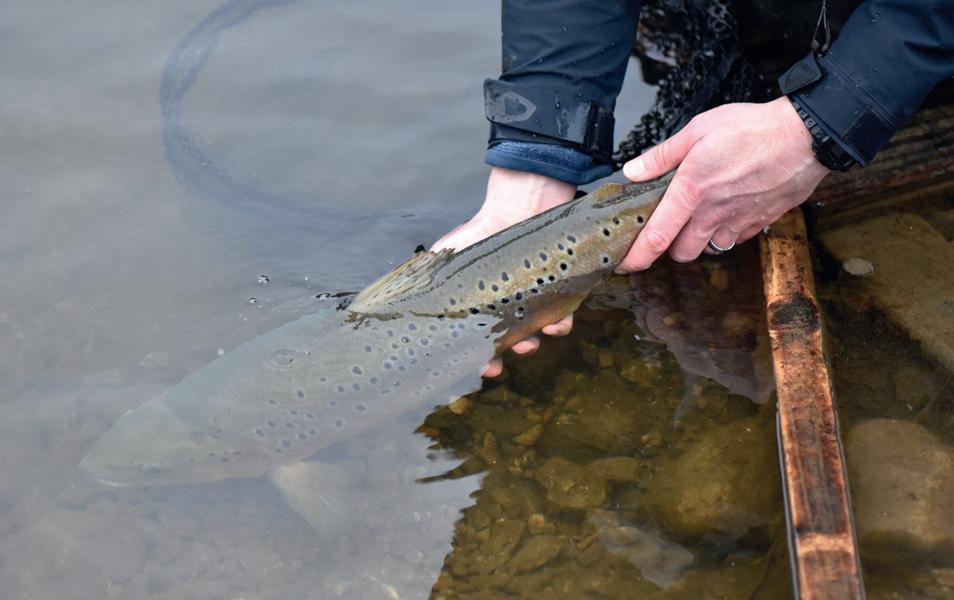

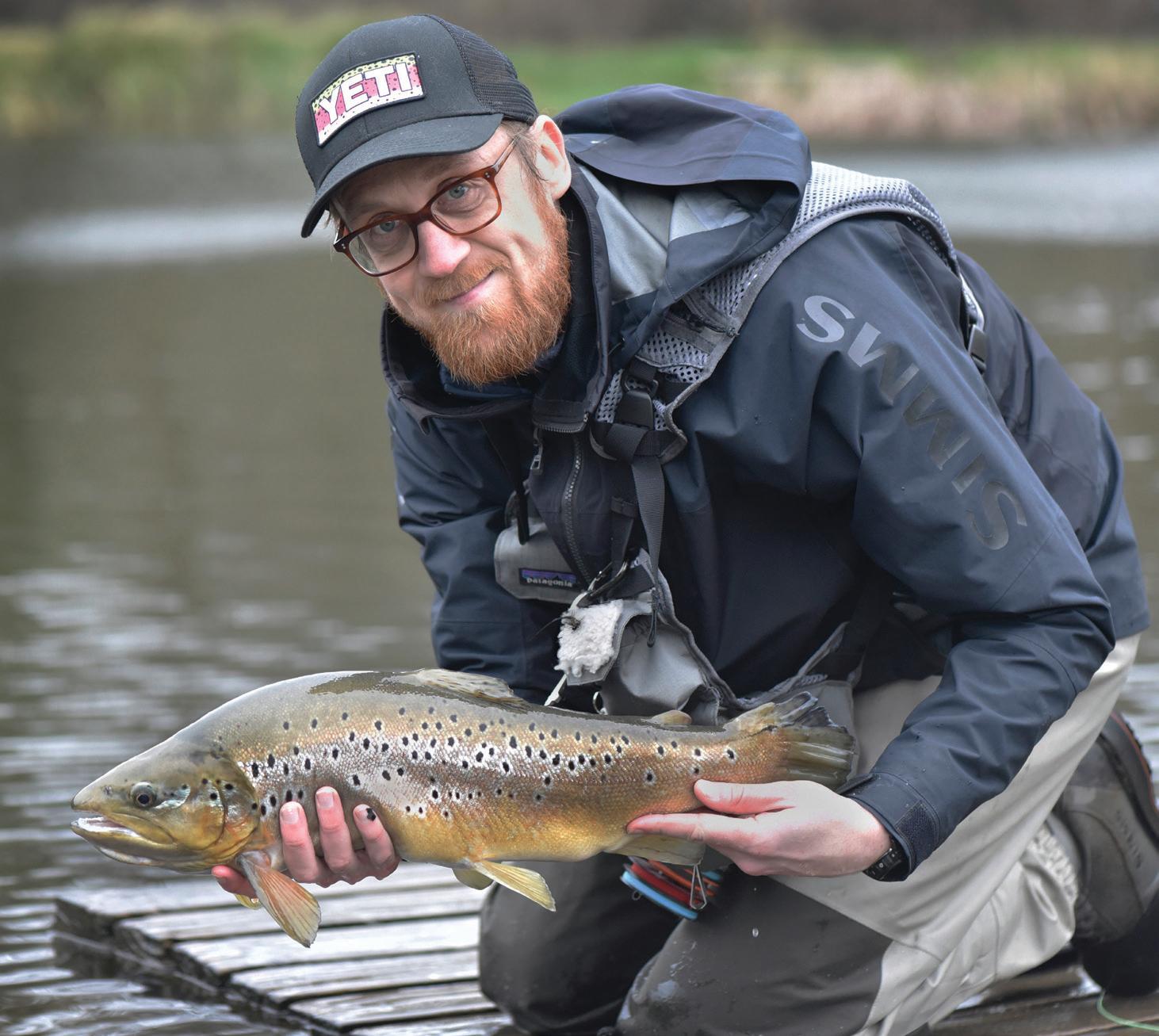
flyfishingmedia.co.uk
David did get to do some fishing too, as well as taking photos of ‘the boss’!
Cooking Your Catch: Trout Almondine
Ever tried cooking your hard-earnt catch but been disappointed? Help is at hand, thanks to a new series with self-proclaimed fish whisperer and master chef Andrej Urosevic.

Iwas so excited to be given the honour of contributing a recipe to the Flyfishing Journal, that I immediately rushed to my favourite trout lake, the Sportfish Lake in Theale, Berkshire. But alas, the weather gods did not share my enthusiasm and after countless humiliating casts and liberal use of foul language, I ended up sourcing my rainbow trout the more conventional way, at a local
fishmonger.
Luckily, hunger is a stronger motivator than disappointment, hence nothing stood in the way of preparing what is one of my preferred recipes for trout: Thomas Keller’s Trout Almondine. Easy to cook at home and a tried and tested tactical manoeuvre to appease your significant other into granting their consent to spending a weekend on a fishing trip (we’ve all been there). So, without any further ado, here’s the recipe:
Flyfishing Journal 66 FLY SCENE
WORDS AND PHOTOS: Andrej Urosevic

Ingredients*
1 x 400-500g whole trout 30g of flaked almonds 100g of green beans
Butter (as with love, the more the better)
Flour for dusting
Splash of lemon juice
Neutral oil for frying
Salt
* for 1 person, to be multiplied by the number of hungry mouths to be fed
Step 1
Fillet the fish. Obviously, this recipe may be executed with single fillets, absolutely nothing wrong with that. But the theatrical presentation of this method we’re doing here should get us a step closer to our longed-for fishing trip.
Gut and scale the trout and trim off all the fins. Place the fish (if right-handed) in front of you, with its head facing away and with its belly to your right. Make your first cut from the anal cavity towards the tail, gliding the blade of your knife on top and along the spines. Stop just short of the base of the tail. Now turn around the blade, rest the tip of the knife on top of the vertebra at the tail and cut along its backbone in one motion toward the fish’s head, cracking through all the bones of its ribcage. Turn the blade around a second time and carefully cut the flesh moving the knife towards the tail, releasing the spine from the fillet. Bet careful not cut through the fish’s back, as to keep both sides connected. Flip over the fish, so that the head is now facing towards you. Repeat the same process in reverse.
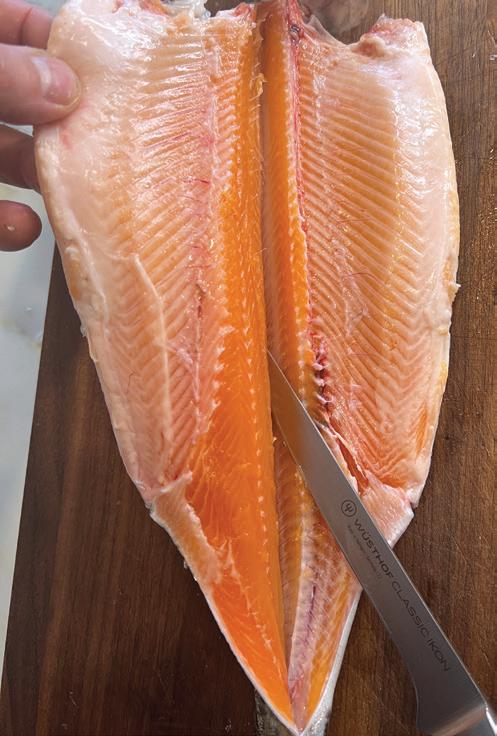
flyfishingmedia.co.uk 67
Step 2
Take a pair of kitchen shears and snap through the vertebrae connected to the base of the tail and head and remove.


Step 3
Trim the ribcage and cut away the thin part of the belly.



Step 5
Step 4
Finally, remove the pin bones using a pair of tweezers.
The result should look somewhat like this. Good news, there’re two alternatives to doing this yourself: Either ask your friendly fishmonger to gut, scale and butterfly your fish, with the head still on (make sure to ask for a ‘reverse butterfly’ or ‘block fillet’, whereby the fish is cut on its belly side and held together at the back). Or, and I cannot recommend this enough, visit and follow my Instagram page @AndrejCooksFish for tutorials on fish & seafood delights. Of course, there’s always YouTube, but that’s so 2020…

Step 6
Boil the green beans for about 8 minutes, adding two knobs of butter to the salted water. Strain and keep warm.
Step 7
Dust the fish with flour (skin side only!) and pat gently to remove any excess and lumps.
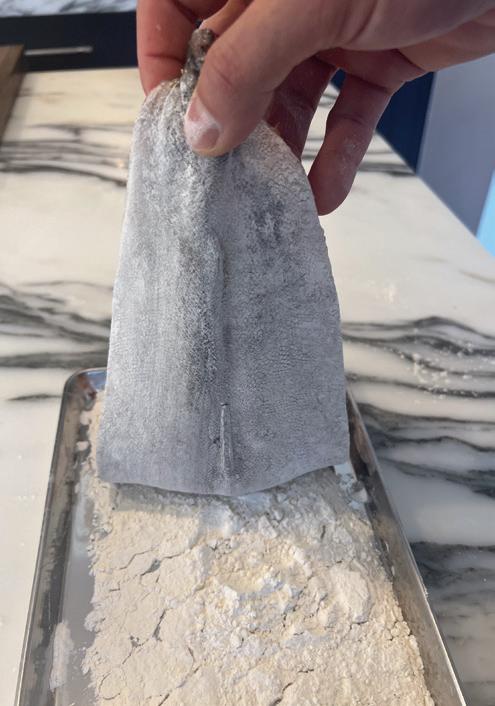
Flyfishing Journal 68 FLY SCENE
Step 8
Pre-heat a large frying pan, or plancha on medium-high heat (for reference, I have an induction hob ranging from 1-12 and I cooked this on 8 throughout) and carefully place the fish skin-side down. Press down with a fish/patty weight, or a small saucepan for a couple of minutes. This ensures even cooking of the underside.

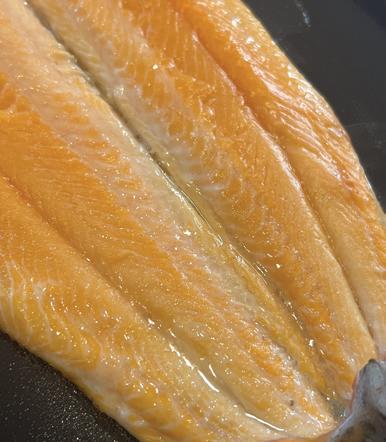
Step 10
Step 9
Continue frying for 5-7 minutes, or until the meat has become slightly pale, but not fully cooked. The heat of the butter sauce is going to finish the cooking of the meat. Remove the fish from the pan and place on a serving plate. Dress with the green beans.
Roast the flaked almonds for one minute over medium-high heat and add a generous amount of butter (by generous, I mean obscene). Keep moving the pan around and wait for the butter to foam. Add a splash of lemon juice. Keep on the heat until the butter turns golden brown, or “noisette”.

Step 11
Joyfully spoon the frothy almond butter over the trout, serve and check the weather forecast for that chalk stream you’re going to go to.
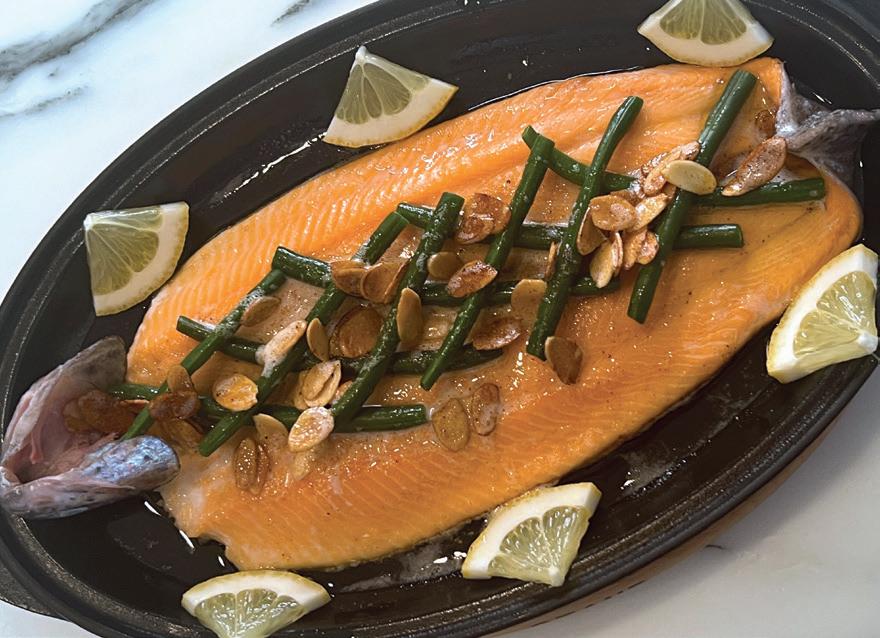
ABOUT ANDREJ
I am a full-time content creator on Instagram and TikTok with a mission to cook every fish in the world. That’s it. This is my life. My mission is fishin’!
But who is this Andrej person? I’m a former tormented corporate slave with an insane passion for fishing and eating all things maritime. Once I realised, that most of my pay (or suffering money as it is called nowadays) was going towards my pescatarian diet, I decided to move to Paris and become a Le Cordon Bleu trained chef. After successfully completing my Grande Diplôme (without suffering), my path led me to work at several Michelin-starred fish and seafood restaurants in Paris and in my hometown of Düsseldorf.
The next logical step was to open a place of my own: Andrej’s Oyster Bar & Restaurant in Düsseldorf was born. Five magnificent years and an indecent number of grilled and flambéed sea creatures later, I took the opportunity to fulfil a life-long dream of mine and move to London. Shortly after settling into my new environment, I was awarded the Master Fishmonger Standard Advanced Tier, whilst honing my filleting skills working at a local fishmonger. The icing on the cake to my piscine passions came in late 2023: following months of exhausting book cramming (I’m really not the academic type), I may now officially call myself the UK’s first and, for now, only ‘Fishsommelier’. Perhaps the time has also come for me to finally get an aquarium...
@AndrejCooksFish D www.andrejcooksfish.co.uk
69 flyfishingmedia.co.uk

Queens of the Desert
Chris Hague has chased exotic saltwater species all around the globe, but a place that always draws him back is perhaps better known for its desert environment and luxury hotels.
WORDS AND PHOTOS: Chris Hague



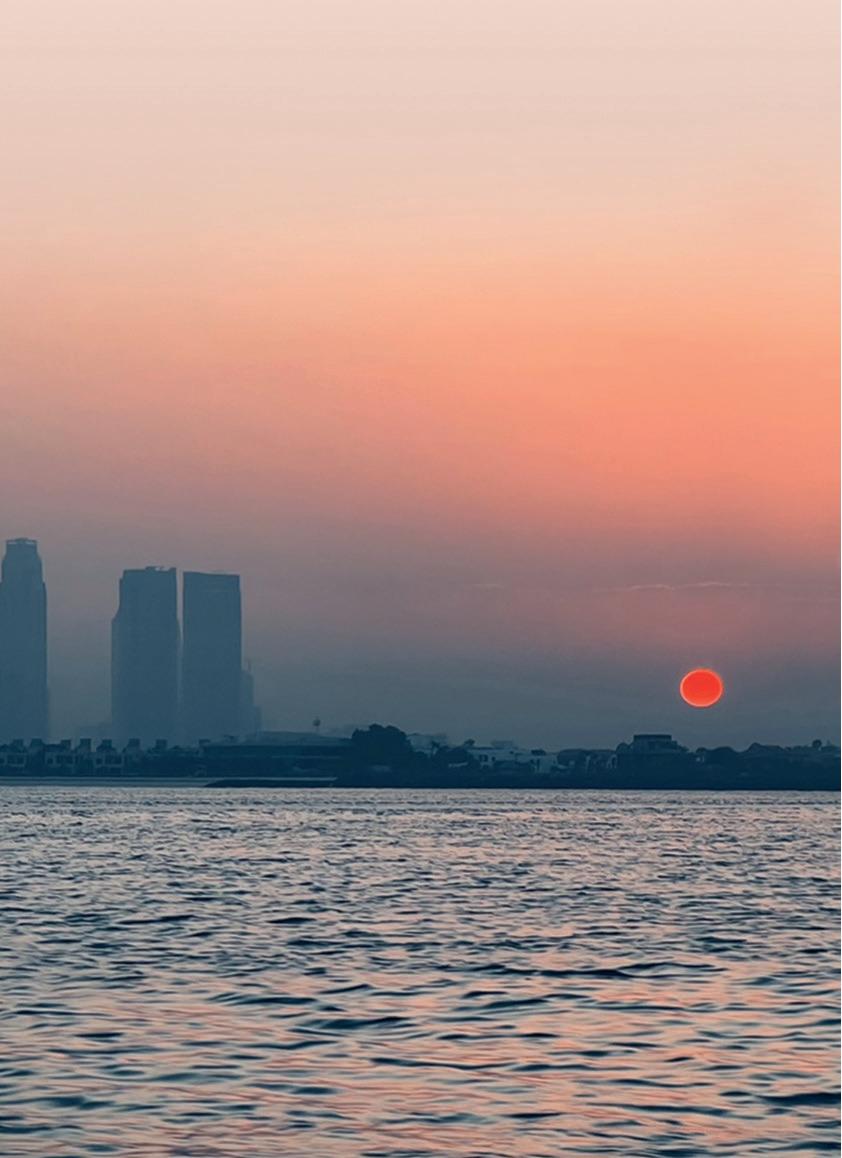

Flyfishing Journal 70
DESTINATION – DUBAI

Ihave been fortunate enough to fish all around the world for various saltwater species such as tarpon, GT, bonefish, sailfish, permit, tuna – the list goes on. Yet, one fish that often gets overlooked among these exotic species is the queenfish. While they may not be the hardest to hook, their takes are explosive and incredibly visual, providing a unique angling experience.
I’ve had the opportunity to fish for these brutes on several occasions in Dubai with Ocean Active, a highly recommended and professional outfit. The key when chasing ‘queens’ is to be up early. You’re typically riding the waves on the bow of the skiff as the sun comes up, searching for feeding seabirds. They are a significant indicator that queenfish are pushing baitfish to the surface, providing the birds with an opportunity to feed. Once these birds are spotted, your guide will make a mad rush to get you into a prime position to allow you to make a cast into what can only be described as a ball of frenzied feeding by
these fish. It’s very visual and exciting as these fish come bursting through the water chasing anything in their path.
CRACKING THE CODE
Fly selection, as well as the type and speed of retrieve, can make all the difference when it comes to achieving successful hook-ups. The last time I fished there, a technique I’ve used worldwide hand over hand/rolly pollying the line to keep the fly constantly moving – just would not work, despite major success with this method in the past. This time out it took a while to figure out just what they wanted, but after discussing with our guide Ramesh, we settled on long, fast strips with a smaller clouser fly. This seemed to do the trick, and the code was cracked.
Your heart races in anticipation of the line straightening as you strip line in at a frantic pace, and when you feel the weight of the fish, you know you’re in for a battle. During these tussles, the fish will take you down like a tuna does, and then, before
flyfishingmedia.co.uk 71
Chris casts towards a stunning Dubai dawn.

you know it, they are showing you their acrobatic prowess, throwing themselves around in the air like a gymnast.
Once these violent feeding sessions subside, you go back to searching the ocean for more signs of feeding birds or silver flashes running through the water as you spot these fish chasing their prey. What I really love about chasing queens is how visual it is. Most of the action takes place on the surface, and your heart races with excitement as you spot these fish smashing through the surface in pursuit of your fly, often pulling away at the last moment. However, when they do take the fly, it is a fantastic experience.
TRICKS OF THE TRADE
As the day progresses and it warms up, the queens tend to go deeper. This is why an

early start is imperative. If you book with Ocean Active, the bulk of their fishing is done in the mornings, although they do offer afternoon sessions which can occasionally be productive. My advice would be to definitely go out as early as possible.
In terms of equipment, a good 9-wt or 10-wt rod is required. In 2023, I used some Mackenzie prototype rods in 9-wt, which performed very well and will be potentially coming to the market soon. A floating line is fine, but I would also carry a sinking line as a ‘plan B’. A reel with a quality drag is an absolute must. Clouser flies are always a good call, and good-quality tippet is also required. If you choose to use Ocean Active’s equipment, they carry first-class kit onboard.
When it comes to clothing, I recommend
Clousers are usually Chris' first choice patterns.
"THIS SALTWATER FISHING IS PROBABLY LIKE NOTHING ELSE YOU’VE EVER EXPERIENCED."

Flyfishing Journal 72
DESTINATION – DUBAI
The sun setting behind an impressive Dubai skyline.
(Left) Rod bending action for Chris as he plays another Queenfish.

the essentials: a UPF 50+ hoodie or top, UPF50+ shorts, a peaked hat, sunglasses, and a stripping glove or fingers, along with Factor 50 sun cream. It’s important to note that when applying sun cream, thoroughly wash your hands before touching your fly line to prevent any adverse reactions that could damage the line profile. Carrying a tube of toothpaste for handwashing after applying cream is a wise practice, a valuable tip shared with me years ago by my friend Leslie Holmes. The toothpaste effectively removes DEET from your hands, and it’s the DEET in the cream that poses a risk of damaging your fishing lines.
STARGAZING
If you’re up for an exhilarating experience in urban saltwater fly fishing, chasing queenfish in Dubai, there are times when you can be fishing under the shadow of the Burj Al Arab seven-star hotel. Then, in the blink of an eye, you’re fishing near another iconic building. This saltwater fishing is probably like nothing else you’ve ever experienced.
Please note that fishing in Dubai varies moderately throughout the
year. The high season is from November through to March. For more information on fishing in Dubai, check out Ocean Active Fly. If you decide to make the trip, good luck. Hold on tight and enjoy. If you’re really lucky, you may even get a visit from the local dolphins, as I did on my last visit, which is always an amazing experience – one I have been fortunate enough to experience on several saltwater trips, and it’s one I will never tire of.

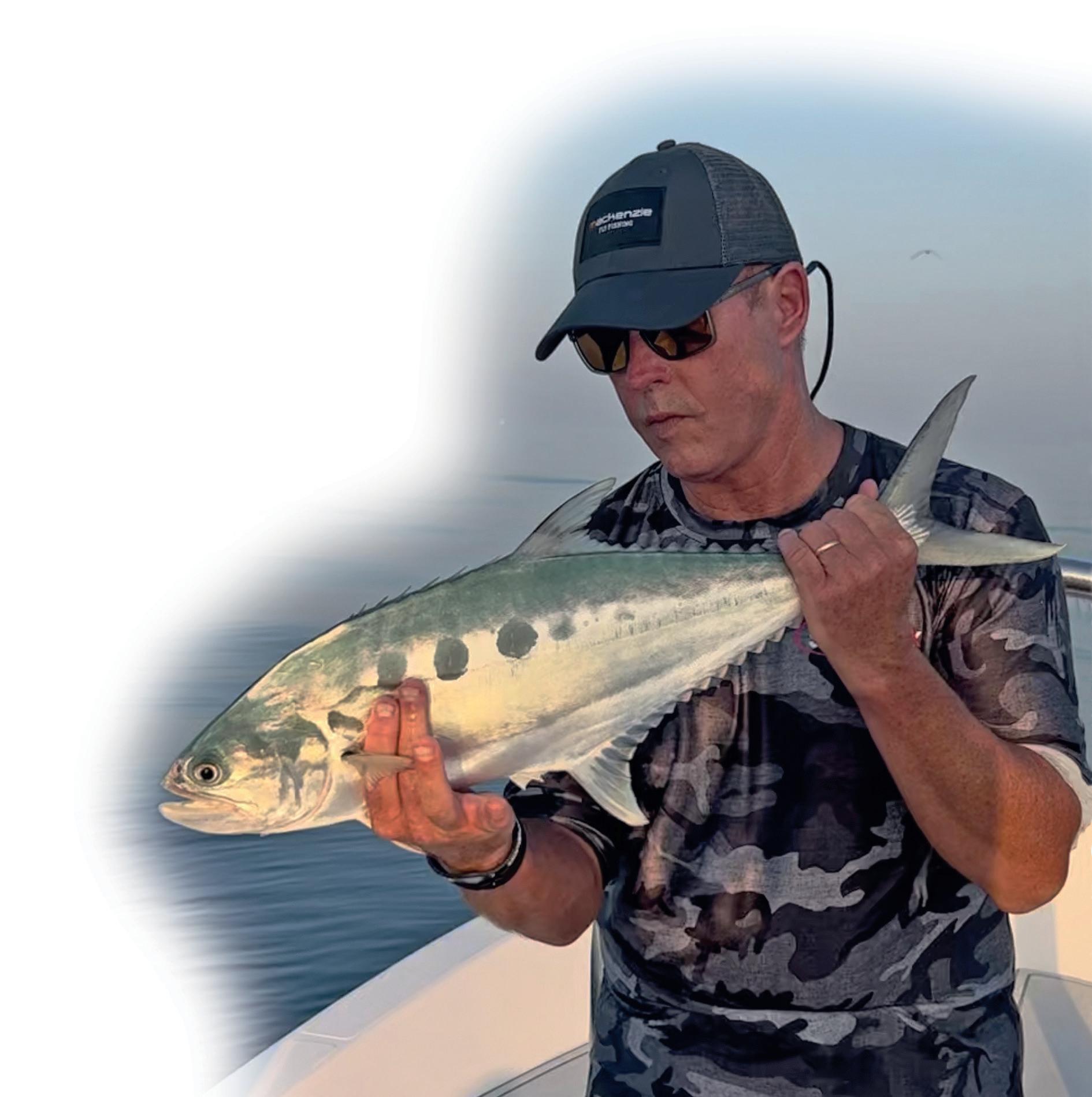
73 flyfishingmedia.co.uk

Tune into my weekly podcast and listen to my chats with leading names in the sport across UK and Ireland including the Flyfishing Journal team of experts.

HERE'S WHAT YOU GET Weekly Podcasts, Access to over 165 episodes, over 100 guests, behind the scenes photography, exclusive content and competitions. TO JOIN GO TO WWW.PATREON.COM/CASTINGWITHCERIJONES






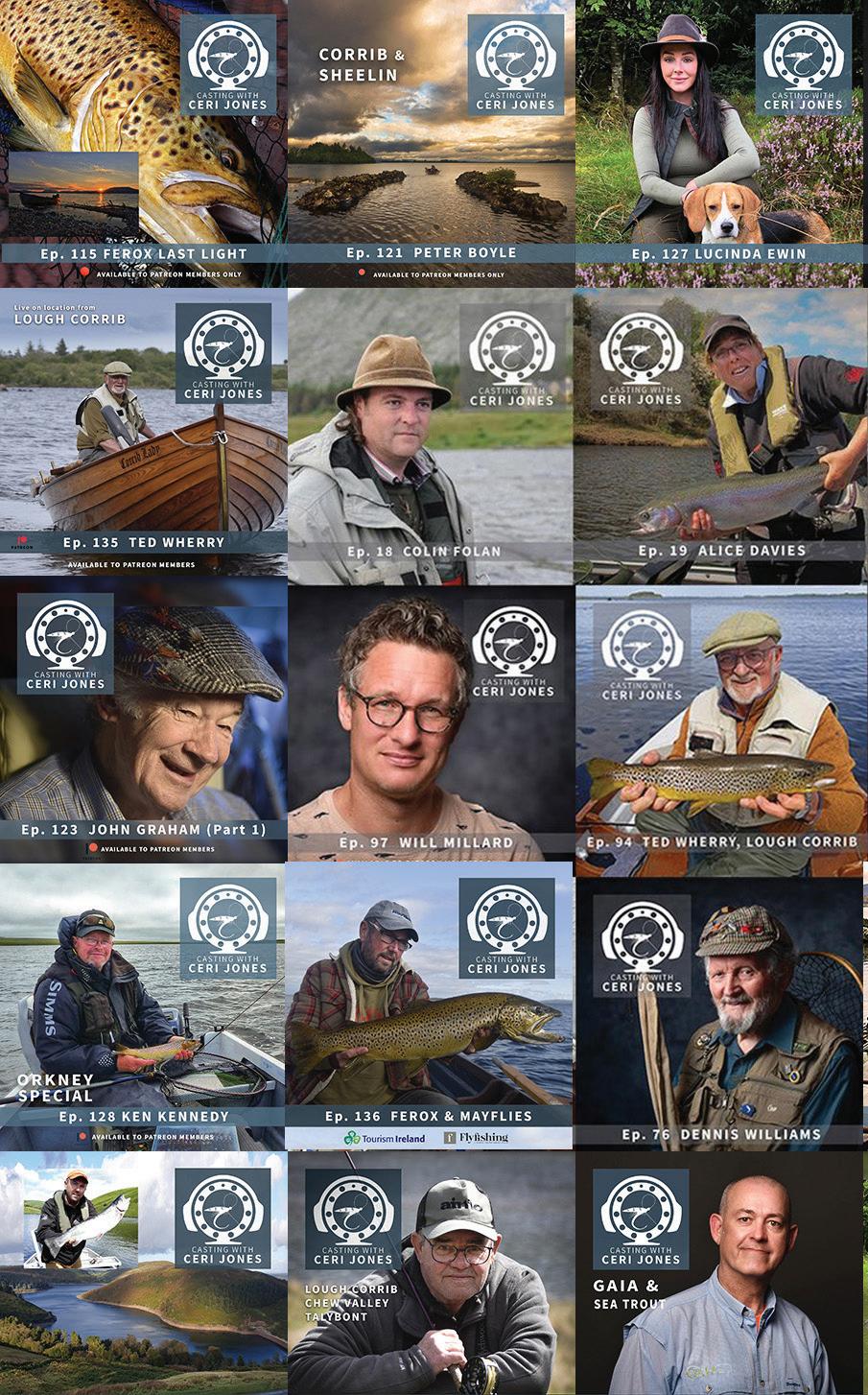
WWW.CASTINGWITHCERIJONES.COM
Anglers rally against sewage
A coalition of angling bodies have banded together to try and tackle ongoing pollution issues in one of England’s most famous chalk streams, the river Test.

Acoalition of angling organisations, comprising the Angling Trust, the Hampshire River Keepers Association (HRKA), the Test & Itchen Association (TIA), Activist Anglers, Fish Legal, and WildFish, have combined together in order to voice concerns over sewage discharges threatening the river Test.
e coalition organised a well-attended demonstration in early spring and addressed members of the coalition addressed residents, anglers, and river keepers at a public protest outside Southern Water’s Fullerton wastewater treatment works. Speakers included the actor and Angling Trust Ambassador Jim Murray, James Buckley of HRKA and Martin Salter of the Angling Trust.
e coalition says sewage in the river has been witnessed and recorded over the past several years and that this is evidently harming the river’s ecology.
Martin Salter said: “Southern Water claims no sewage leaks are going on but the good work of the riverkeepers has shown this to be untrue. is scandal has been going on for years and the lack of investment in the sewage network means it is getting worse. Southern Water must urgently step up its operations and stop the ow of untreated sewage immediately.
“ is demo is one of a series of public protests we are expecting from anglers around the country as we lead up to the General Election. Anglers are making their voices on pollution heard, and water companies and politicians would do well to listen.”
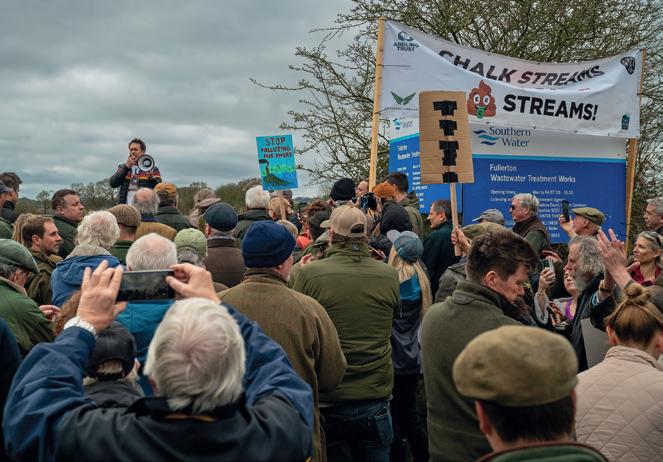
e coalition has called for immediate actions to rectify this dire situation, including:
Immediate Upgrades to Fullerton Wastewater Works: It is unacceptable that Southern Water has excluded Fullerton from its upcoming ve-year business plan for infrastructure upgrades. is neglect must be recti ed immediately.
Ofwat Intervention: e government’s water regulator, Ofwat, must reject Southern Water’s current business plan until it includes comprehensive upgrades at Fullerton.
Ban on Tanker Discharges: e practice of discharging surplus sewage from treatment works back into the river is unacceptable and must cease.
In addition to public response, the Angling Trust is pressing DEFRA and the Environment Agency for clari cation on Southern Water’s operations and claims of zero pollution, and demanding the water regulators take a more robust approach.
SUPPORT OUR WORK AND JOIN TODAY
To stay up to date with further developments in the Angling Trust’s Anglers Against Pollution Campaign, or to donate or join the organisation, head over to

www.anglingtrust.net or call 0343 507 7006
flyfishingmedia.co.uk 75
CONSERVATION

Mayfly Memories
While early season sport is fun, the real enjoyment on Ireland’s stillwaters comes later in the spring around the time of the Mayfly hatches, so says resident expert Rob Connor.
Flyfishing Journal 76
STILLWATERS
WORDS & PHOTOS: Rob Connor

An adult Mayfly finds safety and rests on the bow of Rob's boat.
If like me, you find winter a little on the dreary side, you can always find reasons to be cheerful, the days are ever so slowly starting to lengthen and the great western lakes of Corrib, Mask, and Conn will be opening very soon for those early season anglers keen and mad enough to brave the elements and chase hungry trout that in theory should be ravenous after a winter of slim pickings.
As much as I like wetting a line early season, I find my mind drifting towards the thoughts of spring, warmer, kinder days, and the prospect of fly hatches and potentially topwater sport. Other matters also occupy my thoughts, new goals to be set, trips to the west to be planned, gear to be dusted down and made ready, two fishing stag dos to be coordinated as no less than two of my good fishing buddies are getting married this coming summer and various competition dates to be chalked down in the diary (thankfully I have a patient and understanding wife). But nothing captures my mind or captivates my plans like the thoughts of the approaching Mayfly season. Based in the midlands of Ireland, most of my fishing takes place on the rivers of County Offaly and the lakes of County Westmeath. The river Brosna, Loughs Ennell, Ree, Sheelin, and Owel are my local go-to waters. Excursions west to Loughs Conn and Cullin and then the Corrib for the July or second Mayfly hatch are also dates that deserve
careful planning, so as to time my trip to coincide with the best of the hatches and so hopefully the fishing too, and local information in the form of weather and fishing reports from some of my Westernbased buddies coming in handy.
The wild fishing here varies greatly from what many might be used to on the fabled western lakes such as Corrib, Mask, or Conn, the fish tend to be larger on average, less frequent, certainly more dour, and very much more hatch-driven in their taking habits, only in certain conditions can they be described as anything close to free rising or catchable in the upper layers and even then it can be fleeting as the largesse of massive hatches can leave fish picky and lazy in their eating habits. Many of my better fish or notable days have come during the Mayfly and none more so than on the most famous Mayfly lough of them all, Sheelin. Cork man and good friend Darren Duffy loves to tell how one of my biggest ever trout and at the time a personal best was an accident and truthfully there was a huge dollop of luck attached as I fiddled around with the electric engine to keep the two of us on a drift during an evening’s spent fishing. When a large slurp focused my thoughts and when searching in front of the boat, I couldn’t spot my imitation I instinctively struck into what turned out to be a fish of over 8.5lb. That particular evening, I was lucky enough to have three cracking fish – 3.5lb, 5lb, and 8.5lb, a testament to the incredible fish Sheelin can and sometimes does throw up.
flyfishingmedia.co.uk 77
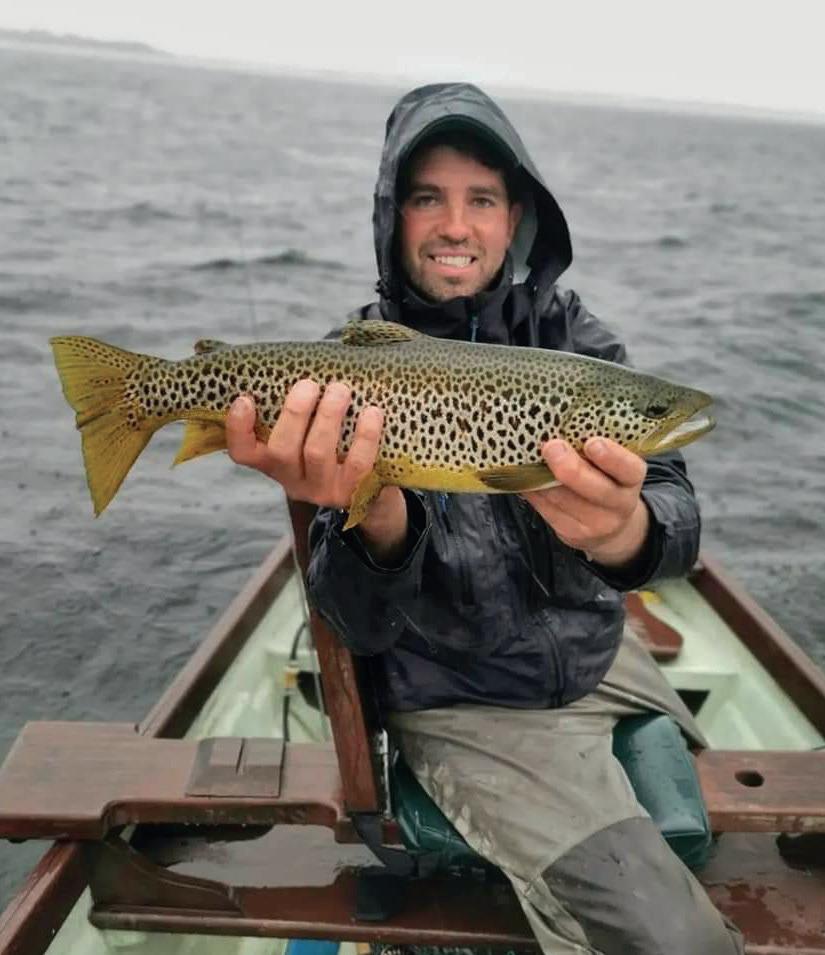
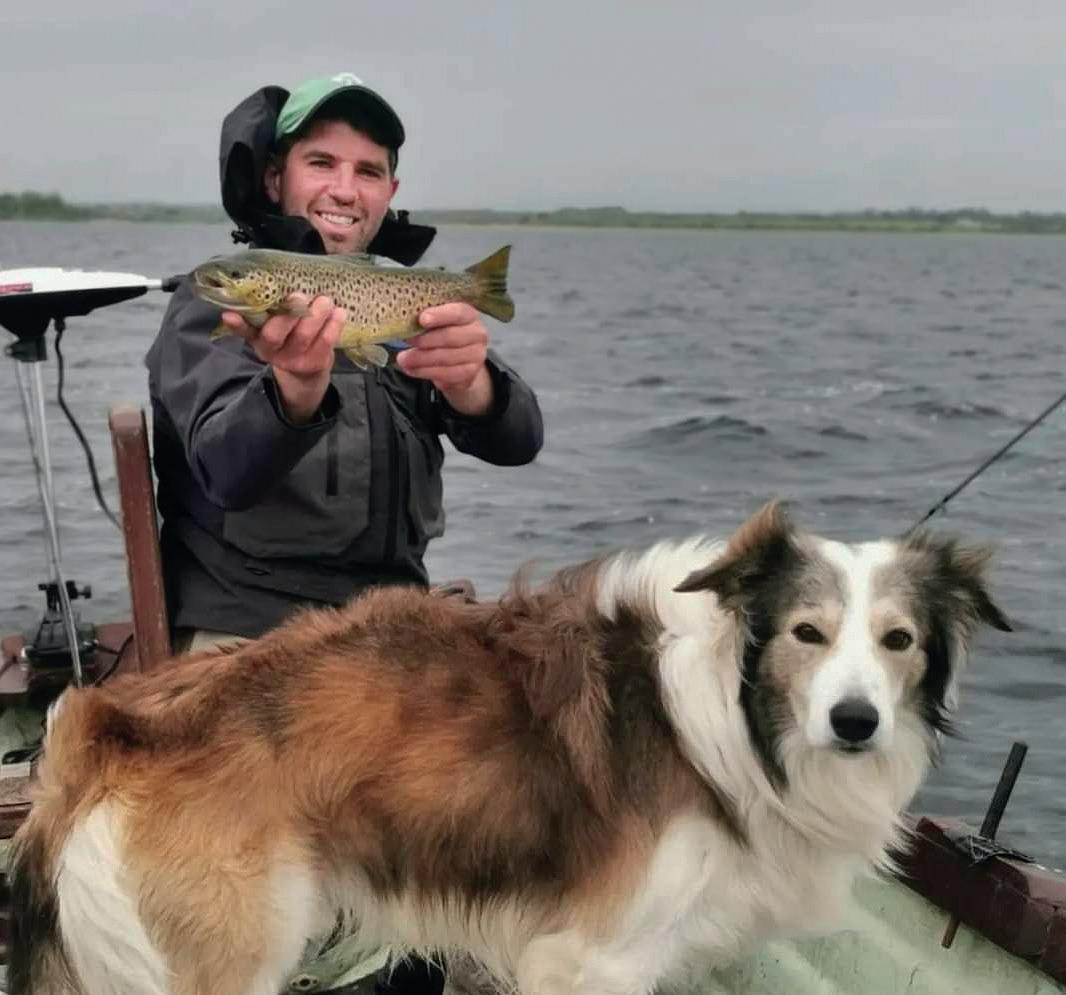
"2022 THREW ME UP SOME TREMENDOUS FISH, NONE MORE SO THAN A CRACKING FISH OF ALMOST 6LB THAT I HOOKED ON THE SURFACE ON A FRENCH PARTRIDGE ONLY A FEW YARDS FROM THE BOAT…"
LOCATION, LOCATION, LOCATION
Of all the waters I’ve been lucky enough to fish, I would probably have to label Lough Ennell as my favourite lough to fish when it’s on form, another wonderful Limestone lough, in a stately setting, surrounded as it is by mature trees, rich farmland, and many famous old estate houses, it still boasts the Irish record rod caught trout of 26 lbs, although it must be said it can be incredibly dour by times and again fishing is largely hatch driven. Fishery surveys confirm an excellent stock of fish, although the average size is not as big as what you might expect from Ree or Sheelin, but the Ennell fish are certainly the harder fighting of any the local waters. Although last year’s Mayfly was patchy, 2022 threw me up some tremendous fish, none more so than a cracking fish of almost 6lb that I hooked on the surface on a French Partridge only a few yards from the boat and stripped me to the backing several
times over an incredible 15-minute battle. Lough Ree in contrast to the safer waters of Sheelin or Ennell, is a vast, wild lake, full of shallows, islands, reefs, and bays and home to some monstrous trout. Although classed as a mixed fishery, holding recordbreaking pike and numerous coarse fish, it is also a noted trout lake and the Mayfly is normally the best chance to target them. Every season fish into double figures are taken, missed, or lost, mostly on spent gnat when the conditions are right. This is a fickle type of fishing, with wind direction, temperature, humidity, and light conditions all playing their part in when and if the fly will go out and then even at what time or whether the trout might decide to feed. With so many variables, there are always periods of frustration to be worked through, but when the fishing does happen, it can be truly memorable.
Lough Conn offers something totally
Flyfishing Journal 78
(Left) A magnificent Ennell fish for Rob, look at that tail!
STILLWATERS
(Right) Rob's full time boatman, Ted.

different, fish and fly hatches might be on the smaller side, but on the whole, fish tend to be more free-rising and obliging. Blind drifts over likely looking shallows can produce lively fishing and there’s always the added bonus of the possibility of a grilse or spring salmon in off the Moy system. Incredibly in May 2022, I was fortunate enough to land a lovely fresh Grilse of about 5lb on a wet Mayfly along with numerous little trout and some better ones to 18 inches, a good day fishing by anyone’s standards. But the most memorable part of the trip was to happen later on the same evening as I lost a tide fresh Springer of maybe 8 or 10lb on a spent gnat pattern. The fish was actually coming up a slick taking spent like a large trout and it confidently head and tailed over my fly once covered, on the lift, all hell broke loose, two crazy runs to the backing and twice he pitched, before he threw the hook, heart-stopping stuff in the late evening on a 6-wt in shallow water.
An old and long-since deceased fishing buddy of mine once told me the importance of choosing my fishing companions, in fact,
he specified it was of greater importance than actually choosing a wife, as invariably you’d spend more time with them than you ever would your wife! Thankfully I’ve made great friends through my love of trout fishing and now have friends who will fish here with me, while also affording me the opportunities to fish Corrib, Derg, Mask, and Conn when the fishing is on.
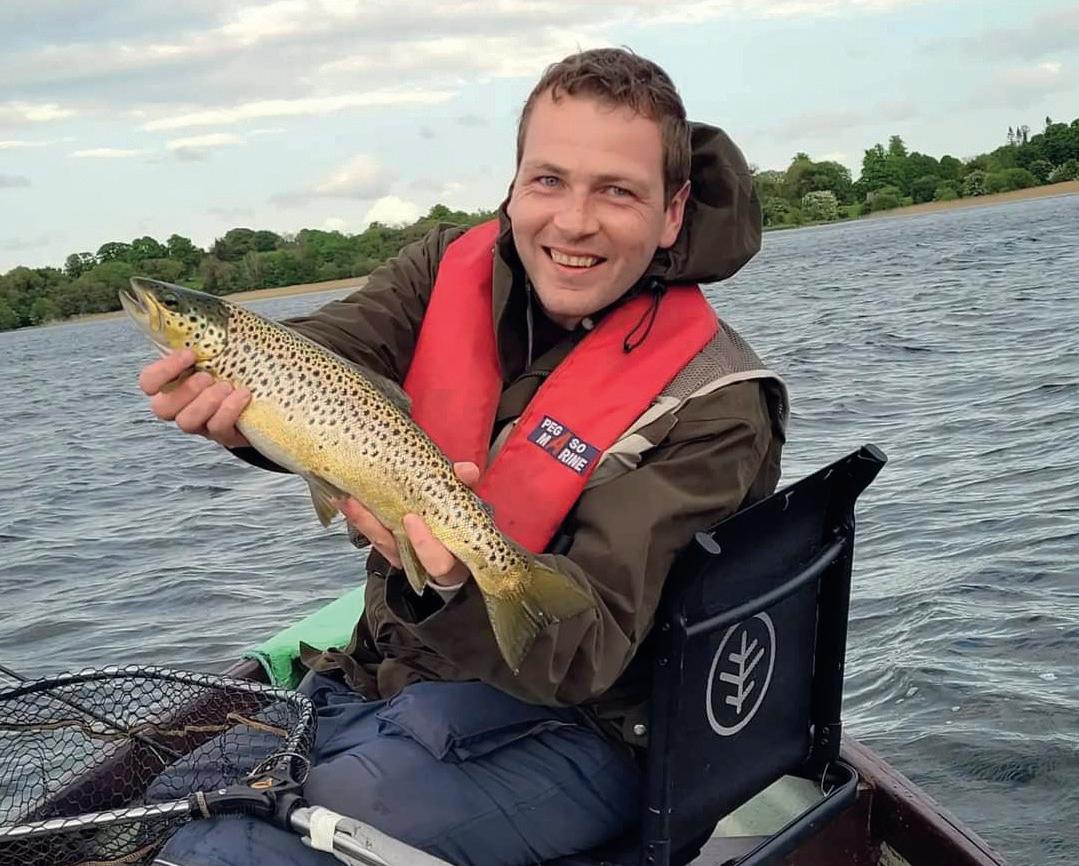
flyfishingmedia.co.uk 79
Rob’s favourite ever fish, 6lb from Lough Ree.
John Burns with a nice Ennell fish
A Jolly Good Yellow

Embark on the fishing adventure of a lifetime with fly fishing author Duncan Hall as he chases yellowfish in the heart of South Africa.
South Africa had been on my fishing radar for some time after catching tiger fish at the Ngombi lodge on the upper Zambezi. I contacted Roddy, now senior travel advisor for Frontiers Travel, who previously arranged my tiger fishing for advice on another fly fishing trip. He enlightened me on three options, nonindigenous brown trout, odd-sounding estuarine fish on the Eastern Cape, or elegant freshwater yellowfish, which have been described by the South African Fish the Fly as one of the most exciting forms of fly fishing.
ORANGE AND YELLOW
The river Orange, named after the Dutchman, William V of Orange, and its tributaries are the main watershed for yellowfish in South Africa. In the wet season, the river is often brown, but runs clear in the dry, between October to
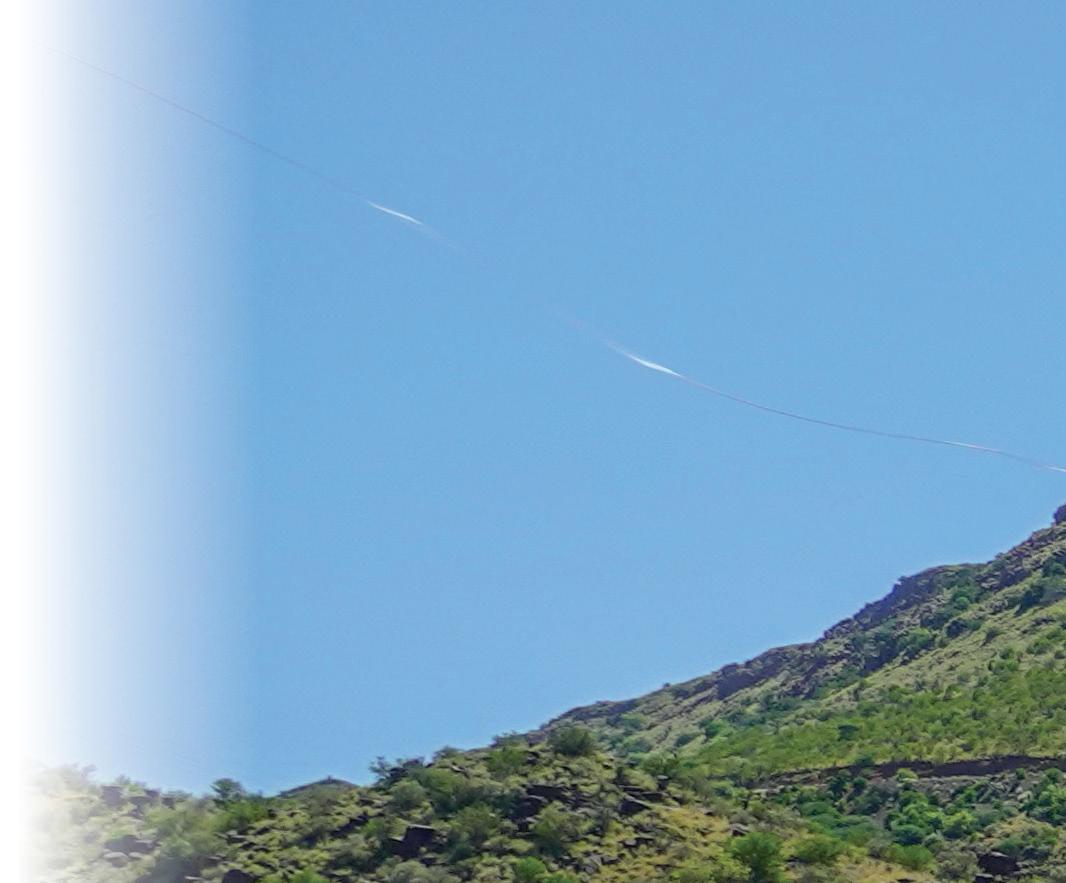


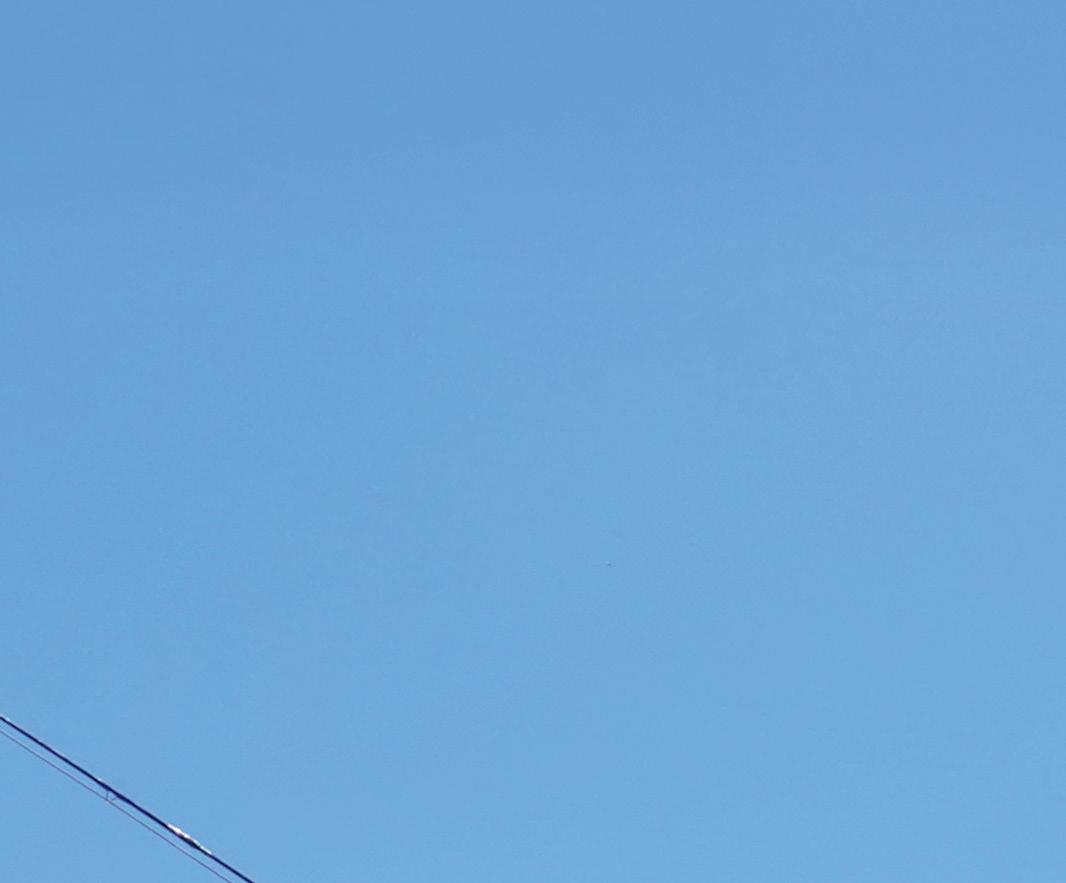



Flyfishing Journal 80
WORDS & PHOTOS: Duncan Hall
– SOUTH AFRICA
DESTINATION
Duncan switches to a left hand cast on the River Orange below the impressive dam.





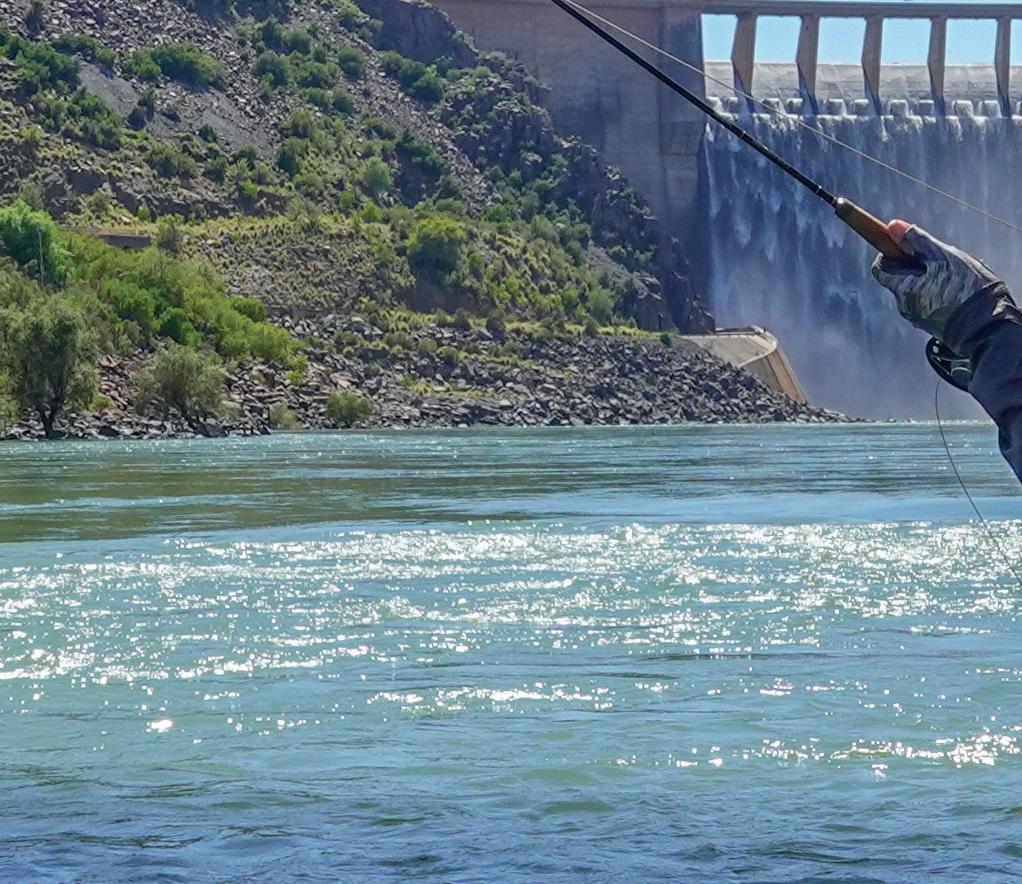

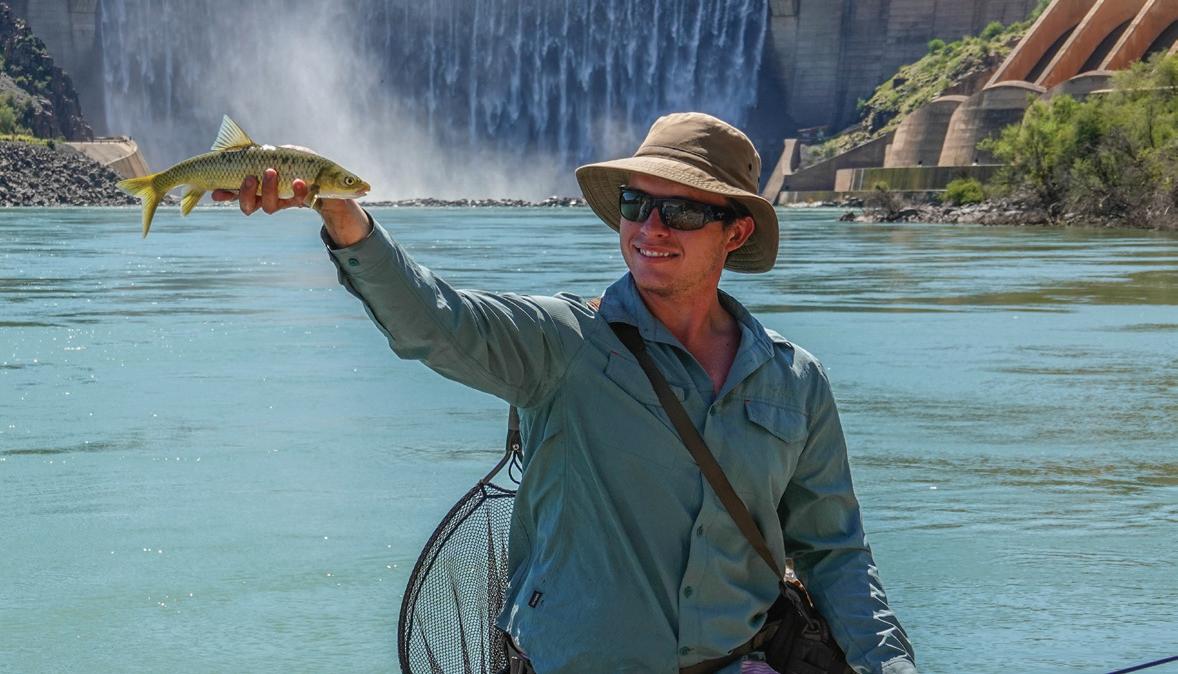


February. At 1,511 miles, it’s the longest in the country, from its easterly source in the Drakensberg mountains to its mouth in the Atlantic, forming the border between Namibia to the north and South Africa to the south. The river plays an important role in the economies of both Lesotho and South Africa providing fresh water for drinking, crop irrigation, and hydroelectric power with its two dams.
I had studied the fishing opportunities of the river, and although there had been occasional stupendous largemouth fly fishing on the Namibian section when the water was clear, there were times when it was coloured and un-fishable. The Vaal, one of the main tributaries had pollution issues and thus Roddy recommended Chris Van der Post’s Gkhui Gkhui River Lodge near Kimberly, free of pollution and with a healthy population of yellowfish.
I was collected at Kimberly airport, an easy stopover from my final flight to Cape Town by Vian, whom I had first met when he guided me on a tiger fishing trip on the upper Zambezi a few years earlier. The lodge was located on the banks of the Orange and provided excellent food and accommodation, and I was pleased to discover a striped mongoose, on ‘24-hour duty’ outside my cabin, which I hoped
flyfishingmedia.co.uk 81
DESTINATION – SOUTH AFRICA
would gobble up any Cape cobra or puff adders. Fortunately, I never encountered any snakes, although chatting to Vian, he recounted an occasion where he had to evict an extremely angry and dangerous black mamba from another fishing lodge, with just a stick. The duties of a fishing guide, I guess!
SIZE MATTERS
There are six yellowfish species in the genus Labeobarbus, and in the Kimberly section of the Orange are found the smallmouth Labeobarbus aeneus and the largemouth Labeobarbus kimberleyensis. Smallmouths or ‘smallies’ are usually found in groups, close to protective rocks, or in riffles at river margins, feeding on small insects and subaquatic food.
They are usually around 2-4lb but can grow to well over 10lb.
The largemouth or ‘largies’ as the name suggests, are the biggest yellowfish, and the most prized and difficult to catch. They are an apex predator, feeding on small fish like minnows and larger aquatic insects. They inhabit deeper pools, rock ledges,

season is from October to early January, but is rain-dependent, as water levels change with alacrity in the unpredictable African weather. My trip in the last week of January, unfortunately coincided with torrential rain the previous week, and the Gariep Dam above the lodge, which usually maintained a low water, was doing a fine impression of Victoria Falls! The river had risen over five feet, and the usually clear water now had an opaque tinge.
Chris, the lodge owner, and his two guides, Vian and Anthea, pulled out all the stops to find me fish, and their hard work paid dividends. I spent the first two days searching for yellows on the clearer waters of the reservoir, the following day fishing below the dam, and finally drifting the river, the usual method of fishing.
Vian guides
Anthea as they search for the yellowfish.


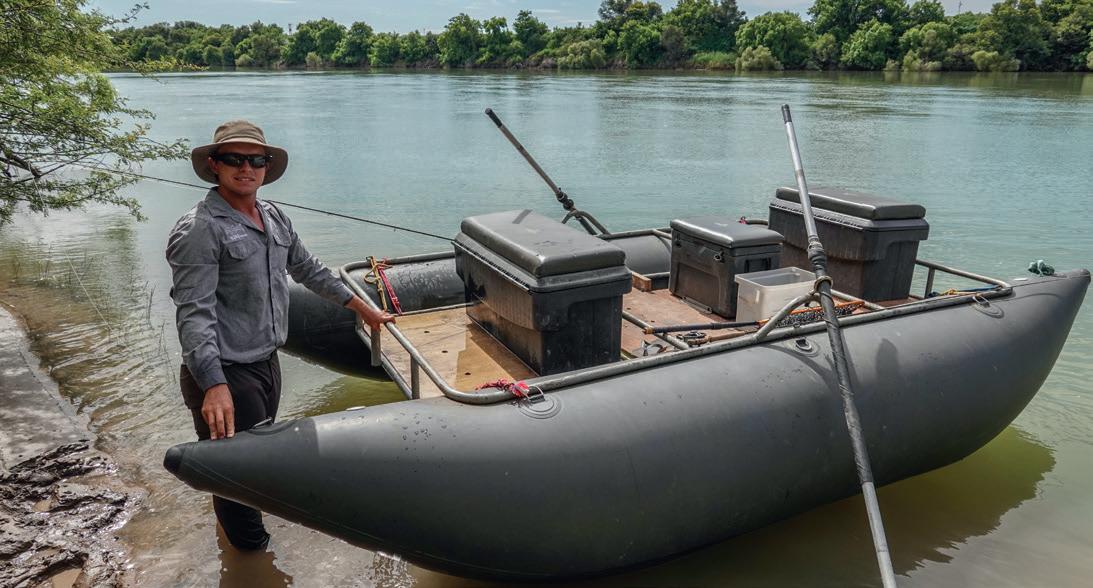 Duncan’s second yellowfish of the trip.
Duncan’s second yellowfish of the trip.
82
Guide Vian prepares the raft.

I caught all my smallies sight-fishing, with Chris helming the boat, and Vian helping me spot the fish. Both species were remarkably selective, with many aborted takes and swirls under the fly, but despite poor conditions and few fish, I finished the day with five, but no largies. The following day I was joined by Anthea, a fine fly fisher and fly tyer. After catching a few smallies, we moved to a section of the reservoir, to fish along the base of a sheer cliff, which although unproductive, was fascinating to witness birds of prey, monitor lizards, and occasional engraved ancient rock art carved on the cliff.
The following day I fished below the dam, catching smallies on the foam beetle, and then changing my fly to a CDC caddies imitation. On my first cast, my fly was engulfed in an uncharacteristic aggressive take, as a largie engulfed my fly and smashed my 8lb leader. Gutted, I re-tackled with a 12lb leader and the same fly pattern, and again, first cast, my fly was taken with an explosive take. After some minutes I landed my first largie, which on the dry fly is

virtually unheard of, and indeed as yet, Vian had not experienced.
A THOUSAND CASTS
On my last day, it was time to raft the river. Normally this was a slow drift punctuated by wading, but with the height of the river, the fishing was localised to the margins, casting streamers under the numerous willow trees and avoiding the numerous weaver birds’ nests dangling down. Vian and Anthea regularly repeated the saying that a largie, was the fish of a thousand casts, and I had started to feel somewhat short-changed as I was numerically well past that figure, when I had a take, and to my delight landed a reasonable-sized largemouth. With the fish released unharmed, the skies darkened and the seemingly daily thunderstorms rolled menacingly towards us. Vian described as we headed for the car, how on one occasion, his graphite rod had buzzed with a sound similar to an overhead electrical cable, and Anthea had even received a static electric shock when she touched her rod. Time to go!
Learn more about him at:
D
83 flyfishingmedia.co.uk
Duncan with an stunning Largemouth taken on a streamer.
www.bigsalmon. co.uk
Duncan Hall is the author of Fly Fishing the World on Shoestring.




Origins of… The Alexandra
This issue, Alun Rees takes a deep dive into a fly with a real lineage that may be from a bygone era but is still very relevant and successful – the Alexandra.
WORDS: Alun Rees, PHOTOS: Ceri Jones

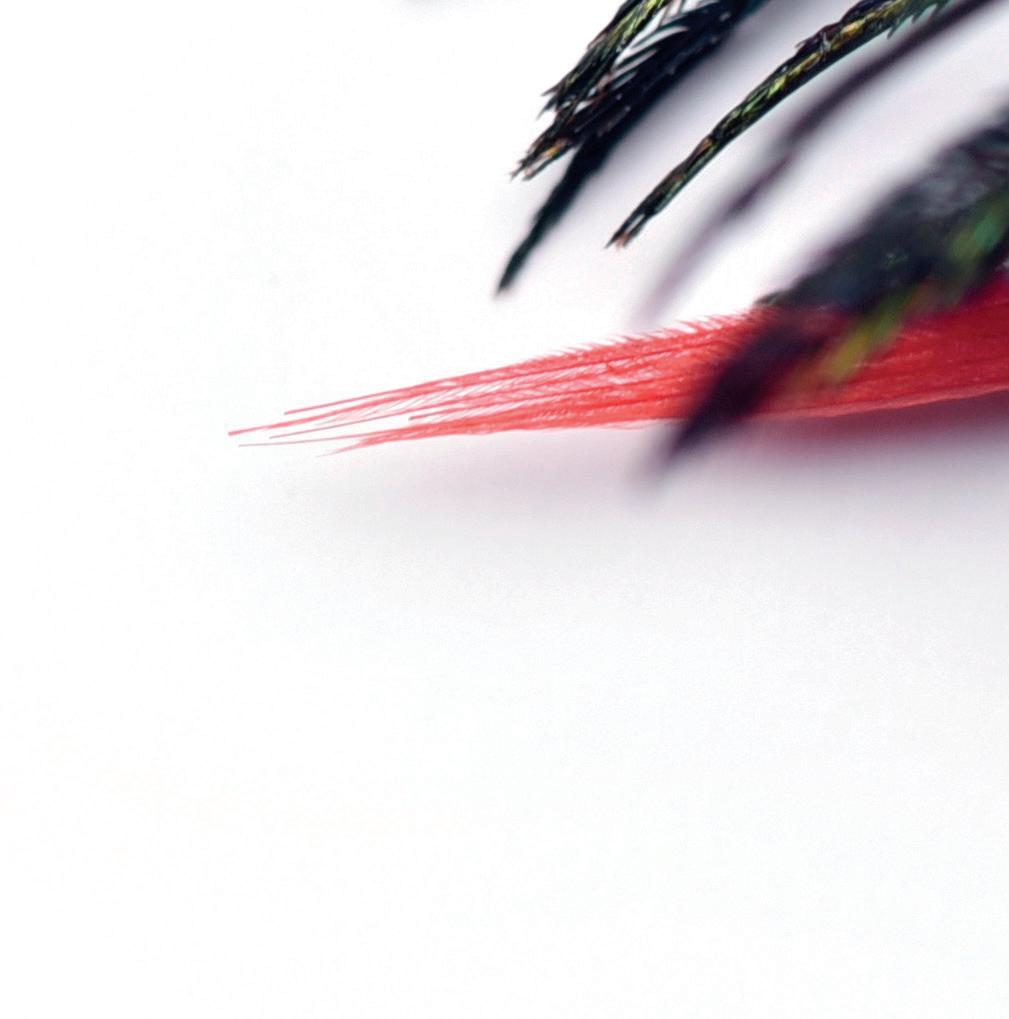
Considered a gaudy fly at the time but simple enough by today’s standards, the fly we know as the Alexandra was originally called ‘The Lady of the Lake.’ It came into prominent use around 1860, the middle period of the rule of Queen Victoria. However, it was soon renamed ‘Alexandra’ in honour of the then Princess Alexandra of Denmark who married

Edward, the Prince of Wales in 1863. In 1901, on the death of his mother, Queen Victoria, Edward became King Edward VII and Princess Alexandra, Queen Alexandra.
THE DRESSING
Scholars of fly-tying materials will be aware that during the late 1800’s, many exotic feathers became available due in part to

84
FLY TYING




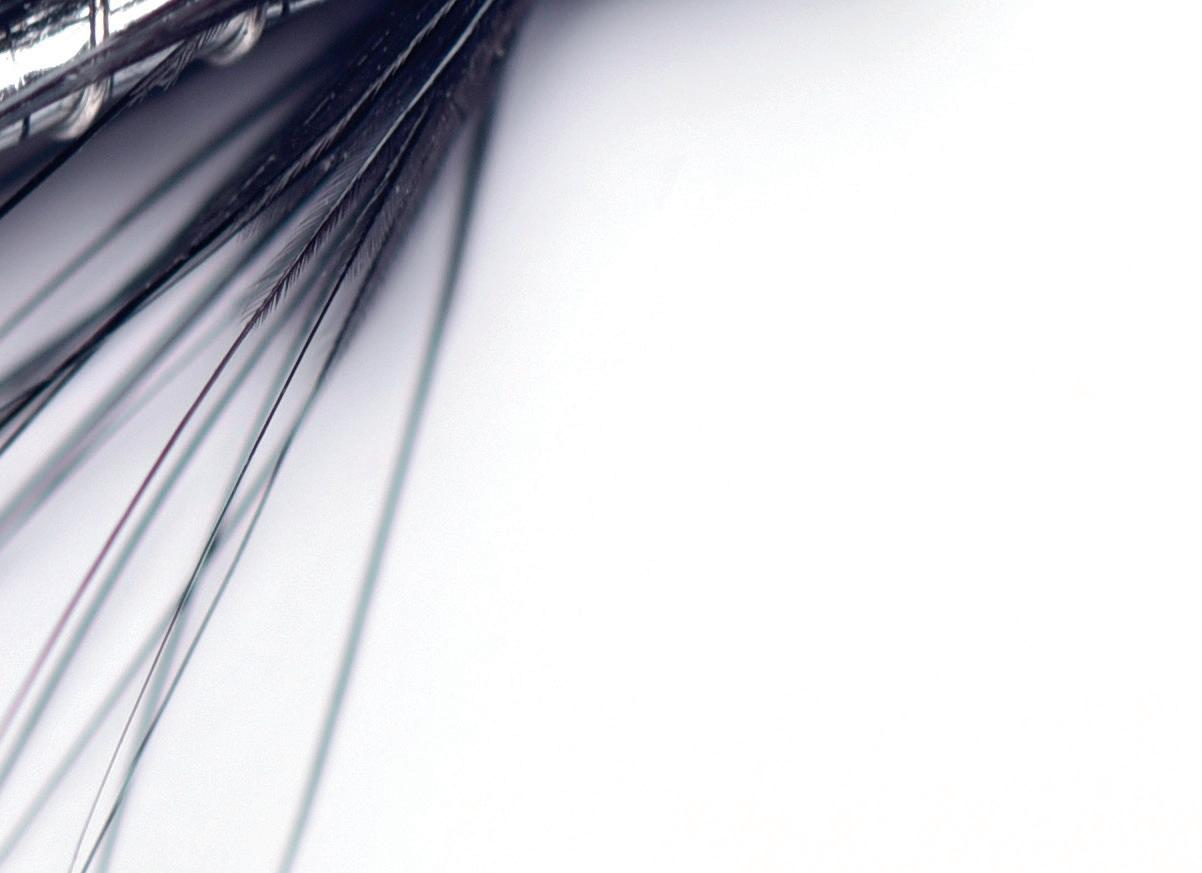
the expanse of the British Empire, which was at the height of its power. The Empire encompassed over 450 million people and approximately one quarter of the world’s landmass.
Red (Scarlet) Ibis, found in the western most regions of the Empire is used as both a tail and cheeks adding flashes of subtle red. The body is made of flat silver with reinforcing wraps of silver tinsel. A throat

hackle of black hen tones the fly down. The wing however is something to behold; herl from a peacock sword feather. Native to the Eastern part of the British Empire, peacock provide a multitude of feathers; sword feathers reside on the side of the tail and do not contain the characteristic ‘eye.’
The feathers have dense herl that are iridescent. The herl can appear bronze, green right through to a lapis blue. A

85
flyfishingmedia.co.uk
The classic Alexandra, a mouth watering combination of flash and exotic feathers. Irresistible!
Modern
Alexandra, White
Throated Alexandra and Pearl Alexandra.
display of nature’s pallet that cannot be replicated.
OBSERVATIONS
Although traditionally tied on hook sizes 10 and 12 for lake or loch use, my first introduction to the Alexandra and its effectiveness was somewhat different.
Picture if you can, the early days of stocked stillwater angling in the late 1970’s and the still, wonderous excitement and possibility of catching a large, grown-on, hard-fighting rainbow trout. It was nearing the end of the trout season and fish were smashing into fry in the margins to obtain the protein they needed to pack on weight to see them through the winter.
As a near teen, it was early in my angling career, and I’d never seen such a sight. Excitement was high, anticipation even greater. However, every splash I cast to resulted in nothing. Yet, not 20 metres from me was an angler that was taking a fish nearly every cast. Eager to find out what the successful method was,
I approached the angler armed with eagle eyes and loads of questions. Whilst I was approaching, the angler hooked into yet another fish. I eagerly rushed over and offered to land the fish for him. This was an opportunity to see the successful fly.
The angler knew what my game was and fortunately for me, took time out to further my angling education. He explained that the fish were chasing fry and attempting to stun them before returning to pick up the casualties. His method was to cast into the vicinity with an Alexandra tied on a long shank hook. Wait, and then retrieve in slow pulls. However, when he showed me the fly it had no red ibis in it whatsoever. I’d been tying flies for a little while by then and asked him for an explanation? This wasn’t an Alexandra as I knew it!

He showed me how the wing would change colour depending on the angle you viewed the fly from. With one scoop of his landing net, he also showed me why he was using it; loads of green and pearl sticklebacks. The red ibis he said, should only be included when the sticklebacks are in their mating colours which is usually in the spring.
ENLIGHTENMENT
Since that early introduction, I have tied and fished many thousands of Alexandra flies. I’ve modified the pattern and used it to catch brown trout, rainbow trout, and many, many seatrout, in all its guises. The humble stickleback is not fussy where it lives; ditches, ponds, canals, rivers, and even the sea. It can grow up to 11cms so larger Alexandra flies can and do work in a variety of habitats.
It may be a fly from a bygone era but is still very relevant and successful. Whomsoever invented the fly may be debated but, they certainly did us a great service.
86 Flyfishing Journal
Variations for Seatrout and Fry feeders. Top to bottom, the Flashy
TYING
FLY























Connecting your ideas www.nousmedia.co.uk Saara Rootes J 07790 193360 M saara@nousmedia.co.uk Rob McGinlay J 07917 777721 M Rob@nousmedia.co.uk Flyers l Promotional Postcards Business Cards l Promotional Event Banners Branded Clothing l Shop Signage Tote Bags l Stickers l Packaging Print Solutions Hard Back Books l Wire Bound Books Notepads l Perfect Bound Books Layflat Binding l Thread Sewn l Saddle Stitched New Specialised Print Solutions Nous Media is commited to... Connecti n g your ideas Rob and Saara have over 30 years experience in the print, publishing and design industry. We offer our knowledge, guidance and expertise in getting your message across in many formats. We have costeffective solutions to meet your needs and budget. Contact us today
Meet Our Experts…

Craig Barr
An England Lochstyle International and the man behind Flash Attack Flies. Craig is also a guide on his local waters Rutland and Grafham.
D www.flashattackflies.com

Peter Boyle
Has a wealth of experience and knowledge on the Irish Loughs, mainly Sheelin, Erne and Corrib. Has a real passion for buzzer and caenis fishing.
M peterboyle5@hotmail.com

Gilly Bate
Gilly has been fishing on the Hampshire Chalk Streams for 25 years, an AAPGAI advanced single handed casting instructor and professional guide. She also arranges fly fishing days and corporate entertaining on the rivers Test and Itchen.
D www.flyodysseychalkstream.co.uk
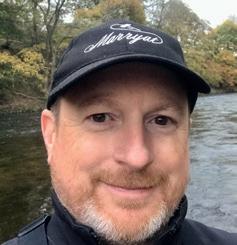
Dr Dave Bradley
Dave has been passionate about fly fishing and fly tying for 35 years and is a regular competitor on the national rivers circuit. He is a professional freshwater ecologist and director at the environmental consultancy firm APEM Ltd.
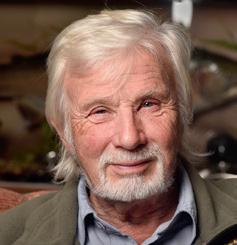

Peter Cockwill
Pete has vast experience as an angler, instructor, fishery manager, retailer and author. He’s been hosting trips for 35 years. Based at the famous Dever Springs his seventh book –The Small Stillwaters – is a best-seller.
M petercockwill@aol.com.
Darren Duffy
Darren lives on the banks of the Munster Blackwater in Co. Cork, he specialises in tying flies for the wild Irish Loughs, where he does the majority of his fishing with dry fly fishing being his main passion. He is a brand ambassador for Chuck N Duck Fly Tying.
D Instagram: @duffy9499



Lucinda Ewin
Lucinda is part of the LTS UK and Ireland pro team. She’s currently a Level 2 angling coach and working towards professional exams in Spey casting. She offers coaching and guiding in the north east of England.
M Lucinda85@hotmail.co.uk
David Guest
David is a writer and photographer with 17 years of experience in the fishing tackle and outdoor industries. He’s thrown flies at fish everywhere from Montana to New Zealand but can most often be found on the banks of the river Dove.
D www.david-guest.com
Chris Hague
Chris Hague is a Certified Master Casting Instructor in both Single and Double-handed techniques. His role as an integral member of Mackenzie Fly Fishing's design team speaks volumes about his expertise. Chris excels in teaching fly casting to individuals and groups across all skill levels, from beginners to aspiring instructors.
D www.flyfishingwithchrishague.co.uk

Lewis Hendrie
Lewis is an England International with a wealth of knowledge and represented his country in numerous European and world championships. A full time fly fishing guide and specializes in river fishing for trout and grayling.
D www.lewishendrieflyfishing.co.uk

David Hoppe
David is a highly successful fly fisherman with numerous national caps and many individual and team titles to his name. He is a RIO Products ambassador and is sponsored by Sage, Vision Fly Fishing and The Fly Shop.
D Instagram: @davidhoppeFishing

Charles Jardine
Renowned fly fisherman, writer, artist, and director of the ‘Fishing for Schools’ charity. Charles was also recently inducted into the American Fly Fishing Hall of Fame.
D www.charlesjardine.co.uk
Flyfishing Journal 88


Ceri Jones
Our editor. Fishing for wild browns in Wales and Ireland is Ceri’s passion, specializing in Lough Corrib ferox. He also runs a successful weekly fly fishing podcast chatting with some of the country’s leading anglers.
D www.castingwithcerijones.com
Sean Jones
He has many Welsh international fly fishing caps and captaincies under his belt. He is equally at home fishing lakes and rivers.
M sean.jones064@outlook.com
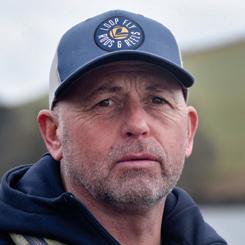
Russ Owen
A successful loughstyle competition angler and former World Champion. Team member of the Welsh Hawks and manager at Llyn Clywedog Reservoir.
D www.clywedogtroutfishing.co.uk



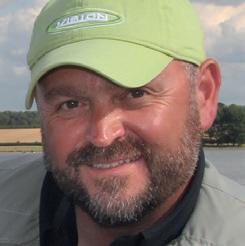

Rob Redman
A sea trout guide from north West Wales. Even though his passion is fly fishing for sea trout he is equally at home also fishing for salmon, grayling, and brown trout.
D Instagram: @rob_redman_sewinstalker_
Alun Rees
Alun is a lifelong angler and an accomplished fly tier. His primary passion is Sea trout but is equally at home chasing Salmon, Trout, Grayling and Saltwater species. He is currently Head of Assessors for GAIA.
M sewinangler@gmail.com
Steve Smalley
Steve started on rivers in the northwest of England before moving on to small stillwaters and reservoirs. He is a member of the The Ospreys and is an ambassador for Vision Fly Fishing UK.
Sean Thomas
Innovative fly angler Sean fishes for wild browns, grayling and bass around his home in South Wales. However, his true passion is sea trout fishing at night.
D www.seanthomasflyfishing.com
Tried and Tested
Our team at Flyfishing spend a lot of time on the water, so who better to take some of the latest fly fishing products out with him and put them through their paces?

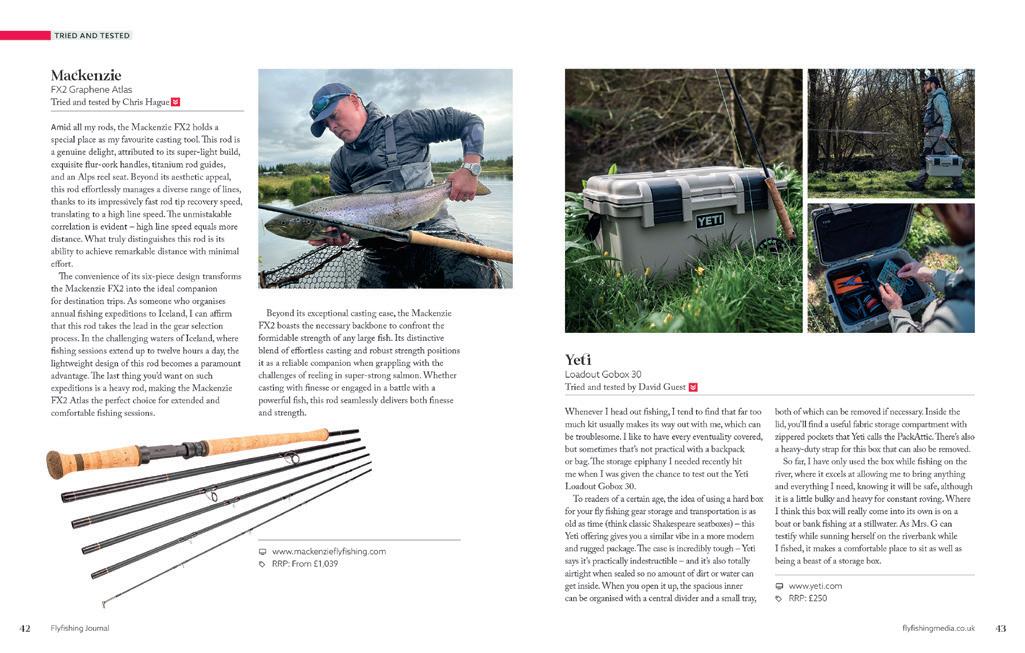
flyfishingmedia.co.uk
you would like
product reviewed
ceri@flyfishingmedia.co.uk www.flyfishing media.co.uk
If
your
by our experts and featured in Flyfishing Journal, please contact Ceri Jones at
89
Guides Directory
Lyn Davies
Capturedonline P Swansea
Professional casting instructor and accredited fly fishing guide for sea trout, brown trout, grayling and rainbow trout throughout South Wales and the borders. GAIA member/DBS checked.
M lyn@capturedonline.co.uk
D www.capturedonline.co.uk
Brett O’Connor
Brett O’Connor Fly Fishing P Stockbridge
Brett’s fascination with the sport has led him to fish all over the world. He specialises in both fly-casting and flyfishing tuition. This can range from a two hour one-toone lesson, to a group session or even a group day out.
M bretto_connor@mac.com
D www.brettoconnorflyfishing.com
Lee Watts
Lee Watts Fly Fishing P Neath
I regularly fish the river Neath along with the rivers Usk, Wye and Tywi. I also fish the Llyns and reservoirs of Brecon Beacons National Park. I am an AAPGAI and FFF qualified instructor and an Orvis Endorsed Guide.
M info@leewattsflyfishing.co.uk
D www.leewattsflyfishing.co.uk
Stewart Collingswood
Alba Game Fishing P North Berwick
Alba Game Fishing, established in 2004, is the only company to offer fishing throughout Scotland. With a team of 22 professional fishing guides and casting instructors, come and enjoy the experience with Alba.
M stewart@albagamefishing.com
D www.albagamefishing.com
James Curley
James Curley Flyfishing P Elphin
Based in Elphin in the North-West Scottish Highlands, surrounded by a wild and dramatic landscape, James can guide you through the vast array of fishing opportunities to be found here.
M info@jamescurley.org
D www.jamescurley.org

Justin Connolly
Justfishin P Abergavenny
As a professional game angling instructor and guide, I enjoy sharing beautiful surroundings with individuals or groups who wish to learn or improve their fishing or casting skills in a safe and controlled environment.
M justin@justfishin.co.uk
D www.justfishin.co.uk
Craig Barr
Craig Barr Flyfishing P Oakham
An England International and England Youth Team Coach. He is a fly fishing guide on both Rutland and Grafham Water.
M craig@flashattackflies.com
D www.flashattackflies.com
Stuart Ray
P Between West Yorkshire and Tyne and Wear
Stuart is an AAPGAI instructor specialising in Atlantic Salmon fishing and Spey casting techniques. Instructor and guide at The Northern Fishing School, and instructor with The North East Fly Casting Club.
M drsturay@icloud.com
D www.northernfishingschool.com
Jackie Mahon
Jackie Mahon Flyfishing P Grange Sligo
A fly fishing guide and a fly tyer located on the west coast of Ireland where he guides full time on Lough
Arrow and Lough Melvin.
M mahonjackie@gmail.com
D www.jackiemahonfliesandguiding.com
Flyfishing Journal 90
To be featured in our Guides Directory contact: M editorial@nousmedia.co.uk
SAM MACDONALD SCULPTOR
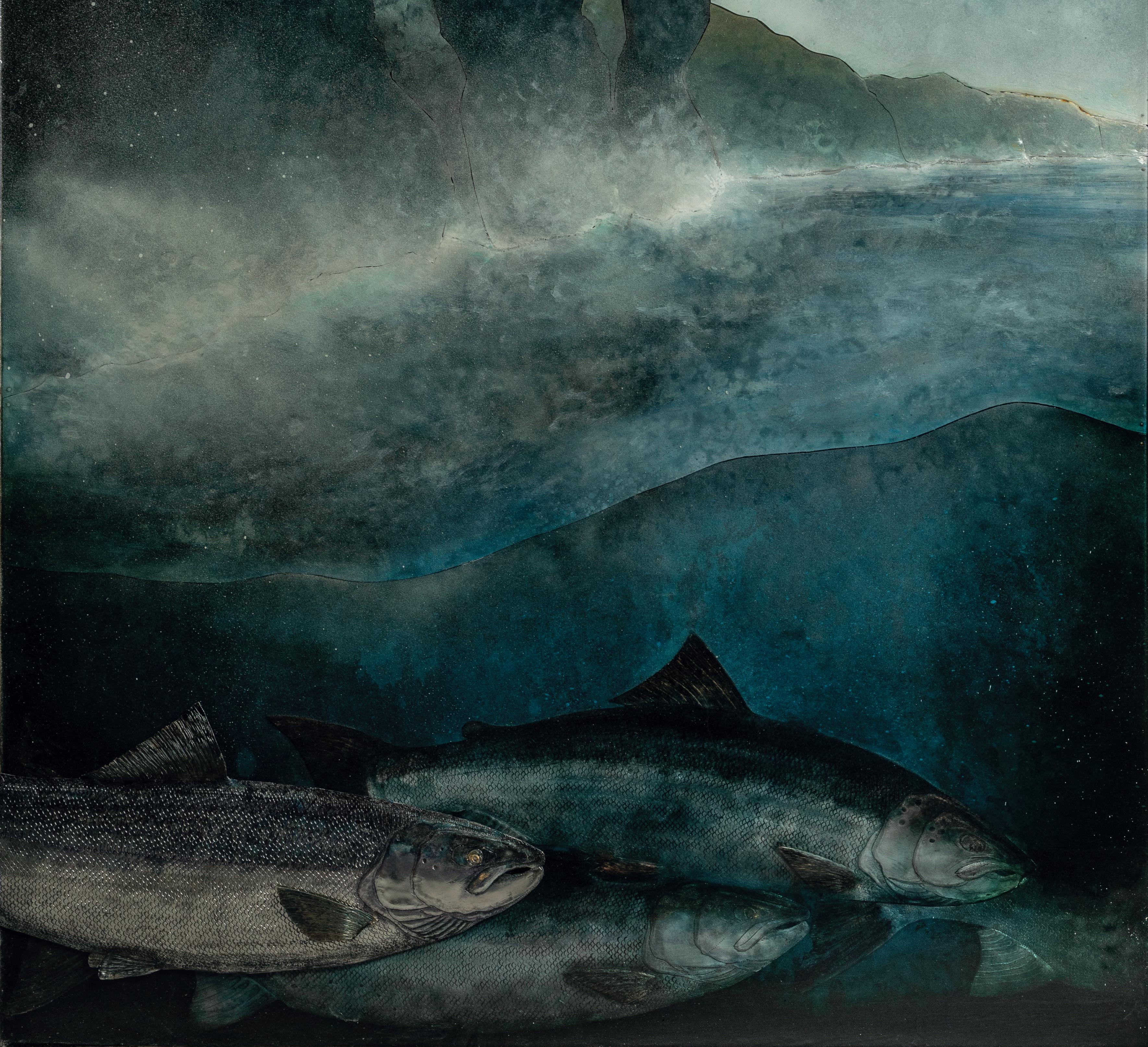
Sam MacDonald, who now lives in East Lothian, grew up on the Isle of Lewis and, after 4 years at Camberwell School of Arts and Crafts training in Silversmithing and Metalwork, lived on Orkney for 19 years and in Perthshire for 10. This enabled his love of fishing, diving and the sea to combine with his developing skills in metalwork. Sam uses old, traditional metal work techniques to produce contemporary and unique works. He creates impressions of fish, using the tactile effects that metal, its processes and techniques have to offer.
If you are interested in commissioning an artwork or finding out more about where Sam exhibits please get in touch:
J 07711 825 931
M s.macdonald54@yahoo.com
sammacdon /SamMacDonaldfish

flyfishingmedia.co.uk
WWW.SAM-MACDONALD.CO.UK
SAM MACDONALD SCULPTOR

www.flyfishingmedia.co.uk


























































































































































































































































































 WORDS & PHOTOS: David Guest
WORDS & PHOTOS: David Guest















































































 Duncan’s second yellowfish of the trip.
Duncan’s second yellowfish of the trip.









































